- Balloon Ride
- Premium Apartments


Yacht Rental Doha
There’s no better place to enjoy and relax with your family than yachts from Asfary’s yacht rental services. Feel the comfort of your home, with top-class service as you boat past the still waters of the pearl to the waves of the Qatari sea. Whether you’re setting up for a cozy family trip or a party with your close friends, the yachts come with 5 bedrooms, 1 hall and its own kitchen to meet your needs. Yacht rental in Doha has never been this easy, affordable, and convenient – book one for your adventure now!
No Packages Found
- You will receive a confirmation email and voucher instantly after booking
- In the event that you do not receive an email from us, please check your Spam folder or notify us via email on [email protected]
HAVING TROUBLE BOOKING ONLINE
Do not hesitate to give us a call. We are an expert team and we are happy to talk to you.
- mail [email protected]
- call (+974) 5543 4313
Subscribe and be the first to know
- Vendor Registration
- Terms & Conditions
- Privacy Policy
- Yacht & Boat
pin_drop Address

- Desert Safari
- Water Activities
- Sightseeing
- Dhow Renting
- Vacation Packages
- HIA Transfer

Qatar International Tours
Leisure With Pleasure
QATAR INTERNATIONAL TOURS
Dhow cruise doha with bbq, duration : 4 hours, the price : ر.ق 300.00, start location: box park, doha corniche, total seats : 25 /25.
Buy min 5 for ر.ق 600.00 /each
Buy min 10 for ر.ق 400.00 /each
Buy min 15 for ر.ق 350.00 /each
Buy min 20 for ر.ق 300.00 /each
Buy min 25 for ر.ق 250.00 /each
Make your booking
Quantity :
Total :
Dhow Cruise Doha: A Timeless Voyage Through Opulence and Tradition
Set sail on a mesmerizing journey, aboard our authentic wooden Dhow, which seamlessly weaves the grandeur of yesteryears with today’s luxuries. Our Dhow Cruise Doha is more than just a ride; it’s an experience that captures the essence of Qatar’s rich maritime heritage and the splendor of its azure waters.
Constructed with painstaking attention to detail, our Dhow stands as a testament to the craftsmanship of ancient Bedouin boat builders. Its intricate decor reverberates with tales of age-old traditions, offering a setting that is both regal and deeply rooted in Qatari culture.
From the moment you step aboard, our amiable crew greets you with heartfelt warmth, ensuring that every moment of your voyage is swathed in comfort. For those with a penchant for adventure, the shimmering waters beckon. Dive into its refreshing embrace, or, if snorkeling piques your interest, bring along your gear to unveil a world of marine wonders. If relaxation is your calling, let the sun’s golden rays cradle you, painting your skin with a sun-kissed glow.
As shadows lengthen, a culinary symphony takes center stage. Relish in a bountiful buffet, curated with the finest ingredients. Each dish, a palette of flavors, promises to tantalize your taste buds and elevate your dining experience.
Our Dhow Cruise Doha is not merely about sailing; it’s an immersive journey where the whispers of the past meet the comforts of the present. It’s a dance of culture, luxury, and nature, set against the backdrop of Doha’s serene seascape.
Come, allow the gentle sway of our Dhow to serenade your senses and etch memories that stand the test of time. Book your seat on this exquisite journey and relish a day where tradition and opulence sail hand in hand.
Places You’ll See :
1 doha corniche, what to bring, pickup location.
Water Taxi 1 at the pearl Qatar
Doha corniche
Terms And Conditions
- Gathering at Pearl-Qatar, Water Taxi PA-1 (25.364892, 51.540885).
- Booking should be 24hours in advance with payment.
- The boat capacity is 45 guest which is including adults & children. We can provide more than one boat at a time when it’s required.
- Children should be accompanied by parent / adult.
- Due to any unfavorable weather conditions, the tour can be rescheduled to another day. (it will be notifying you 24hours in advance in case of any warning)
Cancellation and Refund Policy
- Tour Reservation: By making a reservation for the tour, you agree to the following terms and conditions. The tour is a sharing tour, and as such, you may be joined by other guests during the trip.
- Cancellation and Refunds: Please note that the tour is non-cancelable and non-refundable. Once the reservation is confirmed, no cancellations or refunds will be granted under any circumstances, including but not limited to personal reasons, illness, or unforeseen circumstances.
- Sharing Tour: The tour is designed as a sharing tour, meaning that you may be accompanied by other guests during the trip. The number of guests may vary and is subject to availability. You acknowledge that you may be sharing the tour with individuals who have booked separately, and you agree to respect the privacy and enjoyment of all guests during the tour.
- Itinerary Sharing: As part of the sharing tour experience, you may share the full itinerary with other guests. This includes details such as tour activities, locations, and timings. By participating in the tour, you agree to share the itinerary with other guests as requested or required.
- Liability: We strive to provide a safe and enjoyable tour experience. However, we cannot be held responsible for any loss, damage, injury, accident, delay, or inconvenience that may occur during the tour. You participate in the tour at your own risk and agree to release us from any liability arising from such incidents.
- Conduct: You agree to conduct yourself in a responsible and respectful manner throughout the tour. We reserve the right to refuse service or remove any guest from the tour who engages in disruptive, abusive, or illegal behavior without refund or compensation. By making a reservation for the tour, you acknowledge that you have read, understood, and agreed to these terms and conditions in their entirety.
What's Included
- Dhow Cruise
What's Excluded
- Transportation
Location Map
Why Book With Us?
- Unbeatable Price Guarantee in Qatar
- Exceptional Quality Services
- Professional Desert Safari Drivers Certified and Skilled
- Comprehensive Off-Road Insurance for Every Client
- Luxury Service in State-of-the-Art SUVs
Got a Question?
- Do not hesitate to give us a call. We are an expert team and we are happy to talk to you.
- 97444553954
- [email protected]
Review Form
Please provide your feedback below
How do you rate to the this tour?
You may like Tour
Qatar kayaking tour, water sports at al safliya island, unlock your journey, book with us.

Established in 1999, QIT offers unforgettable vacations, tailored packages, and exceptional service. Explore the essence of Arab culture, history, and hospitality while enjoying our professional, safe, and customized tours. Experience the best of Qatar with us!
TRAVELERS' CHOICE AWARD
Verified e-commerce, multiple payment options.

©QITTOUR.COM 2015. ALL RIGHTS RESERVED
Qatar's premier tour operator 1999, insert/edit link.
Enter the destination URL
Or link to existing content
Sign up and
GET 20% OFF
Your first boat rental
Welcome to Sailo !
Your code is:
Enjoy 20% off
- Explore boats
- Text (910) 447-2456 Call (910) 447-2456
Departure date
Trip duration, multiple days (less than 1 week), weekly trip show boats that have weekly prices. most weekly boats outside of the us are available only saturday to saturday., boat length: 5ft -, manufacturer, boat build year: -, weekly trip, price: $ - $, no boats found, to see more results try changing your dates, moving the map, or removing your filters, doha, qatar - a yachting playground perfect to explore with sailo, learn how to find the best boat for you, how much does it cost to rent a yacht in doha, qatar for a day, can i rent a boat without a captain (bareboat) in doha, responsible boating guidelines.
- Take your rubbish home
- Use eco-friendly sunblock
- Avoid single use plastic
- FAQ and Policies
- Accessibility Statement
- Boat Rentals
- Boat Calculator
- Discover Boating
- Community questions
- Referral Program
- Vivre: Furniture & home decor
- British Virgin Islands
- La Paz, Mexico
- Cabo San Lucas, Mexico
- Key Largo, FL
- St. Vincent and Grenadines

- +974 3019 1237
Book Yacht in Qatar

Rent your Private luxury Yacht in Qatar
Experience the epitome of luxury with our Private Yacht Cruise, a journey that promises opulence, adventure, and relaxation. Set against the backdrop of Qatar’s glistening waters, this all-inclusive yacht tour invites you to revel in every moment at sea, tailored to your desires. Indulge in the ultimate maritime experience and book a Yacht in Qatar . Cruise along the stunning coastline, host events, or simply unwind in style. Your dream voyage awaits.
Whether it’s a family getaway, a corporate retreat, or a unique wedding celebration, our private yacht cruise caters to your dreams. The yacht is exclusively yours for the chosen duration, granting you the freedom to craft your experience. Set sail from the picturesque Pearl Harbour and embrace the enchanting surroundings as the sea becomes your playground.
Luxury with Our Italian Yacht Tours in Qatar
Our Italian luxury yacht boasts both an air-conditioned indoor seating area and an open-air space for sun-soaked relaxation. Dive into the open ocean, disembark on the serene Al Safliya Island, and engage in thrilling water sports (an option you can add on top of your rent). Opt for our extras, including jet skiing, banana boat rides, and doughnut rides, to infuse your voyage with excitement.
Indulge in a traditional Arabic barbecue dinner aboard the yacht, an option that takes your journey to new heights (paid extra). Choose your yacht size – the smaller accommodates 7 passengers, while the larger accommodates up to 10 and the much larger ones can take up to 60 pax. Book a Yacht in Qatar and set sail on a breathtaking adventure. Contact us whether it’s a private event or a leisurely cruise, reserve your yacht experience today for unparalleled maritime indulgence.
- Luxurious yacht experience, offering a refined sailing encounter.
- Option to partake in jet skiing, banana boat rides, and doughnut rides (extra charges apply).
- Insurance coverage for a worry-free voyage.
- Refreshments of water and soft drinks to keep you hydrated.
- Convenient bathroom facilities available on board.
- Transportation to the meeting point is not included.
Terms & Conditions
Cut off Time:
Terms & Conditions:
The experience is subject to weather conditions and may be cancelled if the weather conditions are unfavorable.
Booking is only confirmed if the payment is made in advance. For group bookings, please reach out to our customer service to find a suitable discount for your group. If you are an influencer, please reach out to [email protected] in an email with your media kit to see how we can collaborate on this tour with you.
1 pax = 1 Adult or Child on seat
Each boat takes 30 pax maximum. For bigger groups, up to 6 boats can be arranged.
For team building experiences on the boat, please check our team building packages in Qatar on our website.
Cancellation and No show Policy
- 72 Hour prior to arrival : No Charge applies
- 72 to 48 hours prior to arrival : 50% of the total booking cost
- Less than 48 hours & No show : 100% of the total booking cost
Tour Amendment Policy
- 48 Hour prior to arrival : No Charge applies
- 48 to 24 hours prior to arrival : 25% of the total booking cost
- 24 to 12 hours : 50% of the total booking cost
- Less than 12 hours : 100% of the total booking cost
- Embark from the Pearl Harbour and sail into the Arabian waters aboard our majestic yacht.
- Enjoy air-conditioned comfort indoors or bask in the sun on the open-air seating and tanning area.
- Dive into the open ocean, disembark on the tranquil Al Safliya Island, and embrace the adventure.
- Experience the thrill of jet skiing, banana boat rides, and doughnut rides (extra charges apply).
- Savor a sumptuous traditional Arabic barbecue dinner aboard the yacht (extra charges may apply).
- Select your preferred yacht size – accommodating 7 or up to 60 passengers.
Start Times
Timings are flexible for yacht tours though we recommend a sunset cruise starting at 5PM
Minimum 2 hours, maximum 7 hours. For longer bookings, please contact us.
- Meeting Point: The Pearl Qatar.
- Duration: Minimum 2 hours, and as long as you desire.
- Start Time: Times are flexible based on your preference. Recommended timings vary throughout the year.
- Travel Time: Not applicable.
Bring on Board
- Comfortable sandals, sunscreen, and sunglasses for a pleasurable voyage.
- Snacks to enhance your experience on board. We’ll provide bottled water.
- Capture the memories with your camera, ensuring these moments last a lifetime.
The yacht cruise was a dreamy escape – pure luxury
A day of utter opulence and tranquility. Every moment was perfect!
An absolutely divine experience – sailing on the yacht was enchanting!
A day of complete serenity on the water. The yacht cruise is a must!
Your email address will not be published. Required fields are marked *
Save my name, email, and website in this browser for the next time I comment.
Book This Tour
Please enable javascript in your browser to book
You may like

- Amenities 5

Last Minute Deals

Experience Qatar: Redefining travel through excellence, authenticity, and personalized service, creating unforgettable moments in Qatar’s captivating wonders while promoting sustainability and supporting local communities.
Office # 315, 3rd Floor, Ace Business Center, Building # 8, Al Rawabi Street, Doha, Qatar
[email protected]
All Tours are Operated by Experience Tours for Tourism Services LLC, Licensed by Qatar Tourism
- Privacy Policy
- Refund Policy
WhatsApp us
Download Our Tour Book
Ut enim ad minim veniam, quis nostrud exercitation ullamco laboris nisi ut aliquip ex ea commodo consequat. Duis aute irure dolor in reprehenderit in
+ 844 1755 – 444 11

Yacht Rental Doha

Want to explore everything Doha has to offer? You need to consider yacht rental Doha. Take advantage of a crew-chartered yacht and spend the day out at sea. If you want to enjoy the finer things in life, Dubriani has you covered. Set sail and have the time of your life. The stunning waterfront is best covered on a yacht. The experience is unlike any other. Dubriani has quickly become a well-known name in the gulf region for luxury yachts. Choosing our yacht service guarantees an amazing time.
Whether it is your first time visiting Doha or you are a resident of this gorgeous city, you have to hop on a yacht to find out more about the city. It is important that you stick to Dubriani for a stress-free experience. We take care of everything and truly care about you. Our friendly crew will respond to all your requests and be there for you.
Doha Yacht Charter
When you book a yacht charter Doha with Dubriani, you get to have an all-inclusive experience. We will satisfy all of your needs and ensure that you have the time of your life. There is no better way to relax and reboot. After all, you will get to sit back and enjoy the ride. Our crew will go above and beyond for you so that you don’t have to worry about anything. If you have always wanted to be treated like royalty, our Doha yacht rental service is just what you need. It’s about time that you splurged on the ultimate experience. All you have to do is let us know what your requirements are and we will take care of the rest.
With our crew ready to respond to all your requests, you could not be in better hands. We cater to everything your heart desires. Choosing our all-inclusive yacht rental Doha is possibly the best decision that you can make. Our goal is to be there for you at all times. Feel free to let us know whatever we can do for you.

Eclipse 65 Jacuzzi

Majesty 121 Jacuzzi
30m (121 ft)

Azimut 85 VIP
26m (85 ft)

Dominator 95 VIP

Custom Line 115 VIP
35m (115 ft)
Sea a Different Side of Doha
There is more to Doha than meets the eye. The cosmopolitan capital of Qatar has to be explored on water. It will open up your eyes to the beauty of the city and everything it has to offer. Watch how the Bedouin heritage and modernity come together to offer a feast for the eyes. Spend a few hours or an entire day getting acquainted with the city. Take your holiday to the next level with Dubriani. We always deliver an impeccable service.
The impressive architecture comes to life when you are on a yacht. With new infrastructure being constantly added, you have to hop on board to see everything Doha has to offer. The traditional mosques, unique structures, and modern skyscrapers come together to provide a unique perspective on the country. Besides, each marvel is a work of renowned architects. There is a reason why yacht rental Doha is in high demand. If you want to go on a special journey, you have to book our yacht for an hour or more. We even provide monthly packages to ensure that you get to continue enjoying the pearl.
#1 Yachting Specialist in Doha
Only when you see Doha on the water will you get a glimpse into what makes the city so special. People flock to the city with the brightest dreams and add a unique character to it. The capital has undergone massive development over the years and has become a beacon of hope for the region.
- Hourly Charter
- Experienced personnel
- 5 Star overnight accommodation and service on board
- Welcome drinks and house beverages served onboard
- Relaxing onboard experience
Optional Catering packages available from famous restaurants and private chefs.
From the marina waterfront to the old town, Doha is a city that is always bursting with life and the best way to experience its energy is on a yacht. This is why it makes sense to book our yacht charter. It will ensure that you and your friends see Doha from a different perspective.

Yachting in Doha
Bring out your adventurous side with Dubriani. Our yacht charter Doha ensures a thrilling experience. We don’t compromise on luxury and allow you to visit a number of locations within a short period of time.
There is a lot more to Doha than meets the eye. When you rent a yacht in Doha , you will get to visit only the best places and take in their beauty from afar. Now, you can check out all the notable spots while relaxing on a spectacular luxury yacht.
Anyone who loves adventure and trying new things has to ride a yacht at least once during their time in Doha. It is an experience that will transform your outlook on life.
Sometimes, you have to do something different to get a taste of everything life is about. Seeing Doha on the water will put you in the right state of mind.
Get a well-organized event on a yacht
We offer all-inclusive, fair, and transparent services. Most of our luxury yachts charge one set hourly rate. Hidden fees don’t exist, and no additional fee is taken by our crew.
Romantic Dinner
" * " indicates required fields
Customized Service
What makes our yacht rental Doha incredibly popular is that we provide a completely personalized service. This means that we provide a pre-planned itinerary. You get to decide your schedule. Whether you book our Doha yacht rental for an hour or an entire day, we will customize the experience so that all of your needs are satisfied. We take great pride in knowing that our clients are always delighted by our service. If you have any special requests, you can let us know and we will make sure that they are met.
With a dedicated crew by your side, you will not have to stress about anything. We will make sure that you get to relax and have fun. You will not even realize how fast time goes. This is why our service is highly recommended. It doesn’t matter how many days you might be visiting Doha. You have to give our yacht rental a try.
Frequently Ask Questions
The price of our chartered yacht may vary based on the package you choose, there are options for hourly and daily yacht rental.
Yes, we accept crypto payments.
Offer the Best Rates in Doha
At Dubriani, we want to make sure that visitors and residents of Doha get to enjoy the stunning waters on a yacht. This is why we provide only the best rates. If you are looking for an economical option, we have you covered. When you consider the exclusive benefits and features, you will come to realize that our yacht rental Doha is as good as it gets. We offer outstanding facilities and amazing exclusivity. Take charge of your life with our service. We offer a relaxing atmosphere that is out of this world.
Host a private or corporate event for a cost-effective price when you choose Dubriani. The sights and sounds as well as the hospitality are unrivaled. We make sure that your event is a success. All you have to do is let us know what you want and we will help provide an accurate quote so that you can book our service. It is important that you understand that our service is all-inclusive and you can inform us if you have any additional requirements. Even if you are on a tight budget, you can rely on us to have an unforgettable experience. We will customize the package so that you get to enjoy the best rates.
Remember Me
Book with Whatsapp
- Boat & Catamaran Charter
- Charter by Country
- Charter by Regions
- Explore Cruise Deals
- Find Inspiration
(+1) 786 673 68 20

Boat & Catamaran charter in Doha - Yacht Rental
Doha yacht rental.
Doha, the dazzling capital of Qatar, serves as the perfect gateway to the Persian Gulf’s vast and enchanting waters. A blend of tradition and modernity, Doha offers sailors an unparalleled experience, complete with awe-inspiring skyscrapers, historical landmarks, and sun-kissed seascapes. At Yachting.Rent, we specialize in turning this fascinating geography into a customized luxury yachting adventure that you’ll remember for a lifetime.
Our fleet in Doha consists of a wide range of world-class yachts that cater to all tastes and occasions. Whether you’re looking to celebrate an event in grand style, escape on a romantic getaway, or simply experience the city from a unique vantage point, we have a yacht that will suit your needs.
Here’s what makes yacht rental in Doha with Yachting.Rent so special:
Diverse Water Excursions : From a tranquil cruise along the Corniche to an exciting expedition to the nearby islands, our yachts offer numerous possibilities. Explore Banana Island’s resort-like amenities or venture to Al Safliya Island for a peaceful retreat.
Luxury and Comfort : Our yachts are equipped with modern amenities, sumptuous interiors, and professional crew members dedicated to ensuring that your journey is both pleasurable and luxurious.
Tailored Packages : Every rental is crafted to your exact specifications. Whether it’s a family outing, a corporate event, or a private celebration, we tailor the experience to fit your preferences and budget.
Cultural Exploration : Doha’s rich cultural heritage is reflected in its coastal landmarks. Sail past the Museum of Islamic Art or the iconic Pearl-Qatar. Experience the local cuisine, vibrant markets, and traditional dhow boats that still grace the harbor.
Water Sports and Recreation : Thrill-seekers can enjoy jet skiing, snorkeling, or diving. Our yachts come with the option of adding water sports equipment for those who wish to add a bit more adventure to their journey.
Sunset and Night Cruises : Witnessing Doha’s skyline illuminated at dusk or twinkling under a starlit sky is a mesmerizing experience. Our sunset and night cruises are designed to capture these magical moments.
Accessibility and Convenience : Situated in a prime location, Doha is easily accessible by international travelers. With our flexible booking options and dedicated support, arranging your yacht rental is hassle-free.
At Yachting.Rent, we believe in transforming ordinary sailing into an extraordinary journey. We pride ourselves on our attention to detail, our commitment to quality, and our ability to create unforgettable experiences.
Doha’s unique combination of urban sophistication, cultural richness, and natural beauty, coupled with our exceptional service, promises a yachting experience that transcends the ordinary. Whether it’s a day cruise or a multi-day charter, Yachting.Rent in Doha stands ready to welcome you aboard. Embark on a voyage that will both soothe and stimulate your senses, and discover the Gulf’s hidden treasures with us.
Daniel Goldman
CEO of Yachting.Rent
Boat & Catamaran charter in Doha

Bali 4.5 – 4 + 2 cab. – Adria Chicha – 2017

Lagoon 450 F – 4 + 2 cab. – Shiva – 2018

Lagoon 42 – 4 + 2 cab. – Hanselli – 2024
Lagoon 42 – 4 + 1 cab. – pirelli – 2024.

Saxdor 320 GTC – Olivia – 2022
Saxdor 320 gto – kali – 2022.

Why Choose Us
Yacht charter in Doha
Experience the luxury, excitement, and sheer freedom of chartering a yacht in the magnificent coastal city of Doha with Yachting.Rent. Our expertly curated yacht charter services offer you an unforgettable journey along the mesmerizing shores of the Qatari peninsula, imbuing your voyage with charm and splendor.
Yachting.Rent presents a diverse fleet of premier yachts, perfect for every kind of maritime adventure. Whether you’re seeking a high-speed cruiser for an adrenaline-filled day on the waves, a luxury yacht for a refined evening under the stars, or a multi-day expedition around the Gulf, we have the perfect vessel waiting for you.
Our yachts are maintained to the highest international standards, ensuring your safety and comfort during every moment of your journey. They are furnished with all the amenities necessary to guarantee an unforgettable experience, including plush accommodations, fully equipped kitchens, and expansive deck areas perfect for soaking up the warm Doha sun. Each vessel is designed to give you the most seamless and enjoyable yachting experience possible.
With Yachting.Rent, you don’t need to be an experienced sailor to enjoy the allure of the sea. Our crewed charter options come with a professional and friendly crew that will handle navigation, ensure your safety, and even cater to your onboard needs. Whether you want to try your hand at sailing under the watchful eye of an experienced captain or simply sit back and relax, we’ve got you covered.
Embarking on a yacht charter in Doha allows you to experience the city’s majesty from a unique vantage point. You’ll have the opportunity to discover secluded beaches, explore vibrant coral reefs, and gaze upon the city’s skyline as it’s illuminated at dusk. Each day on the water is a new opportunity to experience something extraordinary, and with Yachting.Rent, the horizon is yours to explore.
For those seeking a truly immersive experience, our yachts are available for multi-day charters. Imagine waking up to the gentle rocking of the sea and diving into the crystal-clear waters before breakfast, or sipping on a refreshing drink while watching the sun melt into the horizon. With a yacht charter, you set the pace and choose your path, providing a level of freedom and luxury that few other experiences can match.
Whether you’re celebrating a special occasion, planning a romantic getaway, or simply want to experience the thrill of sailing, a yacht charter with Yachting.Rent in Doha is an unforgettable adventure that’s sure to exceed your expectations. Embark on a journey with us and discover the magic and mystery of the sea.
Satisfield Clients
Experiented Crew
Luxurious Boats
Premium Facilities
Featured Boats & Catamarans in Doha

Philippinen (1)

Fill out the form to rent the perfect boat for your needs
Name (required)
Phone (required)
Email (required)
Destination (required) Argentina Australia Bahamas Bali Belgium Belize Brazil British Virgin Islands Bulgaria Canada Cambodia Cape Verde Caribbean Chile Colombia Costa Rica Croatia Cuba Cyprus Denmark Dominica Dominican Republic Ecuador Egypt El Salvador Fiji Finland France French Polynesia Greece Grenada Guatemala Germany Hawaii Hong Kong Hungary Iceland India Indonesia Ireland Israel Italy Jamaica Japan Jordan Madagascar Maldives Malaysia Malta Mauritania Mauritius Mexico Monaco Montenegro Mozambique Nicaragua Netherlands New Caledonia New Zealand North Macedonia Norway Oman Panama Paraguay Philippines Poland Portugal Qatar Romania Saint Lucia Samoa San Marino Senegal Seychelles Singapore Slovenia South Africa Sri Lanka Spain Sweeden Switzerland Tanzania Thailand Turkey United Kingdom United States United Arab Emirates Venezuela US Virgin Islands Vietnam
Boat type Sailboat Catamaran Motorboat Power catamaran Gulet
Why is Doha a good sailing destination?
Doha, the vibrant capital city of Qatar, has swiftly emerged as an exciting sailing destination that offers something unique for every sailor. Yachting.Rent is proud to bring the wonders of Doha’s waters closer to you, providing luxury yachting experiences tailored to match your desires.
The striking city skyline, punctuated by innovative architectural marvels, creates a breathtaking backdrop for sailing adventures. The calm and warm waters of the Persian Gulf invite exploration, whether you wish to indulge in a leisurely cruise or take part in thrilling water sports.
Doha’s harbor, lined with a fascinating fusion of traditional dhow boats and ultra-modern yachts, opens a window into the city’s rich maritime history. The famous Corniche provides an idyllic path for sailing, with spectacular views of the cityscape and numerous opportunities to anchor and explore the nearby islands.
For those who seek a more serene experience, the natural wonders of Banana Island and Al Safliya Island are only a sail away. Here, unspoiled beaches, world-class resorts, and opportunities for snorkeling and diving await.
What sets Doha apart is not just its visual splendor but the range of experiences that can be crafted around your sailing adventure. You can pair your voyage with a tour of the world-renowned Museum of Islamic Art or a shopping spree at the bustling Souq Waqif. Gastronomic delights are plenty, and Doha’s culinary scene offers an enticing array of international and local flavors to satisfy all palates.
The strategic location of Doha makes it an accessible destination for international travelers, and its state-of-the-art marinas and facilities ensure that your yachting experience is nothing short of luxurious.
With Yachting.Rent, every detail is taken care of, from customizing your itinerary to providing professional crew and world-class amenities onboard our fleet of premium yachts. Our commitment to quality and personalization ensures that your time sailing in Doha becomes a cherished memory.
In essence, Doha offers an unparalleled blend of urban sophistication, cultural richness, and natural beauty that makes it a compelling destination for sailing. Its multifaceted appeal caters to both the adventurer and the leisure seeker, and with Yachting.Rent, you have the freedom to explore Doha’s coastal wonders in style and comfort. Whether you’re embarking on a romantic getaway, a family vacation, or a corporate retreat, Doha’s vibrant shores promise a sailing experience that’s as diverse and dynamic as the city itself.

gallery-large

What Choose
Sailing boat or Catamaran, what to sail in Doha
Discover the alluring coastline of Doha from a unique perspective with Yachting.Rent. We offer both sailing boats and catamarans for rent, providing you with an array of options to match your sailing preferences and the kind of experience you wish to indulge in.
Our sailing boats are the ideal choice for those who seek a more traditional and adventurous seafaring experience. Feel the rush of the wind in your sails and the responsive touch of the helm under your hand as you cut through the waves, experiencing the excitement of sailing in its purest form. A sailing boat charter offers an intimate, hands-on sailing experience that’s perfect for adventurers and sailing enthusiasts alike.
Alternatively, if you’re looking for stability, spaciousness, and a heightened level of comfort, our catamarans are the perfect choice. With their twin-hull design, catamarans provide exceptional stability, making them an excellent option for families or those who prefer a more relaxed, laid-back sailing experience. The expansive decks and cabins of our catamarans offer ample space for relaxation, socializing, and even hosting events or parties on board.
Both our sailing boats and catamarans are equipped with all the amenities you may need for a comfortable journey. This includes fully furnished cabins, well-equipped kitchens, and plenty of space for sunbathing or enjoying a meal under the stars.
Doha’s coastal waters are perfect for both types of vessels. Whether you’re exploring the city’s beautiful skyline, cruising around the stunning nearby islands, or dropping anchor to enjoy some water activities, your journey will be unforgettable.
Yachting.Rent also offers crewed charters for those who prefer to leave the navigation to professionals and simply soak up the sun and enjoy the ride. Our skilled and friendly crews are committed to ensuring your safety, comfort, and enjoyment throughout your journey.
So, sailing boat or catamaran? The choice is yours to make. Both offer unique experiences that are sure to create lasting memories. Whether you’re an experienced sailor, an adventure seeker, or someone seeking a relaxing holiday, Yachting.Rent in Doha has the perfect option for you. Begin your journey with us and set sail towards an experience like no other.
Find inspiration for your next holiday

Doha City Tours: Exploring Qatar's Capital and Its Maritime Heritage

Desert and Sea: Combining Sailing and Desert Adventures in Qatar

Island Escapes in Qatar: Sailing to the Pearl-Qatar and Banana Island

Qatari Cuisine Afloat: Tasting Local Delicacies and Fresh Seafood on Board
Check out sailing destinations by regions.
- The Pearl-Qatar
- Ras Laffan Industrial City
- Al Ghariyah
- Al Thakhira
- Al Jassasiya
- Al Wakra Marina
- Abu Thaylah
Check out our favourite sailing destinations
- British Virgin Islands
- Dominican Republic
- El Salvador
- French Polynesia
- Netherlands
- New Caledonia
- New Zealand
- North Macedonia
- Philippines
- Saint Lucia
- South Africa
- Switzerland
- United Kingdom
- United States
- United Arab Emirates
- US Virgin Islands
Our Offices
Miami Beach Marina 300 Alton Road Miami Beach, Florida 33139
Ground Floor 8-9 Marino Mart Fairview Clontarf, D03 X589 Dublin
Ground Floor 8-9 Marino Mart Fairview Clontarf, D03 X589 Dublin, Ireland
(+1) 786 673 6820
- Motor yachts
- Sailing yachts
- Sport fishing
- Safety & Security
- Terms of Use
Quick Links
- Bill of Rights
- Environment
Please use a modern browser to view this website. Some elements might not work as expected when using Internet Explorer.
- Why Charter Homepage
- Luxury Yacht Vacation Types
- Corporate Yacht Charter
- Tailor Made Vacations
- Luxury Exploration Vacations
- ALL 3,597 Yachts For Charter
- Motor Yachts
- Sailing Yachts
- Classic Yachts
- Catamaran Yachts
- Special Offers
- by Destination
- Yacht Reviews
- Destination Guides
- Inspiration & Features
- Mediterranean Charter Yachts
- France Charter Yachts
- Italy Charter Yachts
- Croatia Charter Yachts
- Greece Charter Yachts
- Turkey Charter Yachts
- Bahamas Charter Yachts
- Caribbean Charter Yachts
- Australia Charter Yachts
- Thailand Charter Yachts
- Dubai Charter Yachts
- Destination News
- New To Fleet
- Charter Fleet Updates
- Industry News
- Yacht Shows
- Corporate Charter
- Charter Advice
- Why Use a Yacht Broker
- Charter Costs Explained
- Add my yacht
- Yacht Charter Destinations

- Ideas & Tips
- Itineraries
- See & Do
- Eat & Drink
Guide to Qatar
World-class culture, unique experiences and captivating landscapes
Emerging from the mainland into the Arabian Gulf , Qatar is renowned for its glittering skyscrapers, sophisticated restaurants and its lengthy pristine coastline. Combining old world hospitality with cosmopolitan sophistication, this country is a totally unique yacht charter destination that gives you the opportunity to enjoy many new experiences and adventures.
A distinctive and fast-growing destination, Qatar offers a plethora of fascinating things to see and do that will cater to every type of traveller. From the world-class capital city of Doha to the breathtaking sand dunes that seem to spring from a fairytale, Qatar is home to some of the best hotel brands, restaurants, spas and shops which come together to create an oasis of pleasure and relaxation in the heart of the Middle East.
Doha is the obvious starting point for any trip to Qatar, particularly for lovers of art and architecture. Home to the Museum of Islamic Art which holds the world’s largest collection of Islamic art and the Mathaf, a museum that specialises in international modern art with an Arab connection. Don’t miss the Qatar National Library, even if you’re not in the reading mood, standing in this breathtaking glass-walled spaceship of a building is an experience in itself. The city also provides an extraordinary shopping scene, with exclusive designer shops and gorgeous boutiques dotted around the city. If you’re searching for traditional old-Qatar atmosphere and bustle, head to the Souq Waqif. This market has been in existence for more than 250 years and will give you an authentic, colourful shopping experience.
Qatar also has plenty of spectacular natural landscapes to draw visitors away from the city, with its fair share of gorgeous beaches lining the western coast and spectacular sand dunes surrounding Khor Al Adaid in the south. The country offers unlimited choices for adventure seekers, you can enjoy a desert safari, seeing the undulating sand dunes through your own eyes, ride a camel or paraglide and kitesurf in the picturesque village of Zekreet.
As a peninsula surrounded by the Arabian sea and blessed with year-round sunny weather, Qatar is an ideal location for watersports. Whether you're putting your yacht charters' water toy box to good use or kayaking around the country’s magnificent natural reserves at the Inland sea, there is plenty to keep everyone entertained. If diving is your thing, don’t miss the opportunity to explore Qatar’s marvellous marine life, boat wrecks and limestone formations. Counted among the world’s top pearl diving centres, Qatar is an ideal destination for diving year round.
If it’s relaxation you’re searching for, Qatar is ideal for indulgence, with opulent hotels, decadent spas, glitzy malls and sandy beaches catering to your every demand. Top spas in the area include Six Senses Spa, Remède Spa, Bliss or Sisley Paris Spa, all offering exclusive pampering and treatments that will lure you into a state of relaxation and tranquillity.
Briniging in lots of excitement, a yacht charter around Qatar promises a vacation packed with new experiences, adventure and breathtaking landscapes. If you are interested in a private crewed yachting vacation in Qatar, view all superyachts available for Red Sea yacht charters today and start planning your next vacation with a recommended yacht charter broker .
Start Planning - Speak with a Charter Expert
Our yacht charter experts will:
- Discuss your vacation plans
- Check availability & shortlist suitable yachts
- Negotiate booking & prepare your itinerary
Reasons to Visit
- Marine Life
Need Advice?
Speak to a Charter Broker
Explore Other areas within Red Sea

Guide to Saudi Arabia
Book with Ease - Speak with a Charter Expert
Our charter experts will:
Enquire now for yacht availability & free consultation.
Featured Luxury Yachts for Charter
This is a small selection of the global luxury yacht charter fleet, with 3597 motor yachts, sail yachts, explorer yachts and catamarans to choose from including superyachts and megayachts, the world is your oyster. Why search for your ideal yacht charter vacation anywhere else?

136m | Lurssen
from $4,244,000 p/week ♦︎

115m | Lurssen
from $2,759,000 p/week ♦︎

85m | Golden Yachts
from $959,000 p/week ♦︎

88m | Golden Yachts
from $1,167,000 p/week ♦︎

84m | Feadship
from $1,065,000 p/week ♦︎

93m | Feadship
from $1,485,000 p/week ♦︎

Maltese Falcon
88m | Perini Navi
from $490,000 p/week

122m | Lurssen
from $3,000,000 p/week
As Featured In
The YachtCharterFleet Difference
YachtCharterFleet makes it easy to find the yacht charter vacation that is right for you. We combine thousands of yacht listings with local destination information, sample itineraries and experiences to deliver the world's most comprehensive yacht charter website.
San Francisco
- Like us on Facebook
- Follow us on X
- Follow us on Instagram
- Find us on LinkedIn
- Affiliates & Partners
Popular Charter Regions
- Greece Yacht Charter
- Turkey Yacht Charter
- Virgin Islands Yacht Charter
- Caribbean Yacht Charter
- Bahamas Yacht Charter
- Croatia Yacht Charter
- Seychelles Yacht Charter
- Dubai Yacht Charter
Popular Charter Yachts
- Nirvana Yacht Charter
- Serene Yacht Charter
- O' Mega Yacht Charter
- Big Fish Yacht Charter
- Serenity Yacht Charter
- Kismet Yacht Charter
- 'Alfa Nero' Yacht Charter
- Maltese Falcon Charter
- or try our Name Search Tool
Receive our latest offers, trends and stories direct to your inbox.
Please enter a valid e-mail.
Thanks for subscribing.
Search for Yachts, Destinations, Events, News... everything related to Luxury Yachts for Charter.
Yachts in your shortlist

Where life comes alive in Arabia! Discover unforgettable moments that fill your heart with joy. Embrace the extraordinary, for without 365 Adventures , life’s canvas remains blank, devoid of awe-inspiring brushstrokes.

- No products in the cart.

Sea Adventures
Jump in to the sea to cool-off your summer, adventures at sea – trips and cruises.
Here in Doha Sun and Sand aren’t all we’ve got. Come join us for Adventures at Sea! If you’re tired of being stuck in the city traffic and the same old views from land, these Sea Adventures are just right for you! From tranquil sunset Kayaking to ease your mind of daily stress, Jet Skiing and Speed Boating for the ones looking for an adrenaline rush, Dhow cruise for a whole new perspective of the breathtaking skyline of Doha, and even Fishing Tours! Here is a comprehensive summary of water-sports in Qatar and sea adventures that we offer:
Kayaking in the Arabian Sea
Kayaking in Qatar is available at the Purple Island with 365 Adventures. Enhance your trip with a live BBQ experience. To book your kayaking experience, please click here.
Dhow Cruise
Experience a traditional Qatari wooden dhow cruise and dinner experience with 365 Adventures. Our dhow cruise starts from the pearl harbor (also known as the Dhow Harbor) where we sail towards the natural Safliyah Island, around 45 minutes away on a relaxed cruise from Doha City. Part of our Sea Adventures, book a day on dhow cruise and experience diving from the boat, swimming in the Arabian sea as well as optional swimming. Otherwise, book a private dhow cruise with BBQ experience in Doha city at your convenience. To book your day out on traditional Qatari dhow boat please call 33393323.
Speed Boat Rentals
Rent a Speed Boat in Qatar and enjoy this comprehensive service. Our speed boat rentals can range anywhere between 3 to 8 hours. You will be driven in style by your captain to the deep sea with fishing equipment. Of course, you can fish in the Arabian Sea and catch some Qatari Hamour as well as spot some amazing sea creatures.
Jetski Rentals
Rent a Jetski with us in Doha West Bay area. Craving a cool adventure for sunny mornings and weekends? You have reached the right place. Starting from 500 QAR per hour, we offer exclusive Speed Boat rentals. Call us now so we can also book a ride for you and ensure you have a comfortable adventure.
Yacht Rentals in Qatar
Rent your yacht in Qatar now by calling 3339 3323. Our yachts charter in Qatar offers a luxurious speedy getaway from the city. Sailing from the fabulous man made island in a poche Italian-Arabian luxury setting; our yacht is parked at Porto Arabia at the Pearl Qatar island. Seating capacity of up to 18 pax with bedrooms, TV, mini-bar, front deck and roof-top deck. All safe with life jackets. Book your yacht in Qatar now!
Book your Sea Adventures now with one of our live agents! Simply click the green tab on the bottom right of the web page to start your booking.

Speedboat Fishing

The Pearl Kayaking Experience

SUP for Beginners – The Pearl

Scuba Diving

Speed Boating

Mangroves Exploration Tour – Al Mafjar

Luxury Yacht Getaway

Kiteboarding

Dragon Boating

Wakesurf / Wakeboarding

Pedal Powered SUP

Jet Ski Rental

Kayaking At The Purple Island
USD 1 = QAR 3.64 = AED 3.67 = OMR 0.38
Private Dhow Boat Cruise

- Restroom on board
- Private Dhow Boat
- Anything not mentioned in inclusions
- Private transportation
- Alcoholic Beverages
- Water Sports
- Slipway halul, Next to halul restaurant, Doha box park, الدوحة، Qatar Box Park, Corniche
- Not wheelchair accessible
- Near public transportation
- Infants must sit on laps
- Confirmation will be received at time of booking
- Dress Code: Casual
- Most travelers can participate
- This experience requires good weather. If it’s canceled due to poor weather, you’ll be offered a different date or a full refund
- This is a private tour/activity. Only your group will participate
- For a full refund, cancel at least 24 hours in advance of the start date of the experience.
Similar experiences

- You'll start at Slipway halul Next to halul restaurant, Doha box park, الدوحة، Qatar Box Park, Corniche See address & details
- Pass by The Corniche
- You'll return to the starting point

- 4shireens 0 contributions 5.0 of 5 bubbles Absolutely great experience What a great experience from the time I booked the tour until it actually happened yesterday. Our guide Salman is the best, very attentive and have soooo much patience, my husband asked him so many questions about the country on our way to the desert. We will definitely be back. Shireen from South Africa 🇿🇦 Read more Written April 16, 2024
- Sherpa68677781201 0 contributions 5.0 of 5 bubbles Worth the trip. Lots of fun Awesome guide. Great driver. Very kind. I recommend getting the sand board for a little extra .............................. Read more Written April 13, 2024
- Escape63541837267 0 contributions 5.0 of 5 bubbles Enjoyable Dune Bashing Experience An excellent experience with a thoughtful and knowledgeable guide. Made a real effort to make our day fun, safe and enjoyable. The dune bashing was great as was the camel rides and the sand boarding. Would definitely recommend this company! Read more Written April 13, 2024
- Sophie W 0 contributions 5.0 of 5 bubbles Highly recommend! Booked the evening / night time desert safari for my birthday. I had Sohail as my guide. Super friendly and knowledgeable. We had a lovely chat about Qatar and local life on the way. By far my favourite was the sand-boarding. And sitting in front of the Inland Sea and listening to the waves was so calming too. Would definitely recommend. Read more Written April 13, 2024
- C6563YZbeam 0 contributions 5.0 of 5 bubbles Breathtaking Desert Encounter Up Close 🤩 We had a very memorable tour at the desert safari in the sand dunes watching the majestic sunrise. It is a testament to the wonders of God’s creation and God’s faithfulness in our lives. Our tour guide, SOHAIL, was very accommodating, friendly, and well informed. He answered all our inquiries about Qatar. He took great pictures which are Instagrammable--worthy. The camel ride and the photo with the falcon seemed scary but was pleasantly surprising. Thanks Sohail for the tip on how to spread the falcon’s wings. We will definitely recommend this trip to friends who will be visiting Qatar. We are so grateful to have chosen to experience this….indeed, one for the books!! Something to add to our treasure chest of amazing memories in Qatar. Thank you, Sohail. You’re the BEST! 👍🤩 Read more Written April 12, 2024
- milenag197 0 contributions 5.0 of 5 bubbles Great safari with Sohail It was a wonderful Glamorous Camping & Safari. Many thanks to the great driver Sohail - very experienced, skilled and tentative driver. Excellent overall experience! Thank you fir the great experience & pictures! Read more Written April 12, 2024
- Odyssey694002 0 contributions 5.0 of 5 bubbles Memorable experiences through sand dunes The trip is so memorable and we enjoyed so much. Special thanks to Mr.Nadeem for his excellent driving through sand dunes and caring guidance to the tourists Read more Written April 10, 2024
- carolinedZ3981KE 0 contributions 5.0 of 5 bubbles Great day It was an amazing day. Our guide Souhil was very well informed and an amazing driver, he made the whole experience better. Read more Written April 7, 2024
- Pk-desert 0 contributions 5.0 of 5 bubbles Great trip to inland sea and dune bashing Well it’s about my 3rd or 4th trip with 365 so knew what to expect . This time did the swim and also sand boarding (both highly recommended). Camel ride and falcon photos also excellent . All capped off by Captain Salman taking us there and back . Excellent info given especially to my Doha visiting friend. Read more Written April 7, 2024
- m_flowerss 0 contributions 5.0 of 5 bubbles Great experience! We were a family of 6 and loved the experience! The camel ride, the dune bashing and swim in the Inland Sea were amazing. Our driver and guide was ZAKRIA and he was very professional and friendly. He looked after us well and we have now a bunch of nice pictures thanks to his outstanding work with the cellphone camera. Thank you Zakria for such a hood trip! Read more Written April 6, 2024
- Anders-Anmeldelse 0 contributions 5.0 of 5 bubbles Great experience with the best guide - highly recommended! Have done two tours with Salman from 365 Adventures, one in March and one in April, both 2024. Salman is a great guide, the tour is fun and suitable for families. Highly recommended! :-) Read more Written April 6, 2024
- Mark H 0 contributions 5.0 of 5 bubbles Brilliant experience! We are a family of five with three teenage daughters and loved every minute of the trip! The camel ride, dune bashing and swim in the Inland Sea were all memorable in themselves but to do it all in one day was incredible. Our guide & driver ZAKRIA looked after us exceptionally well and we felt totally safe for the duration. Thank you Zakria for a wonderful day out! Read more Written April 3, 2024
- paultI946VA 0 contributions 5.0 of 5 bubbles Fantastic day up in the Dunes and down by the sea. Great driving from Salman, amazing views and tranquil atmosphere from the dunes and seashore. Fantastic experience especially the singing dune. Such a great day out will be back soon. Read more Written March 23, 2024
- JAIS24 0 contributions 5.0 of 5 bubbles A trip to remember Had an excellent trip. Mr. YAHYA KHAN who took us on the tour was awesome. He understood the mind and profile of the customer and did the trip accordingly. He was very professional and a pleasant person. A wonderful afternoon spent in the lap of Qatar nature. My guests from India took with them awesome memories Read more Written March 23, 2024
- Mobile11992754226 0 contributions 5.0 of 5 bubbles Dune bashing Wow, it was fantastic. Salman came and picked us up from our home, drove us to where dune bashing was and was a great driver! There was plenty of opportunity for photos as he stops off and takes them for you. We visited the inland sea and me and my partner went in for a swim. Salman was so accommodating and great, we throughly enjoyed our experience. Read more Written March 17, 2024
More to explore in Doha

Most Recent: Reviews ordered by most recent publish date in descending order.
Detailed Reviews: Reviews ordered by recency and descriptiveness of user-identified themes such as wait time, length of visit, general tips, and location information.
Buy it with

Private Dhow Boat Cruise provided by 365 Adventures
- +97459994422
- [email protected]

Luxury Yacht Rental Qatar
Best Yacht Rental Services In Qatar
Yacht Rental Company In Qatar
Experience The Luxury Yacht Trip In Pearl Marina
Explore More

Yacht Rental Pearl Qatar

Let the cool ocean wind take away all your weariness and recharge your spirit back to the vitality you desire. Even the most minute elements of Gallivant yachts are crafted to perfection to provide you with the best experience of a lifetime. From the interiors to the options in the menu, no stone is left unturned so that you can enjoy the best yacht holiday of your life.
Gallivant features a sophisticated fleet of yachts equipped with the most superior technology for guidance, onboard entertainment, safety, and much more. During each trip, we make sure that each of these pieces works together perfectly to unlock the treasure chest of on-the-sea enjoyment for you. Contact us to know more about yacht charter Qatar packages
Book For Activities
Experience the thrill.

Anniversary Celebrations

Corporate Events

Award ceremonies
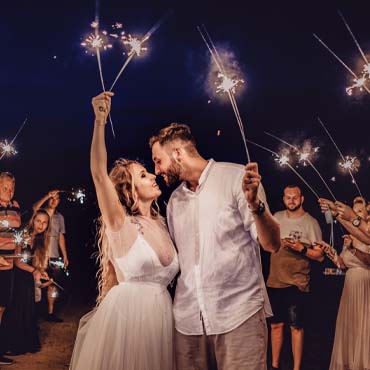
Wedding Celebrations

Birthday Parties

Wind and Water Surfing

Jet and Barefoot Skiing

Wake and Skim Boarding

BOOK ACTIVITIES
Ditch hotels and stay in style! Where would you stay when visiting Qatar? In a hotel? What do you think about staying on a yacht? Next time you visit Qatar, choose to stay in a Gallivant yacht instead of a hotel room. It’s going to be a completely different experience from what you have experienced till now. Unlike a hotel, yachts are designed to be compact and luxurious at the same time. A host of different amenities are arranged for your comfortable stay on the yacht, ranging from air-conditioned rooms to a continuous supply of fresh water. You are never going back to your regular hotel room if you stayed on a yacht instead. Call Gallivant for an outstanding yacht stay in Qatar that beats any hotel room.

Astondoa 43 GLX
Length: , capacity: 10, crew: 2, cabins: 6 in a row.

Cabins: 3
Exceptional service and experiences.
We rented the boat on sat dec 3 and since the first contact we found good service, fast responses and flexibility. We were a group of 12 and space was just right. Smaller groups would well enjoy this trip too. The experience started on pier 18 with captain Alvin who managed the boat and timing perfectly to ensures due views and photos during the ride
Alberto Mello
Honestly one of the most amazing cruising experiences I have ever had. Well maintained and clean yacht, super friendly staff and quite easy on the pocket if you’re 5 - 10 people. Will definitely visit again.
Murtaza Rizvi
We booked the two hour boat trip yesterday and it was one of the best boat experiences I’ve ever ever went on. The views were unbelievable the staff was incredibly friendly, they even brought out some juice and snacks. I would definitely recommend booking with Gallivant Yacht.
Alexandra Gilchrist
Latest From Blog

- Sailing Tips

dissertation organisational routines

Organizational routines hold an important place in theories of organizational behavior and strategy. They have been conceptualized in various ways, but two approaches prevail: routines as organizational capabilities or dispositions for repeated performance and routines as repetitive patterns of collective organizational actions.The former approach highlights abilities and resources, the latter ...
Organizational routines are ubiquitous stores of knowledge in organizations. Although routines enable consistent performance on tasks over time, routines might hinder adaptability by promoting inertia and rigidity. In this dissertation, I develop how routines could facilitateadaptation in organizations and foster successful performance on novel tasks. I argue that teams are changed in the ...
Through patterning, routines change and adapt over time. In this chapter, the idea of organizational routines is illustrated with examples from videogame development. The authors suggest that narrative networks provide a way to see routine dynamics as network dynamics and to analyze routines and organizational change from a fresh point of view.
The concept of organizational routines analyzes the repeated performance of organizational process flows with a focus on the actors involved in the process (Howard-Grenville, Rerup, Langley ...
Learning is conceptualised as continuous change in organisational routines, where the latter provide a "window" to the firm's strategy by the virtue of being the constituent parts of dynamic capabilities. The systematic review follows the structure suggested by Cranfield School of Management and outlines the sequence of actions taken ...
Abstract. Organizational routines are considered basic components of organizational behavior and repositories of organizational capabilities (Nelson & Winter, 1982). They do, therefore, hold one ...
This dissertation attempts to answer this question by first developing a precise process understanding of creative work. ... Organizational routines are at the core in capturing the typical way of ...
This dissertation thesis is positioned within the field of organization research and focuses on organizational routines from different perspectives. Due to the comprehensive research on routines (Cyert & March, 1963; Feldman, 2000; Feldman, Pentland, D'Adderio, & Lazaric, 2016; March & Simon, 1958), they have been profoundly examined (Feldman et
This thesis reports on the implementation of knowledge management into three organisational routines. Observations and interviews were used to identify mechanisms and factors that drove changes in routines. The core contribution of the research is an framework supporting practitioners to implement knowledge management into organisational routines.
Purpose of the dissertation Organizational routines can be used as unit of analysis when studying organizations. They can be imagined as a generative system, and as such they have internal dynamics that allow exploring different phenomena such as change, stability, and flexibility.
Organizational Routines and Emotions 4 Introduction This dissertation sheds light on a still widely neglected topic in the field of organizational rou-tines, the emotions of the routine participants. In the traditional view of organizational routines, they are sources of stability and accountability as well as mechanisms for the coordination of
recent studies documenting the effect of PMM on organizational processes, the work reported in this thesis employs the organizational routines perspective as an analytical lens for examining the way in which a particular PMM practice - a performance management review meeting - affects organizational processes that generate performance.
This research explores the existence and evolution of organizational routines in small firm Project-Based Organisations (PBOs). To reach this aim, it investigates the interplay between the two aspects making up a routine: ostensive - i.e. the abstract representation - and performative - i.e. actual implementation. PBOs represent an interesting context, because project differences and ...
Organizational Behavior and Theory Guo Dissertation
Changing organisational routines in doctoral education: an intervention to infuse social justice into a social welfare curriculum . × Close Log In. Log in with Facebook Log in with Google. or. Email. Password. Remember me on this computer. or reset password. Enter the email address you signed up with and we'll email you a reset link. ...
Dissertations / Theses on the topic 'Organizational Routines' To see the other types of publications on this topic, follow the link: Organizational Routines. Author: Grafiati. Published: 4 June 2021 Last updated: 10 March 2023 Create a spot-on reference in APA, MLA, Chicago, Harvard, and other styles ...
Rice and Cooper methodically analyze the dysfunctional routines that sap the usefulness from organizational procedures and information systems. The absence of contextual understanding, perverse feedback loops, conflicting goals, and destructive panopticon effects are all part and parcel of the deep systems analysis of the case studies presented ...
Second, organizational search routines are dynamic routines that are supposed to change. However, in this dissertation, these dynamic routines exhibit no change in the five years before bankruptcy. This stimulates further research thought on under what conditions do dynamic routines change and under what conditions do dynamic routines remain ...
Organisational routines i.e. firms specific, path dependent, repeated patterns of collective behaviour are at the heart of the capabilities-based perspective of building competitive advantage. It is therefore not surprising to see a large body of scholarly work on the impact of organisational routines on performance of firms. However, in contrast to the number of studies on the impact of ...
Video (online) Consult the top 50 dissertations / theses for your research on the topic 'Organisational performance.'. Next to every source in the list of references, there is an 'Add to bibliography' button. Press on it, and we will generate automatically the bibliographic reference to the chosen work in the citation style you need: APA, MLA ...
Search for dissertations about: "Organizational routines" Showing result 1 - 5 of 72 swedish dissertations containing the words Organizational routines. 1. Micro-Foundations of Organizational Adaptation : A Field Study in the Evolution of Product Development Capabilities in a Design Firm. Author : Carlo Salvato; Jönköping University; []
Search for dissertations about: "organisational routines" Showing result 1 - 5 of 30 swedish dissertations containing the words organisational routines. 1. Designing the Design Organisation: Client-consultant coordination in a large infrastructure project. Author : Therese Eriksson; Chalmers University of Technology; []
A doctor at a field hospital for detained Gazans at Israel's Sde Teiman army base has described "deplorable conditions" and "routine" amputations due to handcuff injuries, according to ...
- business plan
- course work
- research paper
biography of a narrative
Definition of biography.
A biography is the non- fiction , written history or account of a person’s life. Biographies are intended to give an objective portrayal of a person, written in the third person. Biographers collect information from the subject (if he/she is available), acquaintances of the subject, or in researching other sources such as reference material, experts, records, diaries, interviews, etc. Most biographers intend to present the life story of a person and establish the context of their story for the reader, whether in terms of history and/or the present day. In turn, the reader can be reasonably assured that the information presented about the biographical subject is as true and authentic as possible.
Biographies can be written about a person at any time, no matter if they are living or dead. However, there are limitations to biography as a literary device. Even if the subject is involved in the biographical process, the biographer is restricted in terms of access to the subject’s thoughts or feelings.
Biographical works typically include details of significant events that shape the life of the subject as well as information about their childhood, education, career, and relationships. Occasionally, a biography is made into another form of art such as a film or dramatic production. The musical production of “Hamilton” is an excellent example of a biographical work that has been turned into one of the most popular musical productions in Broadway history.
Common Examples of Biographical Subjects
Most people assume that the subject of a biography must be a person who is famous in some way. However, that’s not always the case. In general, biographical subjects tend to be interesting people who have pioneered something in their field of expertise or done something extraordinary for humanity. In addition, biographical subjects can be people who have experienced something unusual or heartbreaking, committed terrible acts, or who are especially gifted and/or talented.
As a literary device, biography is important because it allows readers to learn about someone’s story and history. This can be enlightening, inspiring, and meaningful in creating connections. Here are some common examples of biographical subjects:
- political leaders
- entrepreneurs
- historical figures
- serial killers
- notorious people
- political activists
- adventurers/explorers
- religious leaders
- military leaders
- cultural figures
Famous Examples of Biographical Works
The readership for biography tends to be those who enjoy learning about a certain person’s life or overall field related to the person. In addition, some readers enjoy the literary form of biography independent of the subject. Some biographical works become well-known due to either the person’s story or the way the work is written, gaining a readership of people who may not otherwise choose to read biography or are unfamiliar with its form.
Here are some famous examples of biographical works that are familiar to many readers outside of biography fans:
- Alexander Hamilton (Ron Chernow)
- Prairie Fires: The American Dreams of Laura Ingalls Wilder (Caroline Fraser)
- Steve Jobs (Walter Isaacson)
- Churchill: A Life (Martin Gilbert)
- The Professor and the Madman: A Tale of Murder, Insanity, and the Making of the Oxford English Dictionary (Simon Winchester)
- A Beautiful Mind (Sylvia Nasar)
- The Black Rose (Tananarive Due)
- John Adams (David McCullough)
- Into the Wild ( Jon Krakauer )
- John Brown (W.E.B. Du Bois)
- Frida: A Biography of Frida Kahlo (Hayden Herrera)
- The Immortal Life of Henrietta Lacks (Rebecca Skloot)
- Team of Rivals: The Political Genius of Abraham Lincoln (Doris Kearns Goodwin)
- Shirley Jackson : A Rather Haunted Life ( Ruth Franklin)
- the stranger in the Woods: The Extraordinary Story of the Last True Hermit (Michael Finkel)
Difference Between Biography, Autobiography, and Memoir
Biography, autobiography , and memoir are the three main forms used to tell the story of a person’s life. Though there are similarities between these forms, they have distinct differences in terms of the writing, style , and purpose.
A biography is an informational narrative and account of the life history of an individual person, written by someone who is not the subject of the biography. An autobiography is the story of an individual’s life, written by that individual. In general, an autobiography is presented chronologically with a focus on key events in the person’s life. Since the writer is the subject of an autobiography, it’s written in the first person and considered more subjective than objective, like a biography. In addition, autobiographies are often written late in the person’s life to present their life experiences, challenges, achievements, viewpoints, etc., across time.
Memoir refers to a written collection of a person’s significant memories, written by that person. Memoir doesn’t generally include biographical information or chronological events unless it’s relevant to the story being presented. The purpose of memoir is reflection and an intention to share a meaningful story as a means of creating an emotional connection with the reader. Memoirs are often presented in a narrative style that is both entertaining and thought-provoking.
Examples of Biography in Literature
An important subset of biography is literary biography. A literary biography applies biographical study and form to the lives of artists and writers. This poses some complications for writers of literary biographies in that they must balance the representation of the biographical subject, the artist or writer, as well as aspects of the subject’s literary works. This balance can be difficult to achieve in terms of judicious interpretation of biographical elements within an author’s literary work and consideration of the separate spheres of the artist and their art.
Literary biographies of artists and writers are among some of the most interesting biographical works. These biographies can also be very influential for readers, not only in terms of understanding the artist or writer’s personal story but the context of their work or literature as well. Here are some examples of well-known literary biographies:
Example 1: Savage Beauty: The Life of Edna St. Vincent Millay (Nancy Milford)
One of the first things Vincent explained to Norma was that there was a certain freedom of language in the Village that mustn’t shock her. It wasn’t vulgar. ‘So we sat darning socks on Waverly Place and practiced the use of profanity as we stitched. Needle in, . Needle out, piss. Needle in, . Needle out, c. Until we were easy with the words.’
This passage reflects the way in which Milford is able to characterize St. Vincent Millay as a person interacting with her sister. Even avid readers of a writer’s work are often unaware of the artist’s private and personal natures, separate from their literature and art. Milford reflects the balance required on the part of a literary biographer of telling the writer’s life story without undermining or interfering with the meaning and understanding of the literature produced by the writer. Though biographical information can provide some influence and context for a writer’s literary subjects, style, and choices , there is a distinction between the fictional world created by a writer and the writer’s “real” world. However, a literary biographer can illuminate the writer’s story so that the reader of both the biography and the biographical subject’s literature finds greater meaning and significance.
Example 2: The Invisible Woman: The Story of Nelly Ternan and Charles Dickens (Claire Tomalin)
The season of domestic goodwill and festivity must have posed a problem to all good Victorian family men with more than one family to take care of, particularly when there were two lots of children to receive the demonstrations of paternal love.
Tomalin’s literary biography of Charles Dickens reveals the writer’s extramarital relationship with a woman named Nelly Ternan. Tomalin presents the complications that resulted for Dickens from this relationship in terms of his personal and family life as well as his professional writing and literary work. Revealing information such as an extramarital relationship can influence the way a reader may feel about the subject as a person, and in the case of literary biography it can influence the way readers feel about the subject’s literature as well. Artists and writers who are beloved , such as Charles Dickens, are often idealized by their devoted readers and society itself. However, as Tomalin’s biography of Dickens indicates, artists and writers are complicated and as subject to human failings as anyone else.
Example 3: Virginia Woolf (Hermione Lee)
‘A self that goes on changing is a self that goes on living’: so too with the biography of that self. And just as lives don’t stay still, so life-writing can’t be fixed and finalised. Our ideas are shifting about what can be said, our knowledge of human character is changing. The biographer has to pioneer, going ‘ahead of the rest of us, like the miner’s canary, testing the atmosphere , detecting falsity, unreality, and the presence of obsolete conventions’. So, ‘There are some stories which have to be retold by each generation’. She is talking about the story of Shelley, but she could be talking about her own life-story.
In this passage, Lee is able to demonstrate what her biographical subject, Virginia Woolf, felt about biography and a person telling their own or another person’s story. Literary biographies of well-known writers can be especially difficult to navigate in that both the author and biographical subject are writers, but completely separate and different people. As referenced in this passage by Lee, Woolf was aware of the subtleties and fluidity present in a person’s life which can be difficult to judiciously and effectively relay to a reader on the part of a biographer. In addition, Woolf offers insight into the fact that biographers must make choices in terms of what information is presented to the reader and the context in which it is offered, making them a “miner’s canary” as to how history will view and remember the biographical subject.
Post navigation
Looking to publish? Meet your dream editor, designer and marketer on Reedsy.
Find the perfect editor for your next book
1 million authors trust the professionals on Reedsy. Come meet them.
Blog • Perfecting your Craft
Posted on Jun 30, 2023
How to Write a Biography: A 7-Step Guide [+Template]
From time to time, nonfiction authors become so captivated by a particular figure from either the present or the past, that they feel compelled to write an entire book about their life. Whether casting them as heroes or villains, there is an interesting quality in their humanity that compels these authors to revisit their life paths and write their story.
However, portraying someone’s life on paper in a comprehensive and engaging way requires solid preparation. If you’re looking to write a biography yourself, in this post we’ll share a step-by-step blueprint that you can follow.
How to write a biography:
1. Seek permission when possible
2. research your subject thoroughly, 3. do interviews and visit locations, 4. organize your findings, 5. identify a central thesis, 6. write it using narrative elements, 7. get feedback and polish the text.

FREE RESOURCE
Biography Outline Template
Craft a satisfying story arc for your biography with our free template.
While you technically don’t need permission to write about public figures (or deceased ones), that doesn't guarantee their legal team won't pursue legal action against you. Author Kitty Kelley was sued by Frank Sinatra before she even started to write His Way , a biography that paints Ol Blue Eyes in a controversial light. (Kelley ended up winning the lawsuit, however).

Whenever feasible, advise the subject’s representatives of your intentions. If all goes according to plan, you’ll get a green light to proceed, or potentially an offer to collaborate. It's a matter of common sense; if someone were to write a book about you, you would likely want to know about it well prior to publication. So, make a sincere effort to reach out to their PR staff to negotiate an agreement or at least a mutual understanding of the scope of your project.
At the same time, make sure that you still retain editorial control over the project, and not end up writing a puff piece that treats its protagonist like a saint or hero. No biography can ever be entirely objective, but you should always strive for a portrayal that closely aligns with facts and reality.
If you can’t get an answer from your subject, or you’re asked not to proceed forward, you can still accept the potential repercussions and write an unauthorized biography . The “rebellious act” of publishing without consent indeed makes for great marketing, though it’ll likely bring more headaches with it too.
✋ Please note that, like other nonfiction books, if you intend to release your biography with a publishing house , you can put together a book proposal to send to them before you even write the book. If they like it enough, they might pay you an advance to write it.

Book Proposal Template
Craft a professional pitch for your nonfiction book with our handy template.
Once you’ve settled (or not) the permission part, it’s time to dive deep into your character’s story.
Deep and thorough research skills are the cornerstone of every biographer worth their salt. To paint a vivid and accurate portrait of someone's life, you’ll have to gather qualitative information from a wide range of reliable sources.
Start with the information already available, from books on your subject to archival documents, then collect new ones firsthand by interviewing people or traveling to locations.
Browse the web and library archives

Put your researcher hat on and start consuming any piece on your subject you can find, from their Wikipedia page to news articles, interviews, TV and radio appearances, YouTube videos, podcasts, books, magazines, and any other media outlets they may have been featured in.
Establish a system to orderly collect the information you find 一 even seemingly insignificant details can prove valuable during the writing process, so be sure to save them.
Depending on their era, you may find most of the information readily available online, or you may need to search through university libraries for older references.

For his landmark biography of Alexander Hamilton, Ron Chernow spent untold hours at Columbia University’s library , reading through the Hamilton family papers, visiting the New York Historical Society, as well as interviewing the archivist of the New York Stock Exchange, and so on. The research process took years, but it certainly paid off. Chernow discovered that Hamilton created the first five securities originally traded on Wall Street. This finding, among others, revealed his significant contributions to shaping the current American financial and political systems, a legacy previously often overshadowed by other founding fathers. Today Alexander Hamilton is one of the best-selling biographies of all time, and it has become a cultural phenomenon with its own dedicated musical.
Besides reading documents about your subject, research can help you understand the world that your subject lived in.
Try to understand their time and social environment
Many biographies show how their protagonists have had a profound impact on society through their philosophical, artistic, or scientific contributions. But at the same time, it’s worth it as a biographer to make an effort to understand how their societal and historical context influenced their life’s path and work.
An interesting example is Stephen Greenblatt’s Will in the World . Finding himself limited by a lack of verified detail surrounding William Shakespeare's personal life, Greenblatt, instead, employs literary interpretation and imaginative reenactments to transport readers back to the Elizabethan era. The result is a vivid (though speculative) depiction of the playwright's life, enriching our understanding of his world.

Many readers enjoy biographies that transport them to a time and place, so exploring a historical period through the lens of a character can be entertaining in its own right. The Diary of Samuel Pepys became a classic not because people were enthralled by his life as an administrator, but rather from his meticulous and vivid documentation of everyday existence during the Restoration period.
Once you’ve gotten your hands on as many secondary sources as you can find, you’ll want to go hunting for stories first-hand from people who are (or were) close to your subject.
With all the material you’ve been through, by now you should already have a pretty good picture of your protagonist. But you’ll surely have some curiosities and missing dots in their character arc to figure out, which you can only get by interviewing primary sources.
Interview friends and associates
This part is more relevant if your subject is contemporary, and you can actually meet up or call with relatives, friends, colleagues, business partners, neighbors, or any other person related to them.
In writing the popular biography of Steve Jobs, Walter Isaacson interviewed more than one hundred people, including Jobs’s family, colleagues, former college mates, business rivals, and the man himself.
🔍 Read other biographies to get a sense of what makes a great one. Check out our list of the 30 best biographies of all time , or take our 30-second quiz below for tips on which one you should read next.
Which biography should you read next?
Discover the perfect biography for you. Takes 30 seconds!
When you conduct your interviews, make sure to record them with high quality audio you can revisit later. Then use tools like Otter.ai or Descript to transcribe them 一 it’ll save you countless hours.
You can approach the interview with a specific set of questions, or follow your curiosity blindly, trying to uncover revealing stories and anecdotes about your subject. Whatever your method, author and biography editor Tom Bromley suggests that every interviewer arrives prepared, "Show that you’ve done your work. This will help to put the interviewee at ease, and get their best answers.”
Bromley also places emphasis on the order in which you conduct interviews. “You may want to interview different members of the family or friends first, to get their perspective on something, and then go directly to the main interviewee. You'll be able to use that knowledge to ask sharper, more specific questions.”
Finally, consider how much time you have with each interviewee. If you only have a 30-minute phone call with an important person, make it count by asking directly the most pressing questions you have. And, if you find a reliable source who is also particularly willing to help, conduct several interviews and ask them, if appropriate, to write a foreword as part of the book’s front matter .
Sometimes an important part of the process is packing your bags, getting on a plane, and personally visiting significant places in your character’s journey.
Visit significant places in their life
A place, whether that’s a city, a rural house, or a bodhi tree, can carry a particular energy that you can only truly experience by being there. In putting the pieces together about someone’s life, it may be useful to go visit where they grew up, or where other significant events of their lives happened. It will be easier to imagine what they experienced, and better tell their story.
In researching The Lost City of Z , author David Grann embarked on a trek through the Amazon, retracing the steps of British explorer Percy Fawcett. This led Grann to develop new theories about the circumstances surrounding the explorer's disappearance.

Hopefully, you won’t have to deal with jaguars and anacondas to better understand your subject’s environment, but try to walk into their shoes as much as possible.
Once you’ve researched your character enough, it’s time to put together all the puzzle pieces you collected so far.
Take the bulk of notes, media, and other documents you’ve collected, and start to give them some order and structure. A simple way to do this is by creating a timeline.
Create a chronological timeline
It helps to organize your notes chronologically 一 from childhood to the senior years, line up the most significant events of your subject’s life, including dates, places, names and other relevant bits.

You should be able to divide their life into distinct periods, each with their unique events and significance. Based on that, you can start drafting an outline of the narrative you want to create.
Draft a story outline
Since a biography entails writing about a person’s entire life, it will have a beginning, a middle, and an end. You can pick where you want to end the story, depending on how consequential the last years of your subject were. But the nature of the work will give you a starting character arc to work with.
To outline the story then, you could turn to the popular Three-Act Structure , which divides the narrative in three main parts. In a nutshell, you’ll want to make sure to have the following:
- Act 1. Setup : Introduce the protagonist's background and the turning points that set them on a path to achieve a goal.
- Act 2. Confrontation : Describe the challenges they encounter, both internal and external, and how they rise to them. Then..
- Act 3. Resolution : Reach a climactic point in their story in which they succeed (or fail), showing how they (and the world around them) have changed as a result.
Only one question remains before you begin writing: what will be the main focus of your biography?
Think about why you’re so drawn to your subject to dedicate years of your life to recounting their own. What aspect of their life do you want to highlight? Is it their evil nature, artistic genius, or visionary mindset? And what evidence have you got to back that up? Find a central thesis or focus to weave as the main thread throughout your narrative.

Or find a unique angle
If you don’t have a particular theme to explore, finding a distinct angle on your subject’s story can also help you distinguish your work from other biographies or existing works on the same subject.
Plenty of biographies have been published about The Beatles 一 many of which have different focuses and approaches:
- Philip Norman's Shout is sometimes regarded as leaning more towards a pro-Lennon and anti-McCartney stance, offering insights into the band's inner dynamics.
- Ian McDonald's Revolution in the Head closely examines their music track by track, shifting the focus back to McCartney as a primary creative force.
- Craig Brown's One Two Three Four aims to capture their story through anecdotes, fan letters, diary entries, and interviews.
- Mark Lewisohn's monumental three-volume biography, Tune In , stands as a testament to over a decade of meticulous research, chronicling every intricate detail of the Beatles' journey.

Finally, consider that biographies are often more than recounting the life of a person. Similar to how Dickens’ Great Expectations is not solely about a boy named Pip (but an examination and critique of Britain’s fickle, unforgiving class system), a biography should strive to illuminate a broader truth — be it social, political, or human — beyond the immediate subject of the book.
Once you’ve identified your main focus or angle, it’s time to write a great story.

While biographies are often highly informative, they do not have to be dry and purely expository in nature . You can play with storytelling elements to make it an engaging read.
You could do that by thoroughly detailing the setting of the story , depicting the people involved in the story as fully-fledged characters , or using rising action and building to a climax when describing a particularly significant milestone of the subject’s life.
One common way to make a biography interesting to read is starting on a strong foot…
Hook the reader from the start
Just because you're honoring your character's whole life doesn't mean you have to begin when they said their first word. Starting from the middle or end of their life can be more captivating as it introduces conflicts and stakes that shaped their journey.
When he wrote about Christopher McCandless in Into the Wild , author Jon Krakauer didn’t open his subject’s childhood and abusive family environment. Instead, the book begins with McCandless hitchhiking his way into the wilderness, and subsequently being discovered dead in an abandoned bus. By starting in medias res , Krakauer hooks the reader’s interest, before tracing back the causes and motivations that led McCandless to die alone in that bus in the first place.

You can bend the timeline to improve the reader’s reading experience throughout the rest of the story too…
Play with flashback
While biographies tend to follow a chronological narrative, you can use flashbacks to tell brief stories or anecdotes when appropriate. For example, if you were telling the story of footballer Lionel Messi, before the climax of winning the World Cup with Argentina, you could recall when he was just 13 years old, giving an interview to a local newspaper, expressing his lifelong dream of playing for the national team.
Used sparsely and intentionally, flashbacks can add more context to the story and keep the narrative interesting. Just like including dialogue does…
Reimagine conversations
Recreating conversations that your subject had with people around them is another effective way to color the story. Dialogue helps the reader imagine the story like a movie, providing a deeper sensory experience.

One thing is trying to articulate the root of Steve Jobs’ obsession with product design, another would be to quote his father , teaching him how to build a fence when he was young: “You've got to make the back of the fence just as good looking as the front of the fence. Even though nobody will see it, you will know. And that will show that you're dedicated to making something perfect.”
Unlike memoirs and autobiographies, in which the author tells the story from their personal viewpoint and enjoys greater freedom to recall conversations, biographies require a commitment to facts. So, when recreating dialogue, try to quote directly from reliable sources like personal diaries, emails, and text messages. You could also use your interview scripts as an alternative to dialogue. As Tom Bromley suggests, “If you talk with a good amount of people, you can try to tell the story from their perspective, interweaving different segments and quoting the interviewees directly.”

FREE COURSE
How to Write Believable Dialogue
Master the art of dialogue in 10 five-minute lessons.
These are just some of the story elements you can use to make your biography more compelling. Once you’ve finished your manuscript, it’s a good idea to ask for feedback.
If you’re going to self-publish your biography, you’ll have to polish it to professional standards. After leaving your work to rest for a while, look at it with fresh eyes and self-edit your manuscript eliminating passive voice, filler words, and redundant adverbs.

Then, have a professional editor give you a general assessment. They’ll look at the structure and shape of your manuscript and tell you which parts need to be expanded on or cut. As someone who edited and commissioned several biographies, Tom Bromley points out that a professional “will look at the sources used and assess whether they back up the points made, or if more are needed. They would also look for context, and whether or not more background information is needed for the reader to understand the story fully. And they might check your facts, too.”
In addition to structural editing, you may want to have someone copy-edit and proofread your work.

MEET EDITORS
Polish your book with expert help
Sign up, meet 1500+ experienced editors, and find your perfect match.
Importantly, make sure to include a bibliography with a list of all the interviews, documents, and sources used in the writing process. You’ll have to compile it according to a manual of style, but you can easily create one by using tools like EasyBib . Once the text is nicely polished and typeset in your writing software , you can prepare for the publication process.
In conclusion, by mixing storytelling elements with diligent research, you’ll be able to breathe life into a powerful biography that immerses readers in another individual’s life experience. Whether that’ll spark inspiration or controversy, remember you could have an important role in shaping their legacy 一 and that’s something not to take lightly.
Continue reading
Recommended posts from the Reedsy Blog

How Many Sentences Are in a Paragraph?
From fiction to nonfiction works, the length of a paragraph varies depending on its purpose. Here's everything you need to know.

Narrative Structure: Definition, Examples, and Writing Tips
What's the difference between story structure and narrative structure? And how do you choose the right narrative structure for you novel?

What is the Proust Questionnaire? 22 Questions to Write Better Characters
Inspired by Marcel Proust, check out the questionnaire that will help your characters remember things past.

What is Pathos? Definition and Examples in Literature
Pathos is a literary device that uses language to evoke an emotional response, typically to connect readers with the characters in a story.

How to Start a Children’s Book: Coming Up with Your Big Idea
If you've ever dreamed of writing a children's book but aren't sure where to start, check out this post to learn more about how you can create the perfect story for kids.

How to Become a Travel Writer in 5 Steps: A Guide for Travel Bugs
If you want to get paid to share your adventures, learn how to become a travel writer with these five tips.
Join a community of over 1 million authors
Reedsy is more than just a blog. Become a member today to discover how we can help you publish a beautiful book.
We have an app for that
Build a writing routine with our free writing app.

1 million authors trust the professionals on Reedsy. Come meet them.
Enter your email or get started with a social account:
Life’s Stories
How you arrange the plot points of your life into a narrative can shape who you are—and is a fundamental part of being human.
This article was featured in One Story to Read Today, a newsletter in which our editors recommend a single must-read from The Atlantic , Monday through Friday. Sign up for it here.
In Paul Murray’s novel Skippy Dies, there’s a point where the main character, Howard, has an existential crisis. “‘It’s just not how I expected my life would be,’” he says.
“‘What did you expect?’” a friend responds.
“Howard ponders this. ‘I suppose—this sounds stupid, but I suppose I thought there’d be more of a narrative arc .’”
But it’s not stupid at all. Though perhaps the facts of someone’s life, presented end to end, wouldn’t much resemble a narrative to the outside observer, the way people choose to tell the stories of their lives, to others and—crucially—to themselves, almost always does have a narrative arc. In telling the story of how you became who you are, and of who you’re on your way to becoming, the story itself becomes a part of who you are.
“Life stories do not simply reflect personality. They are personality, or more accurately, they are important parts of personality, along with other parts, like dispositional traits, goals, and values,” writes Dan McAdams, a professor of psychology at Northwestern University, along with Erika Manczak, in a chapter for the APA Handbook of Personality and Social Psychology.
In the realm of narrative psychology, a person’s life story is not a Wikipedia biography of the facts and events of a life, but rather the way a person integrates those facts and events internally—picks them apart and weaves them back together to make meaning. This narrative becomes a form of identity, in which the things someone chooses to include in the story, and the way she tells it, can both reflect and shape who she is. A life story doesn’t just say what happened, it says why it was important, what it means for who the person is, for who they’ll become, and for what happens next.
“Sometimes in cases of extreme autism, people don’t construct a narrative structure for their lives,” says Jonathan Adler, an assistant professor of psychology at Olin College of Engineering, “but the default mode of human cognition is a narrative mode.”
When people tell others about themselves, they kind of have to do it in a narrative way—that’s just how humans communicate. But when people think about their lives to themselves, is it always in a narrative way, with a plot that leads from one point to another? There’s an old adage that everyone has a book inside of them. (Christopher Hitchens once said that inside is “exactly where I think it should, in most cases, remain.” ) Is there anyone out there with a life story that’s not a story at all, but some other kind of more disjointed, avant-garde representation of their existence?
“This is an almost impossible question to address from a scientific approach,” says Monisha Pasupathi, a professor of developmental psychology at the University of Utah. Even if we are, as the writer Jonathan Gottschall put it, “storytelling animals,” what does that mean from one person to the next? Not only are there individual differences in how people think of their stories, there’s huge variation in the degree to which they engage in narrative storytelling in the first place.
“Some people write in their diaries and are very introspective, and some people are not at all,” says Kate McLean, an associate professor of psychology at Western Washington University. Journal-keeping, though a way of documenting the life story, doesn’t always make for a tightly-wound narrative. A writer I interviewed several months ago—Sarah Manguso—has kept a diary for 25 years, and still told me, “Narrative is not a mode that has ever come easily to me.”
Nevertheless, the researchers I spoke with were all convinced that even if it’s not 100 percent universal to see life as a story, it’s at least extremely common.
“I think normal, healthy adults have in common that they can all produce a life story,” Pasupathi says. “They can all put one together … In order to have relationships, we’ve all had to tell little pieces of our story. And so it’s hard to be a human being and have relationships without having some version of a life story floating around.”
But life rarely follows the logical progression that most stories—good stories—do, where the clues come together, guns left on mantles go off at the appropriate moments, the climax comes in the third act. So narrative seems like an incongruous framing method for life’s chaos, until you remember where stories came from in the first place. Ultimately, the only material we’ve ever had to make stories out of is our own imagination, and life itself.
Storytelling, then—fictional or nonfictional, realistic or embellished with dragons—is a way of making sense of the world around us.
“Life is incredibly complex, there are lots of things going on in our environment and in our lives at all times, and in order to hold onto our experience, we need to make meaning out of it,” Adler says. “The way we do that is by structuring our lives into stories.”
It’s hardly a simple undertaking. People contain multitudes, and by multitudes, I mean libraries. Someone might have an overarching narrative for her whole life, and different narratives for different realms of her life—career, romance, family, faith. She might have narratives within each realm that intersect, diverge, or contradict each other, all of them filled with the microstories of specific events. And to truly make a life story, she’ll need to do what researchers call “autobiographical reasoning” about the events—“identifying lessons learned or insights gained in life experiences, marking development or growth through sequences of scenes, and showing how specific life episodes illustrate enduring truths about the self,” McAdams and Manczak write.
“Stories don’t have to be really simple, like fairy-tale-type narratives,” McAdams says. “They can be complicated. It can be like James Joyce out there.”
If you really like James Joyce, it might be a lot like James Joyce. People take the stories that surround them—fictional tales, news articles, apocryphal family anecdotes—then identify with them and borrow from them while fashioning their own self-conceptions. It’s a Möbius strip: Stories are life, life is stories.
People aren’t writing their life stories from birth, though. The ability to create a life narrative takes a little while to come online—the development process gives priority to things like walking, talking, and object permanence. Young children can tell stories about isolated events, with guidance, and much of adolescence is dedicated to learning “what goes in a story … and what makes a good story in the first place,” Pasupathi says. “I don’t know how much time you’ve spent around little kids, but they really don’t understand that. I have a child who can really take an hour to tell you about Minecraft .” Through friends, family, and fiction, children learn what others consider to be good storytelling—and that being able to spin a good yarn has social value.
It’s in the late teens and early years of adulthood that story construction really picks up—because by then people have developed some of the cognitive tools they need to create a coherent life story. These include causal coherence—the ability to describe how one event led to another—and thematic coherence—the ability to identify overarching values and motifs that recur throughout the story. In a study analyzing the life stories of 8-, 12-, 16-, and 20-year-olds, these kinds of coherence were found to increase with age. As the life story enters its last chapters, it may become more set in stone. In one study by McLean , older adults had more thematic coherence, and told more stories about stability, while young adults tended to tell more stories about change.
McAdams conceives of this development as the layering of three aspects of the self. Pretty much from birth, people are “actors.” They have personality traits, they interact with the world, they have roles to play—daughter, sister, the neighbor’s new baby that cries all night and keeps you up. When they get old enough to have goals, they become “agents” too—still playing their roles and interacting with the world, but making decisions with the hopes of producing desired outcomes. And the final layer is “author,” when people begin to bundle ideas about the future with experiences from the past and present to form a narrative self.
This developmental trajectory could also explain why people enjoy different types of fictional stories at different ages. “When you’re a kid, it’s mostly about plot,” McAdams says. “This happens and this happens. You’re not tuned into the idea that a character develops.” Thus, perhaps, the appeal of cartoon characters who never get older.
Recently, McAdams says, his book club read Ethan Frome by Edith Wharton. “I read it in high school and hated it,” he says. “All I could remember about it was that this sled hits a tree. And we read it recently in the club, and whoa, is it fabulous. A sled does hit the tree, there’s no doubt that is a big scene, but how it changes these people’s lives and the tragedy of this whole thing, it’s completely lost on 18-year-olds. Things are lost on 8-year-olds that a 40-year-old picks up, and things that an 8-year-old found compelling and interesting will just bore a 40-year-old to tears sometimes.”
And like personal taste in books or movies, the stories we tell ourselves about ourselves are influenced by more than just, well, ourselves. The way people recount experiences to others seems to shape the way they end up remembering those events. According to Pasupathi’s research, this happens in a couple of ways. One is that people tailor the stories they tell to their audiences and the context. (For example, I tell the story of the time I crashed my mom’s car much differently now, to friends, than the way I told it to my mom at the time. Much less crying.)
The other is that the act of telling is a rehearsal of the story, Pasupathi says. “And rehearsal strengthens connections between some pieces of information in your mind and diminishes connections between others. So the things I tell you become more accessible to me and more memorable to me. Those can be pretty lasting effects.” So when people drop the cheesy pick-up line “What’s your story?” at a bar, like a man who nicks his carotid artery while shaving, they’ve accidentally hit upon something vital.
But just as there are consequences to telling, there are consequences to not telling . If someone is afraid of how people might react to a story, and they keep it to themselves, they’ll likely miss out on the enrichment that comes with a back-and-forth conversation. A listener “may give you other things to think about, or may acknowledge that this thing you thought was really bad is actually not a big deal, so you get this richer and more elaborated memory,” Pasupathi says. If you don’t tell, “your memory for that event may be less flexible and give you less chance for growth.” This is basically the premise of talk therapy.
And all of this doesn’t even account for all the conversations you plan to have, or elaborately imagine having and never have. The path from outside to inside and back out is winding, dark, and full of switchbacks.
Once certain stories get embedded into the culture, they become master narratives—blueprints for people to follow when structuring their own stories, for better or worse. One such blueprint is your standard “go to school, graduate, get a job, get married, have kids.”
That can be a helpful script in that it gives children a sense of the arc of a life, and shows them examples of tentpole events that could happen. But the downsides of standard narratives have been well-documented—they stigmatize anyone who doesn’t follow them to a T, and provide unrealistic expectations of happiness for those who do. If this approach were a blueprint for an IKEA desk instead of a life, almost everyone trying to follow it would end up with something wobbly and misshapen, with a few leftover bolts you find under the couch, boding ill for the structural integrity of the thing you built.
“I think that’s a particularly pernicious frame for people who become parents,” Pasupathi says. “That’s a narrative where the pinnacle is to get married and have kids and then everything will be sort of flatly happy from then on.”
And these scripts evolve as culture evolves. For example, in centuries past, stories of being possessed by demons might not have been out of place, but it’s unlikely most people would describe their actions in those terms nowadays.
Other common narrative structures seen in many cultures today are redemption sequences and contamination sequences. A redemption story starts off bad and ends better—“That horrible vacation ultimately brought us closer as a family”—while a contamination story does the opposite—“The cruise was amazing until we all got food poisoning.” Having redemption themes in one’s life story is generally associated with greater well-being, while contamination themes tend to coincide with poorer mental health.
Many people have some smaller stories of each type sprinkled throughout their greater life story, though a person’s disposition, culture, and environment can influence which they gravitate to. People can also see the larger arc of their lives as redemptive or contaminated, and redemption in particular is a popular, and particularly American, narrative. “Evolving from the Puritans to Ralph Waldo Emerson to Oprah Winfrey … Americans have sought to author their lives as redemptive tales of atonement, emancipation, recovery, self-fulfillment, and upward social mobility,” McAdams writes in an overview of life-story research . “The stories speak of heroic individual protagonists—the chosen people—whose manifest destiny is to make a positive difference in a dangerous world, even when the world does not wish to be redeemed.”
The redemption story is American optimism—things will get better!—and American exceptionalism—I can make things better!—and it’s in the water, in the air, and in our heads. This is actually a good thing a lot of the time. Studies have shown that finding a positive meaning in negative events is linked to a more complex sense of self and greater life satisfaction. And even controlling for general optimism, McAdams and his colleagues found that having more redemption sequences in a life story was still associated with higher well-being.
The trouble comes when redemption isn’t possible. The redemptive American tale is one of privilege, and for those who can’t control their circumstances, and have little reason to believe things will get better, it can be an illogical and unattainable choice. There are things that happen to people that cannot be redeemed.
It can be hard to share a story when it amounts to: “This happened, and it was terrible. The end.” In research McLean did, in which she asked people who’d had near-death experiences to tell their stories to others, “the people who told these unresolved stories had really negative responses,” she says. If there wasn’t some kind of uplifting, redemptive end to the story (beyond just the fact that they survived), “The listeners did not like that.
“The redemptive story is really valued in America, because for a lot of people it’s a great way to tell stories, but for people who just can’t do that, who can’t redeem their traumas for whatever reason, they’re sort of in a double bind,” she continues. “They both have this crappy story that’s hanging on, but they also can’t tell it and get acceptance or validation from people.”
In cases like this, for people who have gone through a lot of trauma, it might be better for them not to autobiographically reason about it at all.
“The first time I ever found this association, of reasoning associated with poor mental health, I thought that I had analyzed my data incorrectly,” McLean says. But after other researchers replicated her findings, she got more confident that something was going on. She thinks that people may repress traumatic events in a way that, while not ideal, is still “healthy enough.”
“The typical idea is that you can repress something but it’s going to come back and bite you if you don’t deal with it,” she says. “But that’s still under the assumption that people have the resources to deal with it.”
In one study, McLean and her colleagues interviewed adolescents attending a high school for vulnerable students. One subject, Josie, the 17-year-old daughter of a single mother, suffered from drug and alcohol abuse, bipolar disorder, rape, and a suicide attempt. She told the researchers that her self-defining memory was that her mother had promised not to have more children and then broke that promise.
“I’m the only person that I can rely on in my life because I’ve tried to rely on other people and I either get stabbed in the back or hurt, so I really know that I can only trust myself and rely on myself,” Josie said when recounting this memory.
“That’s pretty intensive reasoning,” McLean says. “So that’s meaningful in understanding who you are, but it doesn’t really give you a positive view of who you are. It may be true in the moment, but it’s not something that propels someone towards growth.”
It’s possible to over-reason about good things in your life as well. “There’s been some experimental research that shows that when people are asked to reflect on positive experiences, it makes them feel worse, because you’re like ‘Oh, why did I marry that person?’” McLean says. “Wisdom and maturity and cognitive complexity are all things that we value, but they don’t necessarily make you happy.”
Though sometimes autobiographical reasoning can lead to dark thoughts, other times it can help people find meaning. And while you may be able to avoid reasoning about a certain event, it would be pretty hard to leave all the pages of a life story unwritten.
“I think the act of framing our lives as a narrative is neither positive nor negative, it just is,” Adler says. “That said, there are better and worse ways of doing that narrative process for our mental health.”
In his research, Adler has noticed two themes in people’s stories that tend to correlate with better well-being: agency, or feeling like you are in control of your life, and communion, or feeling like you have good relationships in your life. The connection is “a little fuzzier” with communion, Adler says—there’s a strong relationship between communion and well-being at the same moment; it’s less clear if feeling communion now predicts well-being later.
But agency sure does. It makes sense, because feelings of helplessness and hopelessness are classic symptoms of depression, that feeling in control would be good for mental health. Adler did a longitudinal study of 47 adults undergoing therapy, having them write personal narratives and complete mental-health assessments over the course of 12 therapy sessions. What he found was not only that themes of agency in participants’ stories increased over time and that mental health increased, and that the two were related, but that increased agency actually appeared in stories before people’s mental health improved.
“It’s sort of like people put out a new version of themselves and lived their way into it,” Adler says.
(There’s something about the narrative form, specifically—while expressing thoughts and feelings about negative events seems to help people’s well-being, one study found that writing them in a narrative form helped more than just listing them.)
But, he continues, “I’m not like Mr. Agency, agency at all costs. I don’t believe that. If you have Stage 4 cancer, agency may be good for you, but is it a rational choice? And I do think [redemption] is good in the long term, but in the throes of really struggling with illness, I don’t know that it actually helps people.”
But I wondered: Though agency may be good for you, does seeing yourself as a strong protagonist come at a cost to the other characters in your story? Are there implications for empathy if we see other people as bit players instead of protagonists in their own right?
“That’s actually kind of an interesting empirical idea,” Pasupathi says. “I don’t know that anybody’s looking at that.”
As Adler’s work shows, people need to see themselves as actors to a certain degree. And Pasupathi’s work shows that other people play a big role in shaping life stories. The question, perhaps, is how much people recognize that their agency is not absolute.
According to one study, highly generative people—that is, people who are caring and committed to helping future generations— often tell stories about others who helped them in the past. McAdams suggests that narcissists are probably more likely to do the opposite—“People [who] are really good at talking about themselves and pushing their own narrative, but they’re not willing to listen to yours.”
“If our stories are about us as triumphant agents going through life and overcoming, and they underplay the role of other people and the role of institutional support in helping us do those things, we are likely to be less good at recognizing how other people’s lives are constrained by institutions and other people,” Pasupathi says. “I think that has real implications for how we think about inequity in our society. The more the whole world is designed to work for you, the less you are aware that it is working for you.”
It’s a dizzying problem: People use stories to make sense of life, but how much do those stories reflect life’s realities? Even allowing for the fact that people are capable of complex Joyce-ian storytelling, biases, personality differences, or emotions can lead different people to see the same event differently. And considering how susceptible humans are to false memories, who’s to say that the plot points in someone’s life story really happened, or happened the way she thought they did, or really caused the effects she saw from them?
Pasupathi’s not convinced that it matters that much whether life stories are perfectly accurate. A lot of false-memory research has to do with eyewitness testimony , where it matters a whole lot whether a person is telling a story precisely as it happened. But for narrative-psychology researchers, “What really matters isn’t so much whether it’s true in the forensic sense, in the legal sense,” she says. “What really matters is whether people are making something meaningful and coherent out of what happened. Any creation of a narrative is a bit of a lie. And some lies have enough truth.”
Organizing the past into a narrative isn’t a way just to understand the self but also to attempt to predict the future. Which is interesting, because the storytelling device that seems most incompatible with the realities of actual life is foreshadowing. Metaphors, sure. As college literature-class discussion sections taught me, you can see anything as a metaphor if you try hard enough. Motifs, definitely. Even if you’re living your life as randomly as possible, enough things will happen that, like monkeys with typewriters, patterns will start to emerge.
But no matter how hard you try, no matter how badly you want to, there is no way to truly know the future, and the world isn’t really organizing itself to give you hints. If you’re prone to overthinking, and playing out every possible scenario in your head in advance, you can see foreshadowing in everything. The look your partner gives you means a fight is on the horizon, that compliment from your boss means you’re on track for a promotion, all the little things you’ve forgotten over the years mean you’re definitely going to get dementia when you’re old.
“Actual life is full of false clues and signposts that lead nowhere,” E.M. Forster once wrote. These become obvious in the keeping of a diary: “Imagine a biography that includes not just a narrative but also all the events that failed to foreshadow,” Manguso writes in Ongoingness, the book about her 25-year diary . “ Most of what the diary includes foreshadows nothing.”
So what to do, then, with all the things that don’t fit tidily? There is evidence that finding some “unity” in your narrative identity is better, psychologically, than not finding it. And it probably is easier to just drop those things as you pull patterns from the chaos, though it may take some readjusting.
But Pasupathi rejects that. “I would want to see people do a good job of not trying to leave stuff out because they can’t make it fit,” she says. “We’re not trying to make pieces of your life go away.”
And so even with the dead ends and wrong turns, people can’t stop themselves. “We try to predict the future all the time,” Pasupathi says. She speculates that the reason there’s foreshadowing in fiction in the first place is because of this human tendency. The uncertainty of the future makes people uncomfortable , and stories are a way to deal with that.
“The future is never a direct replica of the past,” Adler says. “So we need to be able to take pieces of things that have happened to us and reconfigure them into possible futures.” For example, through experience, one learns that “We need to talk” rarely foreshadows anything good. (Life has its own clichés.)
There’s been some brain research supporting this link between the past and the future, showing that the same regions of the brain are activated when people are asked to remember something and when they’re asked to imagine an event that hasn’t happened yet. On the flip side, a patient with severe amnesia also had trouble imagining the future.
Similarly, the way someone imagines his future seems to affect the way he sees his past, at the same time as his past informs what he expects for the future.
“If you’re planning to be a doctor, and you’re a 25-year-old starting medical school, and you have expectations about what the next five to 10 years are going to be like, you’ve probably construed a narrative from your past that helps you understand how you got to this point,” McAdams says. “Then, say, you get into med school and you hate it and you drop out, you probably at the same time are going to change your past. You rewrite the history.”
A life story is written in chalk, not ink, and it can be changed. “You’re both the narrator and the main character of your story,” Adler says. “That can sometimes be a revelation—‘Oh, I’m not just living out this story; I am actually in charge of this story.’”
Whether it’s with the help of therapy, in the midst of an identity crisis, when you’ve been chasing a roadrunner of foreshadowing toward a tunnel that turns out to be painted on a wall, or slowly, methodically, day by day—like with all stories, there’s power in rewriting.
“The past is always up for grabs,” McAdams says.
What Is Biography? Definition, Usage, and Literary Examples
Biography definition.
A biography (BYE-og-ruh-fee) is a written account of one person’s life authored by another person. A biography includes all pertinent details from the subject’s life, typically arranged in a chronological order. The word biography stems from the Latin biographia , which succinctly explains the word’s definition: bios = “life” + graphia = “write.”
Since the advent of the written word, historical writings have offered information about real people, but it wasn’t until the 18th century that biographies evolved into a separate literary genre. Autobiographies and memoirs fall under the broader biography genre, but they are distinct literary forms due to one key factor: the subjects themselves write these works. Biographies are popular source materials for documentaries, television shows, and motion pictures.
The History of Biographies
The biography form has its roots in Ancient Rome and Greece. In 44 BCE, Roman writer Cornelius Nepos published Excellentium Imperatorum Vitae ( Lives of the Generals ), one of the earliest recorded biographies. In 80 CE, Greek writer Plutarch released Parallel Lives , a sweeping work consisting of 48 biographies of famous men. In 121 CE, Roman historian Suetonius wrote De vita Caesarum ( On the Lives of the Caesars ), a series of 12 biographies detailing the lives of Julius Caesar and the first 11 emperors of the Roman Empire. These were among the most widely read biographies of their time, and at least portions of them have survived intact over the millennia.
During the Middle Ages, the Roman Catholic Church had a notable influence on biographies. Historical, political, and cultural biographies fell out of favor. Biographies of religious figures—including saints, popes, and church founders—replaced them. One notable exception was Italian painter/architect Giorgio Vasari’s 1550 biography, The Lives of the Most Excellent Painters, Sculptors, and Architects , which was immensely popular. In fact, it is one of the first examples of a bestselling book.
Still, it wasn’t until the 18th century that authors began to abandon multiple subjects in a single work and instead focus their research and writing on one subject. Scholars consider James Boswell’s 1791 The Life of Samuel Johnson to be the first modern biography. From here, biographies were established as a distinct literary genre, separate from more general historical writing.
As understanding of psychology and sociology grew in the 19th and early 20th centuries, biographies further evolved, offering up even more comprehensive pictures of their subjects. Authors who played major roles in this contemporary approach to biographing include Lytton Strachey, Gamaliel Bradford, and Robert Graves.
Types of Biographies
While all biographical works chronicle the lives of real people, writers can present the information in several different ways.
- Popular biographies are life histories written for a general readership. The Immortal Life of Henrietta Lacks by Rebecca Skloot and Into the Wild by Jon Krakauer are two popular examples.
- Critical biographies discuss the relationship between the subject’s life and the work they produced or were involved in; for example, The Billionaire Who Wasn’t: How Chuck Feeney Secretly Made and Gave Away a Fortune by Conor O’Clery and Unpresidented: A Biography of Donald Trump by Martha Brockenbrough.
- Historical biographies put greater understanding on how the subject’s life and contributions affected or were affected by the times in which they lived; see John Adams by David McCullough and Catherine the Great by Peter K. Massie.
- Literary biographies concentrate almost exclusively on writers and artists, blending a conventional narrative of the historical facts of the subject’s life with an exploration of how these facts impacted their creative output. Some examples include Savage Beauty: The Life of Edna St. Vincent Millay by Nancy Milford and Jackson Pollock: An American Saga by Gregory White Smith and Steven Naifeh.
- Reference biographies are more scholarly writings, usually written by multiple authors and covering multiple lives around a single topic. They verify facts, provide background details, and contribute supplemental information resources, like bibliographies, glossaries, and historical documents; for example, Black Americans in Congress, 1870-2007 and the Dictionary of Canadian Biography .
- Fictional biographies, or biographical novels, like The Other Boleyn Girl by Philippa Gregory, incorporate creative license into the retelling of a real person’s story by taking on the structure and freedoms of a novel. The term can also describe novels in which authors give an abundance of background information on their characters, to the extent that the novel reads more like a biography than fiction. An example of this is George R.R. Martin’s Fire and Blood , a novel detailing the history of a royal family from his popular A Song of Ice and Fire
Biographies and Filmed Entertainment
Movie makers and television creators frequently produce biographical stories, either as dramatized productions based on real people or as nonfiction accounts.
Documentary
This genre is a nonfictional movie or television show that uses historical records to tell the story of a subject. The subject might be a one person or a group of people, or it might be a certain topic or theme. To present a biography in a visually compelling way, documentaries utilize archival footage, recreations, and interviews with subjects, scholars, experts, and others associated with the subject.
Famous film documentaries include Grey Gardens, a biography of two of Jacqueline Kennedy’s once-wealthy cousins, who, at the time of filming, lived in squalor in a condemned mansion in the Hamptons; and I Am Not Your Negro , a biography of the life and legacy of pioneering American author James Baldwin.
Television documentary series tell one story over the course of several episodes, like The Jinx : The Life and Deaths of Robert Durst , a biography of the real estate heir and alleged serial killer that focused on his suspected crimes. There are many nonfiction television shows that use a documentary format, but subjects typically change from one episode to the next, such as A&E’s Biography and PBS’s POV .
These films are biographical motion pictures, written by screenwriters and performed by actors. They often employ a certain amount of creative liberty in their interpretation of a real life. This is largely done to maintain a feasible runtime; capturing all of the pivotal moments of a subject’s life in a 90- or 120-minute movie is all but impossible. So, filmmakers might choose to add, eliminate, or combine key events and characters, or they may focus primarily on one or only a few aspects of the subject’s life. Some popular examples: Coal Miner’s Daughter , a biography of country music legend Loretta Lynn; Malcom X , a biopic centered on the civil rights leader of the same name; and The King’s Speech , a dramatization of Prince Albert’s efforts to overcome a stutter and ascend the English throne.
Semi-fictionalized account
This approach takes a real-life event and interprets or expands it in ways that stray beyond what actually happened. This is done for entertainment and to build the story so it fits the filmmaker’s vision or evolves into a longer form, such as a multi-season television show. These accounts sometimes come with the disclaimer that they are “inspired by true events.” Examples of semi-fictionalized accounts are the TV series Orange Is the New Black , Masters of Sex , and Mozart of the Jungle —each of which stem from at least one biographical element, but showrunners expounded upon to provide many seasons of entertainment.
The Functions of Biography
Biographies inform readers about the life of a notable person. They are a way to introduce readers to the work’s subject—the historical details, the subject’s motivations and psychological underpinnings, and their environment and the impact they had, both in the short and long term.
Because the author is somewhat removed from their subject, they can offer a more omniscient, third-person narrative account. This vantage point allows the author to put certain events into a larger context; compare and contrast events, people, and behaviors predominant in the subject’s life; and delve into psychological and sociological themes of which the subject may not have been aware.
Also, a writer structures a biography to make the life of the subject interesting and readable. Most biographers want to entertain as well as inform, so they typically use a traditional plot structure—an introduction, conflict , rising of tension, a climax, a resolution, and an ending—to give the life story a narrative shape. While the ebb and flow of life is a normal day-to-day rhythm, it doesn’t necessarily make for entertaining reading. The job of the writer, then, becomes one of shaping the life to fit the elements of a good plot.
Writers Known for Biographies
Many modern writers have dedicated much of their careers to biographies, such as:
- Kitty Kelley, author of Jackie Oh! An Intimate Biography; His Way: The Unauthorized Biography of Frank Sinatra ; and The Family: The Real Story of the Bush Dynasty
- Antonia Fraser, author of Mary Queen of Scots ; Cromwell; Our Chief of Men ; and The Gunpowder Plot: Terror and Faith in 1605
- David McCullough, author of The Path Between the Seas; Truman ; and John Adams
- Andrew Morton, author of Diana: Her True Story in Her Own Words; Madonna ; and Tom Cruise: An Unauthorized Biography
- Alison Weir, author of The Six Wives of Henry VIII; Eleanor of Aquitaine: By the Wrath of God; Queen of England ; and Katherine Swynford: The Story of John of Gaunt and His Scandalous Duchess
Examples of Biographies
1. James Boswell, The Life of Samuel Johnson
The biography that ushered in the modern era of true-life writing, The Life of Samuel Johnson covered the entirety of its subject’s life, from his birth to his status as England’s preeminent writer to his death. Boswell was a personal acquaintance of Johnson, so he was able to draw on voluminous amounts of personal conversations the two shared.
What also sets this biography apart is, because Boswell was a contemporary of Johnson, readers see Johnson in the context of his own time. He wasn’t some fabled figure that a biographer was writing about centuries later; he was someone to whom the author had access, and Boswell could see the real-world influence his subject had on life in the here and now.
2. Sylvia Nasar, A Beautiful Mind
Nasar’s 1998 Pulitzer Prize-nominated biography of mathematician John Nash introduced legions of readers to Nash’s remarkable life and genius. The book opens with Nash’s childhood and follows him through his education, career, personal life, and struggles with schizophrenia. It ends with his acceptance of the 1994 Nobel Prize for Economics. In addition to a Pulitzer nomination, A Beautiful Mind won the National Book Critics Circle Award for Biography, was a New York Times bestseller, and provided the basis for the Academy Award-winning 2001 film of the same name.
3. Catherine Clinton, Harriet Tubman: The Road to Freedom
Clinton’s biography of the abolitionist icon is a large-scale epic that chronicles Tubman’s singular life. It starts at her birth in the 1820s as the slave Araminta Ross, continuing through her journey to freedom; her pivotal role in the Underground Railroad; her Moses-like persona; and her death in 1913.
Because Tubman could not read or write, she left behind no letters, diaries, or other personal papers in her own hand and voice. Clinton reconstructed Tubman’s history entirely through other source material, and historians often cite this work as the quintessential biography of Tubman’s life.
4. Megan Mayhew Bergman, Almost Famous Women
Almost Famous Women is not a biography in the strictest sense of the word; it is a fictional interpretation of real-life women. Each short story revolves around a woman from history with close ties to fame, such as movie star Marlene Dietrich, Standard Oil heiress Marion “Joe” Carstairs, aviatrix Beryl Markham, Oscar Wilde’s niece Dolly, and Lord Byron’s daughter Allegra. Mayhew Bergman imagines these colorful women in equally colorful episodes that put them in a new light—a light that perhaps offers them the honor and homage that history denied them.
Further Resources on Biography
Newsweek compiled their picks for the 75 Best Biographies of All Time .
The Open Education Database has a list of 75 Biographies to Read Before You Die .
Goodreads put together a list of readers’ best biography selections .
If you’re looking to write biographies, Infoplease has instructions for writing shorter pieces, while The Writer has practical advice for writing manuscript-length bios.
Ranker collected a comprehensive list of famous biographers .
Related Terms
- Autobiography
- Short Story
- Search Menu
- Browse content in Arts and Humanities
- Browse content in Architecture
- History of Architecture
- Theory of Architecture
- Browse content in Art
- History of Art
- Theory of Art
- Browse content in History
- Colonialism and Imperialism
- Environmental History
- Historical Geography
- History by Period
- Local and Family History
- Political History
- Regional and National History
- Social and Cultural History
- Browse content in Literature
- Literary Studies (European)
- Literary Studies (Romanticism)
- Literary Studies (American)
- Literary Studies - World
- Literary Studies (African American Literature)
- Literary Studies (Early and Medieval)
- Literary Studies (Graphic Novels)
- Literary Studies (Plays and Playwrights)
- Literary Studies (Women's Writing)
- Literary Theory and Cultural Studies
- Mythology and Folklore
- Browse content in Media Studies
- Browse content in Music
- Ethnomusicology
- Musical Structures, Styles, and Techniques
- Browse content in Philosophy
- Aesthetics and Philosophy of Art
- Feminist Philosophy
- History of Western Philosophy
- Philosophy of Science
- Philosophy of Language
- Social and Political Philosophy
- Browse content in Religion
- History of Religion
- Browse content in Society and Culture
- Cultural Studies
- Ethical Issues and Debates
- Technology and Society
- Visual Culture
- Browse content in Law
- Intellectual Property Law
- Browse content in Medicine and Health
- Browse content in Public Health and Epidemiology
- Public Health
- Browse content in Science and Mathematics
- Browse content in Biological Sciences
- Ecology and Conservation
- Browse content in Earth Sciences and Geography
- Maps and Map-making
- History of Science and Technology
- Browse content in Psychology
- Clinical Psychology
- Social Psychology
- Browse content in Social Sciences
- Browse content in Anthropology
- Regional Anthropology
- Social and Cultural Anthropology
- Browse content in Business and Management
- Business History
- Criminology and Criminal Justice
- Browse content in Economics
- Economic Development and Growth
- Browse content in Education
- Educational Strategies and Policy
- Philosophy and Theory of Education
- Secondary Education
- Browse content in Environment
- Conservation of the Environment (Social Science)
- Social Impact of Environmental Issues (Social Science)
- Browse content in Politics
- Conflict Politics
- Environmental Politics
- International Relations
- Political Sociology
- Political Theory
- Political Economy
- Public Policy
- US Politics
- Browse content in Regional and Area Studies
- African Studies
- Native American Studies
- Browse content in Sociology
- Gender and Sexuality
- Health, Illness, and Medicine
- Migration Studies
- Race and Ethnicity
- Social Theory
- Social Movements and Social Change
- Social Stratification, Inequality, and Mobility
- Sociology of Religion
- Urban and Rural Studies
- Reviews and Awards
- Journals on Oxford Academic
- Books on Oxford Academic

- < Previous
- Next chapter >
1 Life Narrative: Definitions and Distinctions
- Published: January 2002
- Cite Icon Cite
- Permissions Icon Permissions
This chapter explains the ordinary understandings of the concept and practices of self-referential narrative. It distinguishes between autobiographical writing and the practices of related kinds of life writing, namely, biography, the novel, and history writing. The working definition of self-life writing assumes that it is not a single unitary genre or form of autobiography. Rather, the historically situated practices of self-representation may take many guises as narrators selectively engage their lived experience and situate their social identities through personal storytelling. Located in specific times and places, narrators are at the same time in dialogue with the processes and archive of memory and the expectations of disparate others. The chapter describes how self-life writing shares features with the novel, biography, and history as it employs the dialogue, plot, setting, and density of language of novel.
Signed in as
Institutional accounts.
- GoogleCrawler [DO NOT DELETE]
- Google Scholar Indexing
Personal account
- Sign in with email/username & password
- Get email alerts
- Save searches
- Purchase content
- Activate your purchase/trial code
Institutional access
- Sign in with a library card Sign in with username/password Recommend to your librarian
- Institutional account management
- Get help with access
Access to content on Oxford Academic is often provided through institutional subscriptions and purchases. If you are a member of an institution with an active account, you may be able to access content in one of the following ways:
IP based access
Typically, access is provided across an institutional network to a range of IP addresses. This authentication occurs automatically, and it is not possible to sign out of an IP authenticated account.
Sign in through your institution
Choose this option to get remote access when outside your institution. Shibboleth/Open Athens technology is used to provide single sign-on between your institution’s website and Oxford Academic.
- Click Sign in through your institution.
- Select your institution from the list provided, which will take you to your institution's website to sign in.
- When on the institution site, please use the credentials provided by your institution. Do not use an Oxford Academic personal account.
- Following successful sign in, you will be returned to Oxford Academic.
If your institution is not listed or you cannot sign in to your institution’s website, please contact your librarian or administrator.
Sign in with a library card
Enter your library card number to sign in. If you cannot sign in, please contact your librarian.
Society Members
Society member access to a journal is achieved in one of the following ways:
Sign in through society site
Many societies offer single sign-on between the society website and Oxford Academic. If you see ‘Sign in through society site’ in the sign in pane within a journal:
- Click Sign in through society site.
- When on the society site, please use the credentials provided by that society. Do not use an Oxford Academic personal account.
If you do not have a society account or have forgotten your username or password, please contact your society.
Sign in using a personal account
Some societies use Oxford Academic personal accounts to provide access to their members. See below.
A personal account can be used to get email alerts, save searches, purchase content, and activate subscriptions.
Some societies use Oxford Academic personal accounts to provide access to their members.
Viewing your signed in accounts
Click the account icon in the top right to:
- View your signed in personal account and access account management features.
- View the institutional accounts that are providing access.
Signed in but can't access content
Oxford Academic is home to a wide variety of products. The institutional subscription may not cover the content that you are trying to access. If you believe you should have access to that content, please contact your librarian.
For librarians and administrators, your personal account also provides access to institutional account management. Here you will find options to view and activate subscriptions, manage institutional settings and access options, access usage statistics, and more.
Our books are available by subscription or purchase to libraries and institutions.
- About Oxford Academic
- Publish journals with us
- University press partners
- What we publish
- New features
- Open access
Rights and permissions
- Accessibility
- Advertising
- Media enquiries
- Oxford University Press
- Oxford Languages
- University of Oxford
Oxford University Press is a department of the University of Oxford. It furthers the University's objective of excellence in research, scholarship, and education by publishing worldwide
- Copyright © 2024 Oxford University Press
- Cookie settings
- Cookie policy
- Privacy policy
- Legal notice
This Feature Is Available To Subscribers Only
Sign In or Create an Account
This PDF is available to Subscribers Only
For full access to this pdf, sign in to an existing account, or purchase an annual subscription.

- Book Reviews
- Rants and Revelations
- Indie Bestseller List
- Writing Insights
- Editorial Services
- Literary Agents
- Editor’s Top Picks
- Request Listing
- Self-Publish
- Get Reviewed
- Advertise With Us
- Sponsored Posts
- Rights for Sale
- Happy Clients
Select Page
Memoir, Biography, Narrative Nonfiction—How Are They Different?
Posted by Lisa Dale Norton | Feb 1, 2019 | Writing Insights | 0 |
Here we are in February, the time of year when we throw ourselves back into writing the story of our life. The end of the year, with its deepening dark and circle of celebrations, distracts. But now, we begin again, clawing our way through the relentlessness of the information cycle to a quiet rhythm of shaping words, and asking fundamental questions: What is a memoir? How is it different from biography, and how are both related to that thing called narrative nonfiction?
Here’s my take on it:
Memoir is a story based on your life experience and what you have learned from it.
It is a winnowing of all that has happened into a tight view of a slim section of experience: the coming of age years; the head-spinning start of a career; early motherhood. But always, it is a winnowing of the vast, complicated arc of events that has constituted your life. Narrow, narrow, narrow. Find one series of events that linked together explores some vulnerable and pressing universality of life.
Biography is all about you, too—and all is the correct word. This is where you get to write about where you were born, and what went on during your young years, leaving home, setting out to make your way in the world, love, relationship, work, loss—the whole canvas.
See how biography is different from memoir?
Of course, we hope a biography will show us mistakes made and lessons learned—the vicissitudes that brought a woman to be who she is, pimples and all. We hope for some readers’ transformation as we witness the arc of that person’s life, but this is different from the expectations of the reader of memoir.
The reader of memoir dives in for the short version, the lens of the camera zooming in to show the close up of just the years from 6 to 18, or just that summer your husband died, or just the college years that led to a Rhodes Scholarship, or just the years when you, through sheer fortitude, worked your way out of poverty, of just those events that came together to make you the vocal activist you are today. Slim focus. And from that slim focus a nugget of wisdom.
Narrative nonfiction is a similar but slightly different beast.
This is a form where you might write about yourself and your experience a good deal, but you will also be teaching us something about the world. Maybe it’s the world of a dwindling tribe of the last subsistence whalers in the world (“The Last Whalers: Three Years in the Far Pacific with a Courageous Tribe and a Vanishing Way of Life” by Doug Bock Clark, recently published by Little, Brown and Company), so that the story ends up being about the writer’s experience getting the story, and about the nonfiction information itself.
We could say narrative nonfiction is the wedding of journalism and memoir, and while you may not be a journalist, you can do the same thing with your story by finding a topic that is central to your manuscript and making it an equal and parallel part of the story you write about yourself. Here’s a book where a writer did just that: “Don’t Make Me Pull Over: An Informal History of the Family Road Trip” (Simon & Schuster, 2018), which combined author Richard Ratay’s personal experiences with road trips, and the history of the American road trip from post-WWII to the 1970s.
See what I mean?
If you take the time to peruse the shelves of current nonfiction in your local book shop, you will see a lot of nonfiction with the author as player in the story. Why? Because we are a culture obsessed with the personal, the “I” of everything. Neither good nor bad, just ‘tis. And so, many contemporary nonfiction books give us the writer as a character and that character’s experience. But, they also give us information: the biologist who writes about his early days in the Galapagos, and Charles Darwin; the violinist who writes about becoming first chair of an orchestra, and the violin; the dog lover who writes about her dogs, and the industry of dog shows—two parallel stories that dip into and weave around each other giving us something fresh.
The name narrative nonfiction tells you everything you need to know: narrative, which means a story, and nonfiction, which refers to a topic from our world.
Can you find your project in this spectrum? Doing so now in February will make your writing year more productive, and make you more savvy about the marketplace.
About The Columnist

Lisa Dale Norton
Lisa Dale Norton is an author, developmental book editor, and a dynamic public speaker. She is passionate about layered writing structures in narrative nonfiction that reflect the complexity of life experience, and about the transformative power of writing a memoir. She is a gifted teacher, clear communicator, and a pro at creating an environment were learning can happen. Lisa wrote America’s go-to memoir writing guide, Shimmering Images: A Handy Little Guide to Writing Memoir (Macmillan), and the literary nonfiction story Hawk Flies Above: Journey to the Heart of the Sandhills (Picador USA), which won comparisons to the writing of Annie Dillard. https://lisadalenorton.com/
Related Posts
The ink-stained wretch: “the writer’s conference”.
January 1, 1999

How to Write a Dialogue in Essay
January 1, 2021

Your Life As Story: Introduction to Writing Narrative Nonfiction
September 29, 2006

Developing a Writing Practice
March 1, 2007
Recent Writing Insights
Unpublish a book on Amazon
What are the biggest challenges of pursuing a writing career ?
Writing Insights: Can a new writer write a good draft novel in two weeks?
Authorlink Insights: How do you solve difficult novel writing problems?
Authorlink Insights: Do authors make money from shared pirated copies of books online?
- Login Lost my Password

Our Columnists

Literary Devices
Literary devices, terms, and elements, definition of biography.
A biography is a description of a real person’s life, including factual details as well as stories from the person’s life. Biographies usually include information about the subject’s personality and motivations, and other kinds of intimate details excluded in a general overview or profile of a person’s life. The vast majority of biography examples are written about people who are or were famous, such as politicians, actors, athletes, and so on. However, some biographies can be written about people who lived incredible lives, but were not necessarily well-known. A biography can be labelled “authorized” if the person being written about, or his or her family members, have given permission for a certain author to write the biography.
The word biography comes from the Greek words bios , meaning “life” and – graphia , meaning “writing.”
Difference Between Biography and Autobiography
A biography is a description of a life that is not the author’s own, while an autobiography is the description of a writer’s own life. There can be some gray area, however, in the definition of biography when a ghostwriter is employed. A ghostwriter is an author who helps in the creation of a book, either collaborating with someone else or doing all of the writing him- or herself. Some famous people ask for the help of a ghostwriter to create their own autobiographies if they are not particularly gifted at writing but want the story to sound like it’s coming from their own mouths. In the case of a ghostwritten autobiography, the writer is not actually writing about his or her own life, but has enough input from the subject to create a work that is very close to the person’s experience.
Common Examples of Biography
The genre of biography is so popular that there is even a cable network originally devoted to telling the stories of famous people’s lives (fittingly called The Biography Channel). The stories proved to be such good television that other networks caught on, such as VH1 producing biographies under the series name “Behind the Music.” Some examples of written biographies have become famous in their own right, such as the following books:
- Alexander Hamilton by Ron Chernow (made even more famous by the musical “Hamilton,” created by Lin-Manuel Miranda)
- Unbroken by Laura Hillenbrand
- Steve Jobs by Walter Isaacson
- Into the Wild by Jon Krakauer
- The Immortal Life of Henrietta Lacks by Rebecca Skloot
- Mountains Beyond Mountains: The Quest of Dr. Paul Farmer, A Man Who Would Cure the World by Tracy Kidder
- Three Cups of Tea: One Man’s Mission to Promote Peace … One School at a Time by Greg Mortenson
Significance of Biography in Literature
The genre of biography developed out of other forms of historical nonfiction, choosing to focus on one specific person’s experience rather than all important players. There are examples of biography all the way back to 44 B.C. when Roman biographer Cornelius Nepos wrote Excellentium Imperatorum Vitae (“Lives of those capable of commanding”). The Greek historian Plutarch was also famous for his biographies, creating a series of biographies of famous Greeks and Romans in his book Parallel Lives . After the printing press was created, one of the first “bestsellers” was the 1550 famous biography Lives of the Artists by Giorgio Vasari. Biography then got very popular in the 18th century with James Boswell’s 1791 publication of The Life of Samuel Johnson . Biography continues to be one of the best selling genres in literature, and has led to a number of literary prizes specifically for this form.
And I can imagine Farmer saying he doesn’t care if no one else is willing to follow their example. He’s still going to make these hikes, he’d insist, because if you say that seven hours is too long to walk for two families of patients, you’re saying that their lives matter less than some others’, and the idea that some lives matter less is the root of all that’s wrong with the world.
( Mountains Beyond Mountains: The Quest of Dr. Paul Farmer, A Man Who Would Cure the World by Tracy Kidder)
Tracy Kidder’s wonderful example of biography, Mountains Beyond Mountains , brought the work of Dr. Paul Farmer to a wider audience. Dr. Farmer cofounded the organization Partners in Health (PIH) in 1987 to provide free treatment to patients in Haiti; the organization later created similar projects in countries such as Russia, Peru, and Rwanda. Dr. Farmer was not necessarily a famous man before Tracy Kidder’s biography was published, though he was well-regarded in his own field. The biography describes Farmer’s work as well as some of his personal life.
On July 2, McCandless finished reading Tolstoy’s “Family Happiness”, having marked several passages that moved him: “He was right in saying that the only certain happiness in life is to live for others…” Then, on July 3, he shouldered his backpack and began the twenty-mile hike to the improved road. Two days later, halfway there, he arrived in heavy rain at the beaver ponds that blocked access to the west bank of the Teklanika River. In April they’d been frozen over and hadn’t presented an obstacle. Now he must have been alarmed to find a three-acre lake covering the trail.
( Into the Wild by Jon Krakauer)
Jon Krakauer is a writer and outdoorsman famous for many nonfiction books, including his own experience in a mountaineering disaster on Mount Everest in 1996. His book Into the Wild is a nonfiction biography of a young boy, Christopher McCandless who chose to donate all of his money and go into the wilderness in the American West. McCandless starved to death in Denali National Park in 1992. The biography delved into the facts surrounding McCandless’s death, as well as incorporating some of Krakauer’s own experience.
A commanding woman versed in politics, diplomacy, and governance; fluent in nine languages; silver-tongued and charismatic, Cleopatra nonetheless seems the joint creation of Roman propagandists and Hollywood directors.
( Cleopatra: A Life by Stacy Schiff)
Stacy Schiff wrote a new biography of Cleopatra in 2010 in order to divide fact from fiction, and go back to the amazing and intriguing personality of the woman herself. The biography was very well received for being both scrupulously referenced as well as highly literary and imaginative.
Confident that he was clever, resourceful, and bold enough to escape any predicament, [Louie] was almost incapable of discouragement. When history carried him into war, this resilient optimism would define him.
( Unbroken: A World War II Story of Survival, Resilience, and Redemption by Laura Hillenbrand)
Laura Hillenbrand’s bestselling biography Unbroken covers the life of Louis “Louie” Zamperini, who lived through almost unbelievable circumstances, including running in the 1936 Summer Olympics in Berlin, being shot down as a bomber in WWII, surviving in a raft in the ocean for 47 days, and then surviving Japanese prisoner of war camps. Zamperini’s life story is one of those narratives that is “stranger than fiction” and Hillenbrand brings the drama brilliantly to the reader.
I remember sitting in his backyard in his garden, one day, and he started talking about God. He [Jobs] said, “ Sometimes I believe in God, sometimes I don’t. I think it’s 50/50, maybe. But ever since I’ve had cancer, I’ve been thinking about it more, and I find myself believing a bit more, maybe it’s because I want to believe in an afterlife, that when you die, it doesn’t just all disappear. The wisdom you’ve accumulated, somehow it lives on.”
( Steve Jobs by Walter Isaacson)
Steve Jobs is one of the most famous cultural icons of modern-day America and, indeed, around the world, and thus his biography was eagerly awaited. The author, Walter Isaacson, was able to interview Jobs extensively during the writing process. Thus, the above excerpt is possible where the writer is a character in the story himself, asking Jobs about his views on life and philosophy of the world.
Test Your Knowledge of Biography
1. Which of the following statements is the best biography definition? A. A retelling of one small moment from another person’s life. B. A novel which details one specific character’s full life. C. A description of a real person’s entire life, written by someone else.
2. Which of the following scenarios qualifies as a biography? A. A famous person contracts a ghostwriter to create an autobiography. B. A famous author writes the true and incredible life story of a little known person. C. A writer creates a book detailing the most important moments in her own life.
3. Which of the following statements is true? A. Biographies are one of the best selling genres in contemporary literature. B. Biographies are always written about famous people. C. Biographies were first written in the 18th century.

How to Write a Biography
Biographies are big business. Whether in book form or Hollywood biopics, the lives of the famous and sometimes not-so-famous fascinate us.
While it’s true that most biographies are about people who are in the public eye, sometimes the subject is less well-known. Mostly though, famous or not, the person who is written about has led a life that is in some way incredible.
While your students will most likely have a basic understanding of a biography, it’s worth taking a little time before they put pen to paper to tease out a crystal clear definition of a biography.

What Is a Biography?

Simply put, a biography is an account of someone’s life written by someone else . While there is a genre known as a fictional biography, for the most part, biographies are, by definition, nonfiction.
Generally speaking, biographies provide an account of the subject’s life from the earliest days of their childhood right up to the present day or their death if the subject is deceased.
The job of a biography is more than just to outline the bare facts of a person’s life.
Rather than just listing the basic details of their upbringing, hobbies, education, work, relationships, and death, a well-written biography should also paint a picture of the subject’s personality, and as well as their experience of life.
A COMPLETE UNIT ON TEACHING BIOGRAPHIES

Teach your students to write AMAZING BIOGRAPHIES & AUTOBIOGRAPHIES using proven RESEARCH SKILLS and WRITING STRATEGIES .
- Understand the purpose of both forms of biography.
- Explore the language and perspective of both.
- Prompts and Challenges to engage students in writing a biography.
- Dedicated lessons for both forms of biography.
- Biographical Projects can expand students’ understanding of reading and writing a biography.
- A COMPLETE 82-PAGE UNIT – NO PREPARATION REQUIRED.
What Are the Main Features of a Biography?
Before students begin writing a biography, they’ll need to have a firm grasp of the main features of the genre. A good way to determine how well they understand these essential elements of the genre is by asking them to compile a checklist.
At a minimum, their checklists should contain the items below. Be sure to help them fill in any gaps before moving on to the writing process.
The purpose of a biography is to provide an account of someone’s life.
Biography structure.
ORIENTATION (BEGINNING) Open your biography with a strong hook to grab the reader’s attention
SEQUENCING: In most cases, biographies are written in chronological order unless you are a very competent writer consciously trying to break from this trend.
COVER: childhood, upbringing, education, influences, accomplishments, relationships, etc. – everything that helps the reader to understand the person.
CONCLUSION: Wrap your biography up with some details about what the subject is doing now if they are still alive. If they have passed away, make mention of what impact they have made and what their legacy is or will be.
BIOGRAPHY FEATURES
LANGUAGE Use descriptive and figurative language that will paint images inside your audience’s minds as they read. Use time connectives to link events.
PERSPECTIVE Biographies are written from the third person’s perspective.
DETAILS: Give specific details about people, places, events, times, dates, etc. Reflect on how events shaped the subject. You might want to include some relevant photographs with captions. A timeline may also be of use depending upon your subject and what you are trying to convey to your audience.
TENSE Written in the past tense (though ending may shift to the present/future tense)
THE PROCESS OF WRITING A BIOGRAPHY
Like any form of writing, you will find it simple if you have a plan and follow it through. These steps will ensure you cover the essential bases of writing a biography essay.
Firstly, select a subject that inspires you. Someone whose life story resonates with you and whose contribution to society intrigues you. The next step is to conduct thorough research. Engage in extensive reading, explore various sources, watch documentaries, and glean all available information to provide a comprehensive account of the person’s life.
Creating an outline is essential to organize your thoughts and information. The outline should include the person’s early life, education, career, achievements, and any other significant events or contributions. It serves as a map for the writing process, ensuring that all vital information is included.
Your biography should have an engaging introduction that captivates the reader’s attention and provides background information on the person you’re writing about. It should include a thesis statement that summarizes the main points of the biography.
Writing a biography in chronological order is crucial . You should begin with the person’s early life and move through their career and achievements. This approach provides clarity on how the person’s life unfolded and how they accomplished their goals.
A biography should be written in a narrative style , capturing the essence of the person’s life through vivid descriptions, anecdotes, and quotes. Avoid dry, factual writing and focus on creating a compelling narrative that engages the reader.
Adding personal insights and opinions can enhance the biography’s overall impact, providing a unique perspective on the person’s achievements, legacy, and impact on society.
Editing and proofreading are vital elements of the writing process. Thoroughly reviewing your biography ensures that the writing is clear, concise, and error-free. You can even request feedback from someone else to ensure that it is engaging and well-written.
Finally, including a bibliography at the end of your biography is essential. It gives credit to the sources that were used during research, such as books, articles, interviews, and websites.
Tips for Writing a Brilliant Biography
Biography writing tip #1: choose your subject wisely.
There are several points for students to reflect on when deciding on a subject for their biography. Let’s take a look at the most essential points to consider when deciding on the subject for a biography:
Interest: To produce a biography will require sustained writing from the student. That’s why students must choose their subject well. After all, a biography is an account of someone’s entire life to date. Students must ensure they choose a subject that will sustain their interest throughout the research, writing, and editing processes.
Merit: Closely related to the previous point, students must consider whether the subject merits the reader’s interest. Aside from pure labors of love, writing should be undertaken with the reader in mind. While producing a biography demands sustained writing from the author, it also demands sustained reading from the reader.
Therefore, students should ask themselves if their chosen subject has had a life worthy of the reader’s interest and the time they’d need to invest in reading their biography.
Information: Is there enough information available on the subject to fuel the writing of an entire biography? While it might be a tempting idea to write about a great-great-grandfather’s experience in the war. There would be enough interest there to sustain the author’s and the reader’s interest, but do you have enough access to information about their early childhood to do the subject justice in the form of a biography?
Biography Writing Tip #2: R esearch ! Research! Research!
While the chances are good that the student already knows quite a bit about the subject they’ve chosen. Chances are 100% that they’ll still need to undertake considerable research to write their biography.
As with many types of writing , research is an essential part of the planning process that shouldn’t be overlooked. If a student wishes to give as complete an account of their subject’s life as possible, they’ll need to put in the time at the research stage.
An effective way to approach the research process is to:
1. Compile a chronological timeline of the central facts, dates, and events of the subject’s life
2. Compile detailed descriptions of the following personal traits:
- Physical looks
- Character traits
- Values and beliefs
3. Compile some research questions based on different topics to provide a focus for the research:
- Childhood : Where and when were they born? Who were their parents? Who were the other family members? What education did they receive?
- Obstacles: What challenges did they have to overcome? How did these challenges shape them as individuals?
- Legacy: What impact did this person have on the world and/or the people around them?
- Dialogue & Quotes: Dialogue and quotations by and about the subject are a great way to bring color and life to a biography. Students should keep an eagle eye out for the gems that hide amid their sources.
As the student gets deeper into their research, new questions will arise that can further fuel the research process and help to shape the direction the biography will ultimately go in.
Likewise, during the research, themes will often begin to suggest themselves. Exploring these themes is essential to bring depth to biography, but we’ll discuss this later in this article.
Research Skills:
Researching for biography writing is an excellent way for students to hone their research skills in general. Developing good research skills is essential for future academic success. Students will have opportunities to learn how to:
- Gather relevant information
- Evaluate different information sources
- Select suitable information
- Organize information into a text.
Students will have access to print and online information sources, and, in some cases, they may also have access to people who knew or know the subject (e.g. biography of a family member).
These days, much of the research will likely take place online. It’s crucial, therefore, to provide your students with guidance on how to use the internet safely and evaluate online sources for reliability. This is the era of ‘ fake news ’ and misinformation after all!
COMPLETE TEACHING UNIT ON INTERNET RESEARCH SKILLS USING GOOGLE SEARCH

Teach your students ESSENTIAL SKILLS OF THE INFORMATION ERA to become expert DIGITAL RESEARCHERS.
⭐How to correctly ask questions to search engines on all devices.
⭐ How to filter and refine your results to find exactly what you want every time.
⭐ Essential Research and critical thinking skills for students.
⭐ Plagiarism, Citing and acknowledging other people’s work.
⭐ How to query, synthesize and record your findings logically.
BIOGRAPHY WRITING Tip #3: Find Your Themes In Biography Writing
Though predominantly a nonfiction genre, the story still plays a significant role in good biography writing. The skills of characterization and plot structuring are transferable here. And, just like in fiction, exploring themes in a biographical work helps connect the personal to the universal. Of course, these shouldn’t be forced; this will make the work seem contrived, and the reader may lose faith in the truthfulness of the account. A biographer needs to gain and maintain the trust of the reader.
Fortunately, themes shouldn’t need to be forced. A life well-lived is full of meaning, and the themes the student writer is looking for will emerge effortlessly from the actions and events of the subject’s life. It’s just a case of learning how to spot them.
One way to identify the themes in a life is to look for recurring events or situations in a person’s life. These should be apparent from the research completed previously. The students should seek to identify these patterns that emerge in the subject’s life. For example, perhaps they’ve had to overcome various obstacles throughout different periods of their life. In that case, the theme of overcoming adversity is present and has been identified.
Usually, a biography has several themes running throughout, so be sure your students work to identify more than one theme in their subject’s life.
BIOGRAPHY WRITING Tip: #4 Put Something of Yourself into the Writing
While the defining feature of a biography is that it gives an account of a person’s life, students must understand that this is not all a biography does. Relating the facts and details of a subject’s life is not enough. The student biographer should not be afraid to share their thoughts and feelings with the reader throughout their account of their subject’s life.
The student can weave some of their personality into the fabric of the text by providing commentary and opinion as they relate the events of the person’s life and the wider social context at the time. Unlike the detached and objective approach we’d expect to find in a history textbook, in a biography, student-writers should communicate their enthusiasm for their subject in their writing.
This makes for a more intimate experience for the reader, as they get a sense of getting to know the author and the subject they are writing about.
Student Examples of Biography Writing
- Year 5 Example
- Year 7 Example
- Year 9 Example
“The Rock ‘n’ Roll King: Elvis Presley”
Elvis Aaron Presley, born on January 8, 1935, was an amazing singer and actor known as the “King of Rock ‘n’ Roll.” Even though he’s been dead for nearly 50 years, I can’t help but be fascinated by his incredible life!
Elvis grew up in Tupelo, Mississippi, in a tiny house with his parents and twin brother. His family didn’t have much money, but they shared a love for music. Little did they know Elvis would become a music legend!
When he was only 11 years old, Elvis got his first guitar. He taught himself to play and loved singing gospel songs. As he got older, he started combining different music styles like country, blues, and gospel to create a whole new sound – that’s Rock ‘n’ Roll!
In 1954, at the age of 19, Elvis recorded his first song, “That’s All Right.” People couldn’t believe how unique and exciting his music was. His famous hip-swinging dance moves also made him a sensation!
Elvis didn’t just rock the music scene; he also starred in movies like “Love Me Tender” and “Jailhouse Rock.” But fame came with challenges. Despite facing ups and downs, Elvis kept spreading happiness through his music.

Tragically, Elvis passed away in 1977, but his music and charisma live on. Even today, people worldwide still enjoy his songs like “Hound Dog” and “Can’t Help Falling in Love.” Elvis Presley’s legacy as the King of Rock ‘n’ Roll will live forever.
Long Live the King: I wish I’d seen him.
Elvis Presley, the Rock ‘n’ Roll legend born on January 8, 1935, is a captivating figure that even a modern-day teen like me can’t help but admire. As I delve into his life, I wish I could have experienced the magic of his live performances.
Growing up in Tupelo, Mississippi, Elvis faced challenges but found solace in music. At 11, he got his first guitar, a symbol of his journey into the world of sound. His fusion of gospel, country, and blues into Rock ‘n’ Roll became a cultural phenomenon.
The thought of being in the audience during his early performances, especially when he recorded “That’s All Right” at 19, sends shivers down my spine. Imagining the crowd’s uproar and feeling the revolutionary energy of that moment is a dream I wish I could have lived.
Elvis wasn’t just a musical prodigy; he was a dynamic performer. His dance moves, the embodiment of rebellion, and his roles in films like “Love Me Tender” and “Jailhouse Rock” made him a true icon.
After watching him on YouTube, I can’t help but feel a little sad that I’ll never witness the King’s live performances. The idea of swaying to “Hound Dog” or being enchanted by “Can’t Help Falling in Love” in person is a missed opportunity. Elvis may have left us in 1977, but he was the king of rock n’ roll. Long live the King!
Elvis Presley: A Teen’s Take on the Rock ‘n’ Roll Icon”
Elvis Presley, born January 8, 1935, was a revolutionary force in the music world, earning his title as the “King of Rock ‘n’ Roll.” Exploring his life, even as a 16-year-old today, I’m captivated by the impact he made.
Hailing from Tupelo, Mississippi, Elvis grew up in humble beginnings, surrounded by the love of his parents and twin brother. It’s inspiring to think that, despite financial challenges, this young man would redefine the music scene.
At 11, Elvis got his first guitar, sparking a self-taught journey into music. His early gospel influences evolved into a unique fusion of country, blues, and gospel, creating the electrifying genre of Rock ‘n’ Roll. In 1954, at only 19, he recorded “That’s All Right,” marking the birth of a musical legend.
Elvis wasn’t just a musical innovator; he was a cultural phenomenon. His rebellious dance moves and magnetic stage presence challenged the norms. He transitioned seamlessly into acting, starring in iconic films like “Love Me Tender” and “Jailhouse Rock.”

However, fame came at a cost, and Elvis faced personal struggles. Despite the challenges, his music continued to resonate. Even now, classics like “Hound Dog” and “Can’t Help Falling in Love” transcend generations.
Elvis Presley’s impact on music and culture is undeniable. He was known for his unique voice, charismatic persona, and electrifying performances. He sold over one billion records worldwide, making him one of the best-selling solo artists in history. He received numerous awards throughout his career, including three Grammy Awards and the Grammy Lifetime Achievement Award.
Elvis’s influence can still be seen in today’s music. Many contemporary artists, such as Bruno Mars, Lady Gaga, and Justin Timberlake, have cited Elvis as an inspiration. His music continues to be featured in movies, TV shows, and commercials.
Elvis left us in 1977, but his legacy lives on. I appreciate his breaking barriers and fearlessly embracing his artistic vision. Elvis Presley’s impact on music and culture is timeless, a testament to the enduring power of his artistry. His music has inspired generations and will continue to do so for many years to come.

Teaching Resources
Use our resources and tools to improve your student’s writing skills through proven teaching strategies.
BIOGRAPHY WRITING TEACHING IDEAS AND LESSONS
We have compiled a sequence of biography-related lessons or teaching ideas that you can follow as you please. They are straightforward enough for most students to follow without further instruction.
BIOGRAPHY LESSON IDEA # 1:
This session aims to give students a broader understanding of what makes a good biography.
Once your students have compiled a comprehensive checklist of the main features of a biography, allow them to use it to assess some biographies from your school library or on the internet using the feature checklist.
When students have assessed a selection of biographies, take some time as a class to discuss them. You can base the discussion around the following prompts:
- Which biographies covered all the criteria from their checklist?
- Which biographies didn’t?
- Which biography was the most readable in terms of structure?
- Which biography do you think was the least well-structured? How would you improve this?
Looking at how other writers have interpreted the form will help students internalize the necessary criteria before attempting to produce a biography. Once students have a clear understanding of the main features of the biography, they’re ready to begin work on writing a biography.
When the time does come to put pen to paper, be sure they’re armed with the following top tips to help ensure they’re as well prepared as possible.
BIOGRAPHY LESSON IDEA # 2:
This session aims to guide students through the process of selecting the perfect biography subject.
Instruct students to draw up a shortlist of three potential subjects for the biography they’ll write.
Using the three criteria mentioned in the writing guide (Interest, Merit, and Information), students award each potential subject a mark out of 5 for each of the criteria. In this manner, students can select the most suitable subject for their biography.
BIOGRAPHY LESSON IDEA # 3:
This session aims to get students into the researching phase and then prioritise events and organise them chronologically.
Students begin by making a timeline of their subject’s life, starting with their birth and ending with their death or the present day. If the student has yet to make a final decision on the subject of their biography, a family member will often serve well for this exercise as a practice exercise.
Students should research and gather the key events of the person’s life, covering each period of their life from when they were a baby, through childhood and adolescence, right up to adulthood and old age. They should then organize these onto a timeline. Students can include photographs with captions if they have them.
They can present these to the class when they have finished their timelines.
BIOGRAPHY LESSON IDEA # 4:
Instruct students to look over their timeline, notes, and other research. Challenge them to identify three patterns that repeat throughout the subject’s life and sort all the related events and incidents into specific categories.
Students should then label each category with a single word. This is the thematic concept or the broad general underlying idea. After that, students should write a sentence or two expressing what the subject’s life ‘says’ about that concept.
This is known as the thematic statement . With the thematic concepts and thematic statements identified, the student now has some substantial ideas to explore that will help bring more profound meaning and wider resonance to their biography.
BIOGRAPHY LESSON IDEA # 5:
Instruct students to write a short objective account of an event in their own life. They can write about anyone from their past. It needn’t be more than a couple of paragraphs, but the writing should be strictly factual, focusing only on the objective details of what happened.
Once they have completed this, it’s time to rewrite the paragraph, but they should include some opinion and personal commentary this time.
The student here aims to inject some color and personality into their writing, to transform a detached, factual account into a warm, engaging story.

Get our FREE Biography Writing Graphic Organizer
Use this valuable tool in the research and writing phases to keep your students on track and engaged.
WRITING CHECKLIST & RUBRIC BUNDLE

To Conclude
By this stage, your students should have an excellent technical overview of a biography’s essential elements.
They should be able to choose their subject in light of how interesting and worthy they are, as well as give consideration to the availability of information out there. They should be able to research effectively and identify emerging themes in their research notes. And finally, they should be able to bring some of their personality and uniqueness into their retelling of the life of another.
Remember that writing a biography is not only a great way to develop a student’s writing skills; it can be used in almost all curriculum areas. For example, to find out more about a historical figure in History, to investigate scientific contributions to Science, or to celebrate a hero from everyday life.
Biography is an excellent genre for students to develop their writing skills and to find inspiration in the lives of others in the world around them.
HOW TO WRITE A BIOGRAPHY TUTORIAL VIDEO

OTHER GREAT ARTICLES RELATED TO BIOGRAPHY WRITING

How to write an Autobiography

How to Write a Historical Recount Text


15 Awesome Recount & Personal Narrative Topics

Personal Narrative Writing Guide

- Message from SIG Chair
- News & Announcements
- Meetings & Other Events
- Key Initiatives
- Professional Development Opportunities
- Research Connections
- Biographical and Documentary Research (SIG #13)

Varieties of Qualitative Research Methods pp 59–65 Cite as
Biographic Narrative Interpretive Method
- Benjamin Kutsyuruba 4 &
- Bernadette Mendes 4
- First Online: 02 January 2023
3541 Accesses
Part of the book series: Springer Texts in Education ((SPTE))
This chapter describes the biographic narrative interpretive method (BNIM). As a qualitative research method, BNIM explores the stories or narratives from interviewees’ lives. BNIM is grounded in three interrelated concepts: the person’s whole life history or life story ( biography ), how the person tells it ( narrative ), and understanding that narratives are subject to social interpretation ( interpretivism ). In this chapter, we outline the brief history, concepts, and use of BNIM, provide an outline of its process, strengths and limitations, and application, and offer further readings, resources, and suggestions for student engagement activities.
This is a preview of subscription content, log in via an institution .
Buying options
- Available as PDF
- Read on any device
- Instant download
- Own it forever
- Available as EPUB and PDF
- Compact, lightweight edition
- Dispatched in 3 to 5 business days
- Free shipping worldwide - see info
Tax calculation will be finalised at checkout
Purchases are for personal use only
Breckner, R., Kelekin-Fishman, D., & Miethe, I. (Eds.). (2000). Biographies and the division of Europe: Experience, action and change on the ‘Eastern’ side. Leske and Budrich.
Google Scholar
Cardenal, E. (2016). Biography and story in sociological analysis: The contribution of the BNIM (biographic-narrative interpretive method) school. Revista Española de Investigaciones Sociológicas, 155 , 55–72. https://doi.org/10.5477/cis/reis.155.55
Chamberlayne, P., Bornat, J., & Wengraf, T. (2000). The turn to biographical methods in social science: Comparative issues and examples . Routledge.
Chamberlayne, P., & King, A. (2000). Cultures of care: Biographies of careers in Britain and the two Germanies. The Policy Press.
Corbally, M., & O’Neill, C. (2014). An introduction to the biographical narrative interpretive method. Nurse Researcher, 21 (5), 34–39. Https://doi.org/10.7748/nr.21.5.34.e1237.
Article Google Scholar
Gunaratnam, Y., & Oliviere, D. (2009). Narrative and stories in health care: Illness, dying, and bereavement . Oxford University Press.
Gubrium, J. F., & Holstein, J. A. (2009). Analyzing narrative reality . SAGE.
O’Neill, C. S. (2011) Ethical decision making in the care of older people: An ethnographic approach to describing and analysing patient treatment decisions in Irish hospitals , Unpublished Ph.D. thesis. University College Dublin.
Peta, C., Wengraf, T., & McKenzie, J. (2019). Facilitating the voice of disabled women: The biographic narrative interpretive method (BNIM) in action. Contemporary Social Science, 14 (3–4), 515–527. Https://doi.org/10.1080/21582041.2018.1450520.
Roseneil, S. (2012). Using biographical narrative and life story methods to research women’s movements: FEMCIT. Women’s Studies International Forum , 35 (3), 129–131. https://doi.org/10.1016/j.wsif.2012.03.007
Rosenthal, G. (1993). Reconstruction of life stories: Principles of selection in generating stories for biographical narrative interviews. In R. Jeosselson & A. Lieblich (Eds.), Narrative study of lives (Vol. 1, pp. 59–91). SAGE.
Ross, C., & Moore, S. (2013). Utilising biographical narrative interpretive methods: Rich perspectives on union learning journeys and learner motivations. Journal of Education and Work, 29 , 450–469. https://doi.org/10.1080/13639080.2014.978273
Wengraf, T. (2001). Qualitative social interviewing: Biographic narrative and semi-structured methods . SAGE.
Wengraf, T. (2004). The biographic narrative interpretive method (BNIM): Short guide November 2004 . Version 22. Middlesex University and University of East London.
Wengraf, T. (2011). Biographic narrative interpretive method (BNIM). In M. S. Lewis-Beck, A. Bryman & T. F. Liao (Eds.), The SAGE encyclopedia of social science research methods (p. 70). SAGE.
Wengraf, T. (2019). The biographic narrative interpretive method (BNIM): Short guide and detailed manual (Version 87). Middlesex University and University of East London.
Online Resources
Depth Interviews and Life Stories: A Narrative Approach: https://methods.sagepub.com/video/depth-interviews-and-life-stories-a-narrative-approach
The analysis of narratives (1:00:39): https://www.youtube.com/watch?v=ZJbnPKJmrpY
Qualitative analysis of interview data: A step-by-step guide for coding/indexing (6:50): https://www.youtube.com/watch?v=DRL4PF2u9XA
Download references
Author information
Authors and affiliations.
Queen’s University, Kingston, Canada
Benjamin Kutsyuruba & Bernadette Mendes
You can also search for this author in PubMed Google Scholar
Corresponding author
Correspondence to Benjamin Kutsyuruba .
Editor information
Editors and affiliations.
Department of Educational Administration, College of Education, University of Saskatchewan, Saskatoon, SK, Canada
Janet Mola Okoko
Scott Tunison
Department of Educational Administration, University of Saskatchewan, Saskatoon, SK, Canada
Keith D. Walker
Reprints and permissions
Copyright information
© 2023 The Author(s), under exclusive license to Springer Nature Switzerland AG
About this chapter
Cite this chapter.
Kutsyuruba, B., Mendes, B. (2023). Biographic Narrative Interpretive Method. In: Okoko, J.M., Tunison, S., Walker, K.D. (eds) Varieties of Qualitative Research Methods. Springer Texts in Education. Springer, Cham. https://doi.org/10.1007/978-3-031-04394-9_10
Download citation
DOI : https://doi.org/10.1007/978-3-031-04394-9_10
Published : 02 January 2023
Publisher Name : Springer, Cham
Print ISBN : 978-3-031-04396-3
Online ISBN : 978-3-031-04394-9
eBook Packages : Education Education (R0)
Share this chapter
Anyone you share the following link with will be able to read this content:
Sorry, a shareable link is not currently available for this article.
Provided by the Springer Nature SharedIt content-sharing initiative
- Publish with us
Policies and ethics
- Find a journal
- Track your research

What's Your Story? Life as Narrative
What we tell ourselves about the world and life shapes who we are..
Posted November 25, 2018

Whether or not we are truly inventors of our own lives, we certainly are inventors of the story of our lives. For some, this story is clear and in the forefront of their minds, becoming what drives them, what determines how they spend their time and energy. For many others the story is less clear, fragmented, or seemingly outside their awareness but often easily seen by others: Jake always casts himself as the victim, Sara the martyr, Carly always thinks things will work out for the best, while Henry is always braced for the worst.
Our story is shaped by the stories of others, those important to us who were not only role models but who also doled out their own particular philosophies of life. And of course, there are our own experiences and values. Our story becomes the lens through which we view life’s events, our relationships with others; it determines what can expect of ourselves and life itself.
So, what’s your story? Here are some questions to help you define yours. As you answer them, think not in terms how you think things ought to be, but rather how you think and behave in everyday life.
How safe is the world, and other people?
This is about trust, about anxiety and fear . Bad things happen out of the blue; the other shoe always drops; others are out to screw you or scam you. You need to be cautious, alert, take what people say with a grain of salt, trust your family or your kind, but be wary of everyone else.
Or no, sure there are always some bad apples, even dangerous people, but most people are good, considerate, willing to help or at least turn the other cheek. Sure, bad things happen, but also a lot of good things happen as well if we just look for them. You don’t want to be naïve, but it’s okay to trust and believe that things will or can be worked out.
How do you treat others?
This obviously follows from the first. If the world is unsafe, if others can’t be fully trusted and you are wary, you hold back, you keep your distance. Or no, your stance is more aggressive than that: it’s every man/woman for his or her self. Or there’s a middle ground of politeness and courtesy to those you don’t know, if not necessarily a friendliness. Or your values, personality , and outlook cause you to reach out, always give the other guy the benefit of the doubt, and, if possible, a helping hand. The world is our family.
What’s your measure of happiness or success?
For some, it is measured by the attainment of goals in the bigger world — achievement in a career , wealth, professional reputation. For others it may be a contentment that comes from the support and love of family, friends; for parents, it may be measured by the happiness of their children. For still others, happiness is not measured by outcome but by doing — being creative or doing what gives you meaning, competing against your rivals and hopefully coming out on top, or some combination of all the above.
Think of what you strive or hope for, but also what brings you happiness in the everyday.
How do you reach your measure of happiness/success?
You put your head down, stay focused on the goal, and work hard. No, you follow your instincts, your imagination , those wisps of creativity , your faith. Or you succeed by helping others succeed — encouraging and supporting them in their own quest for happiness, being the best role model you can be. Or no, you reach your goals by keeping an eye on your rivals and making the most of their weaknesses.
Why do bad things happen?
They just do; they help us see and appreciate the good; there is really no bad but only what we decide to call bad; it is God’s will, God’s test for us; they are pay-backs for our wrongs. We don’t know.
What is the purpose of life, your life?
Do you have major regrets, guilt ? How has it shaped your view of life, your image of yourself?
Regrets and guilt can certainly teach us lessons, but often their wounding overshadows and outlasts the crime . Think of that poor secret service agent who 40 years later is still haunted and feeling responsible for the death of John Kennedy, and still unable to forgive himself. Regrets and guilt can cause us to stay stuck in the past, feel that we are not entitled to happiness, drastically turn our view of life and ourselves upside down.

If you were to pick one word to describe the overall tone of your life what would it be?
As you work through these questions, is there a theme? If you had a pick a song to be the soundtrack of your life, what would that song be?
In one sentence, what advice would you most want to pass onto your children, your grandchildren?
So, what have you discovered? What is the story that you consciously or unconsciously tell yourself about the nature of relationships, the world? How has this story shaped your expectations and defined your purpose and philosophy about your life and life itself?
One final question: Do you want to keep your story, or do you want to change it?

Bob Taibbi, L.C.S.W., has 49 years of clinical experience. He is the author of 13 books and over 300 articles and provides training nationally and internationally.
- Find a Therapist
- Find a Treatment Center
- Find a Psychiatrist
- Find a Support Group
- Find Teletherapy
- United States
- Brooklyn, NY
- Chicago, IL
- Houston, TX
- Los Angeles, CA
- New York, NY
- Portland, OR
- San Diego, CA
- San Francisco, CA
- Seattle, WA
- Washington, DC
- Asperger's
- Bipolar Disorder
- Chronic Pain
- Eating Disorders
- Passive Aggression
- Personality
- Goal Setting
- Positive Psychology
- Stopping Smoking
- Low Sexual Desire
- Relationships
- Child Development
- Therapy Center NEW
- Diagnosis Dictionary
- Types of Therapy
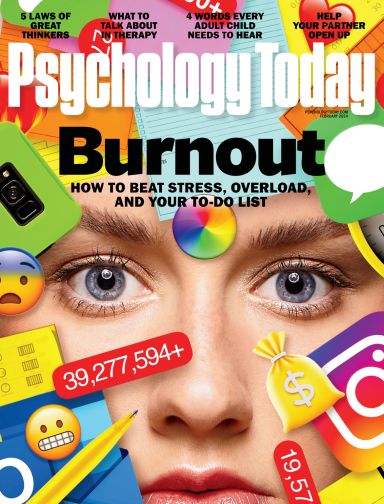
Overcome burnout, your burdens, and that endless to-do list.
- Coronavirus Disease 2019
- Affective Forecasting
- Neuroscience

Biography Narrative Essay
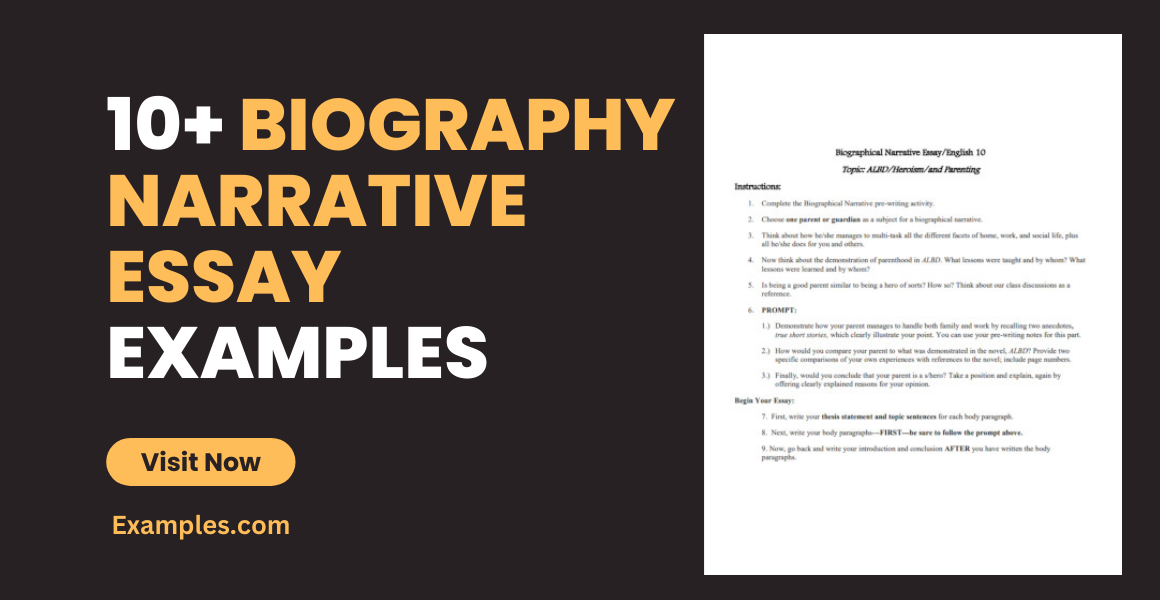
If you were given a chance to write a person’s biography, would you take that opportunity? A lot of people may see this as a good type of job to get into, while others may see this as a hobby. However you want to see it, it really is a good opportunity. Better yet, what if you are given the chance to write your own autobiography? A lot of people would take that as a chance to show their readers or the rest of the world who they are and what they can do. Of course, it is not always for everyone either. When we think of narratives we often think of the length of either an essay , a story or a speech.
But we do not often think that even a biography could be part of that idea. Often than not, we mistake biography and autobiography so much that we think they mean the same thing but with different spelling. Firstly, they are different and they do mean different things. But what does a biography narrative essay mean and what can it do for you? To find out what it can do for you, check out 10+ examples of a biography narrative essay.
10+ Biography Narrative Essay Examples
1. biography narrative essay.
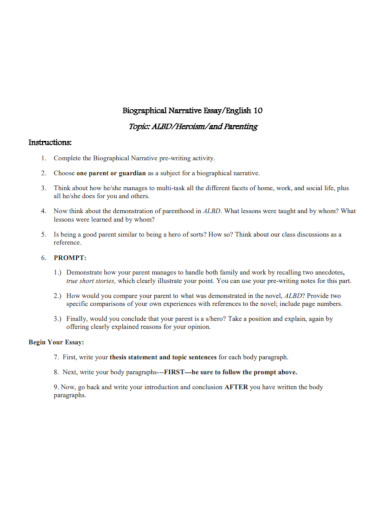
Size: 36 KB
2. Autobiographical Narrative Essay
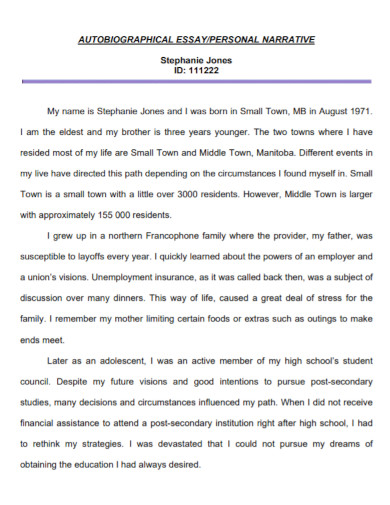
Size: 65 KB
3. Political Biography Narrative Essay
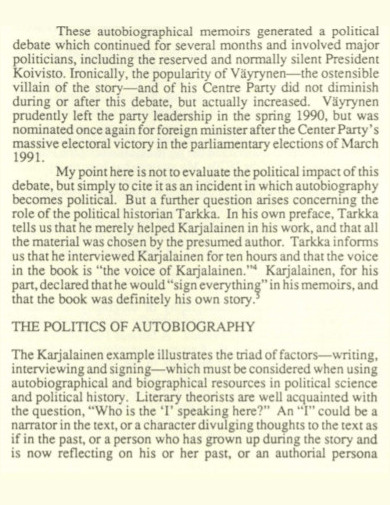
4. Biography Narrative Essay Template

Size: 164 KB
5. Basic Biography Narrative Essay
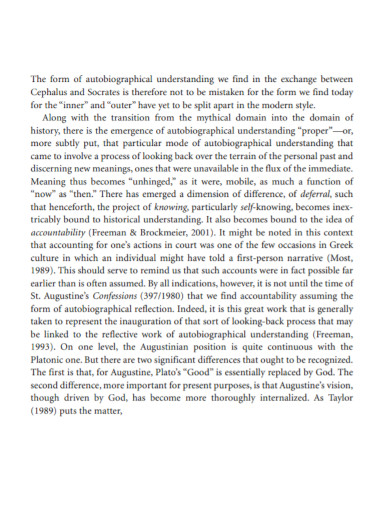
Size: 207 KB
6. Biography Narrative Agency Essay

Size: 268 KB
7. Fiction Biography Narrative Essay
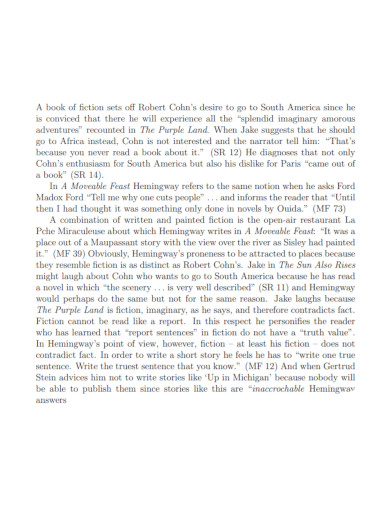
Size: 124 KB
8. Formal Biography Narrative Essay
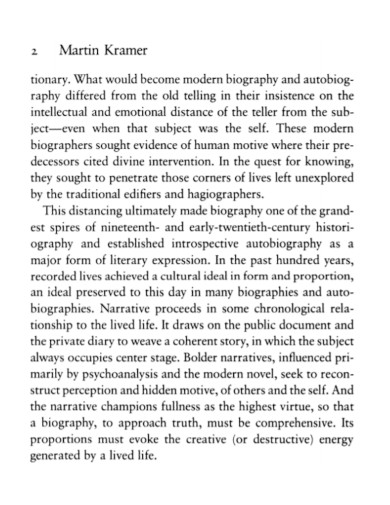
9. Budding Renaissance of Biography Narrative Essay
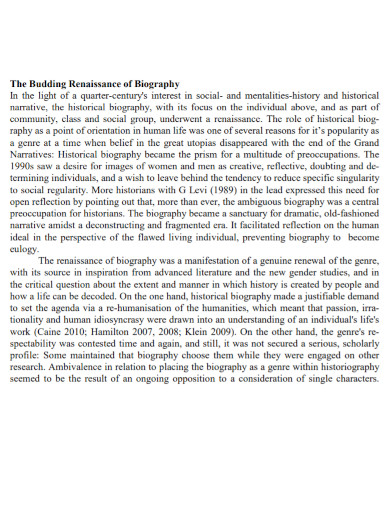
Size: 56 KB
10. Cultural Autobiography Narrative Essay
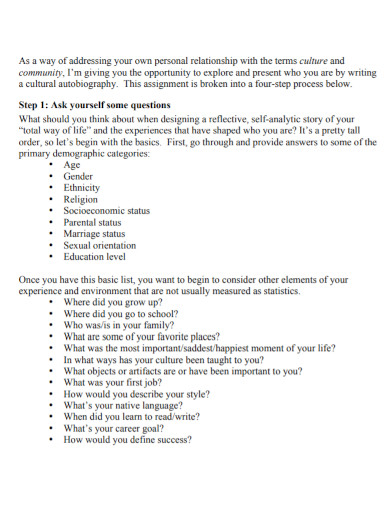
Size: 71 KB
11. Biography Narrative Essay Sheet

Size: 191 KB
What Is a Biography Narrative Essay?
We know that a biography and an autobiography are two different things, what we do not often hear is that a biography can also be used in a narrative essay . So what is a biography narrative essay ? This is a kind of narrative essay that you write when you are talking or writing about a person’s life story. This kind of essay focuses on you as the writer telling a story about a famous person like an author of a story, a poet or even an athlete. Of course you can also be writing an autobiography narrative essay, and it works just the same. The only difference is that you are writing your own story to let the world know who you are as a person.
In addition to that, you can also be writing about cultural biographies and they would work the same as you may write with a narrative essay. As long as you know what you are writing about and the difference between a biography and an autobiography. The importance of a biography narrative essay is to tell a story. To be able to tell the life story of a person you may or may not have met. As well as to be able to share it in the form of an essay.
How to Write a Biography Narrative Essay?
Having the opportunity to write a biography narrative essay is fun and exciting, but there are also things you should know about it. One of which is how and the other is why. Since we already know the reason, it is time we learned the ways to write it .
1. Do Your Personal Research First
Take some time to do your personal research first. Before you make your biography narrative essay, find time on who you are planning on talking about. Whether this person is alive or deceased also matters. To be able to make a good narrative essay from their lives, you must at least know or understand even a bit of information about them.
2. Permission Is Always Best and Professional
Getting permission from the person you are planning on writing a biography essay is also best and professional. It not only puts you in a good light, but it also shows that you take their word at heart. Asking for permission shows that you understand their need for privacy as well as the fact that you show them respect. It never hurts anyone to ask permission to whom they plan on writing a biography about.
3. Draft a Short Timeline Before You Write
To make your biography narrative essay a success, draft a short timeline before you write. This timeline could be about the events of the life of the person you are going to be writing or your own if you plan to write an autobiography. Also, drafting your work before finalizing it would make it easier for you to see which should be placed and which should be disregarded.
4. Rewrite Your Essay and Finalize Everything
When you have finished writing the draft and you are sure that it is enough and okay, you can start by rewriting your essay and finalizing everything. Of course this would take time, but it is really worth rewriting if you need to check everything first. As well as finalizing everything means you have to check if the information is correct, your grammar and spelling are fine too.
5. Read Your Biography Narrative Essay Before Passing
To be sure that you got it right, the best way to do so is to read your biography narrative essay. To make sure that the tone is right, the way you are presenting it as well. Ask someone for help to be sure that how you deliver is presentable and professional. As well as using the words in your essay that would be easy to say and explain.
What is a biography narrative essay?
A biography narrative essay is a kind of essay that is based on you writing someone’s story. An essay that focuses on a person’s life story being written down by someone else and to present it to class.
Why should you ask permission to write someone’s story?
Asking for permission is not only polite, but it also gives you a chance to see if the person wants their story known. It is also a good way for you to avoid plagiarism by having the permission from the person, rather than just to write about them and pass it off as if it were nothing.
What is one thing that should be avoided?
Writing a biography narrative, avoid any fabrications and plagiarism. To avoid this kind of mistake, do not fabricate their work and pass it as yours. Avoid fabricating anything they may say and change it to something more interesting.
Having the opportunity to write biographies for famous people is what others can say is a dream come true. A lot of people would even take the opportunity to write their own autobiographies and share it to the world. Whether you plan on writing a biography or an autobiography, there should always be things you should take into consideration. Always remember that when writing these kinds of essays, fabricating it will never get you anywhere.

Biography Narrative Essay Generator
Text prompt
- Instructive
- Professional
Write a Biography Narrative Essay on the life and achievements of Marie Curie.
Create a Biography Narrative Essay about the contributions of Martin Luther King Jr. to civil rights.
Unlocking the Power of Narrative Transformations | Dr. Julie Helmrich Potent
- Self-Improvement
How might narrative psychology change your life? On today's episode of Potent, Steven Lawson and Dr. Julie Helmrich dive into how shifting one's internal narratives could provide a hidden opportunity to 'unstuck' oneself and live a more potent life. About Today's Guest Dr Julie Helmrich is a psychologist with over 40 years of helping high achieving individuals, committed couples and small business owners shift narratives so that they can get unstuck around health issues, relationship concerns, and wealth creation. She uses an 8-step framework that puts narrative shifting FIRST so that the TACTICAL efforts at a behavior level will work. She has worked in every sector (government, corporate, not-for-profits, and has taught psychology and leadership in higher ed since 1981. Dr. Helmrich has received multiple awards and accolades for her work, but her favorite one is being named as one of Milwaukee’s Most Creative People for a program that she created and delivers called “Shrink n Drink” that thousands of people have attended. Dr Helmrich is accessible through her online programs for the public, couples, and small business owners at www.juliehelmrich.com Her SIGNATURE program is called StoryFORMULA. Show Notes 00:32 Intro - 03:52 Why Narrative Psychology? 05:15 Julie's Story 09:08 Genesis of Narrative Psychology 11:31 The Strategy: providing resources to fix problems 16:19 Iterations; Small Step Growth 18:46 A Profound Life 19:23 Self-care / Self-sufficiency 19:27 Inner Authority 21:22 Uncle Joe's Story 24:46 Quick win 27:33 Why do people do what doesn't work? 28:53 Analogies (poison) 30:51 Old Story -> Experience the impact 32:57 You only can do it for you 34:58 Fear of judgment 38:14 Shame (vs. guilt) 41:04 The role of community 46:33 Bad narratives in relationships 50:20 Argument Skills: Observation, Recovery convo, skilled dependency 54:06 Taller children, practicing skillful dependence 58:32 Practical next steps
- More Episodes
- Copyright 2024 Steven Lawson

‘Frida’ Film Explores the Life of Artist Frida Kahlo Through Her Own Narrative
I n a reflective tribute to her artistry, the new documentary titled “Frida” uses Frida Kahlo’s own writings to unravel her life story. Carla Gutiérrez, the film’s creator, intertwines Kahlo’s self-expressions, archival material, and evocative animations of her artwork, delivering a narrative now available for streaming on Prime Video.
Originally from Peru and relocating to the U.S. during her teenage years, Gutiérrez found an emotional connection to Kahlo’s work during her time in college.
“The moment that cemented my affinity with her was when I discovered a piece illustrating the juxtaposition of the U.S.-Mexico border,” Gutiérrez mentioned in an interview with The Associated Press. “Her art resonated with my immigrant experience and from that point on, she was an integral part of my life’s journey,” she added.
Although Gutiérrez began her career as an editor, working on inspiring projects like “RBG” and “Julia,” the lure to direct was ignited upon reconsidering Kahlo’s story. Her decision to direct transmuted rapidly after revisiting biographical materials on Kahlo that she’d encountered in her years at college.
“It was almost as if the story summoned me to this role,” Gutiérrez expressed. “I realized that using her own words to articulate her narrative could offer unprecedented insight into her essence, her mind, and spirit — something I felt was yet to be fully explored through film,” she affirmed.
Gutiérrez describes Kahlo’s seldom-recorded interviews as less influential than her heartfelt, witty, and audaciously opinionated letters. She remarked on Kahlo’s “beautifully chaotic confidence and feminism.”
The documentary’s exceptional narrative is built upon a myriad of Kahlo’s correspondences, curated from various institutions, including the Frida Kahlo Museum in Mexico City, the National Museum of Women in the Arts, and the Philatelic Museum of Oaxaca. These letters offer intimate glimpses into her marriage, her miscarriages, and more.
Animating Kahlo’s artwork throughout the documentary was a significant and somewhat controversial stylistic choice, but this creative element was central from the film’s conception. Gutiérrez sought to engulf viewers in Kahlo’s emotional landscape, transforming the experience of her artworks beyond their physicality.
Gutiérrez takes pride in collaborating with a mostly Latinx and bilingual group of creators, all bringing forth a cultural consciousness and authenticity to the work.
What new perspective does the ‘Frida’ documentary aim to provide?
The documentary aims to present a more intimate, personal perspective of Frida Kahlo by using her own writings to narrate her life and thoughts.
Who directed the ‘Frida’ documentary?
Carla Gutiérrez is the filmmaker behind the documentary “Frida.”
Where can I stream the ‘Frida’ documentary?
The film is available for streaming on Prime Video.
Why was the decision to animate Frida Kahlo’s artwork considered divisive?
While some appreciated the animated artworks as an immersive experience into Kahlo’s emotions, others did not favor the alteration of her original art pieces.
In “Frida,” Carla Gutiérrez has crafted a beautifully intricate tapestry of Frida Kahlo’s life and work by letting the artist speak for herself through her lingering words. Balancing historical reverence and creative expression, the documentary aspires to welcome viewers into the passionate and complex world of Frida Kahlo, creating an intimate connection with the iconic artist that transcends time and medium. As it streams on platforms like Prime Video, “Frida” offers both Kahlo’s admirers and newcomers a chance to engage with her story on a profoundly human level.

The Christian Post
To enjoy our website, you'll need to enable JavaScript in your web browser. Please click here to learn how.
You are using an outdated browser. Please upgrade your browser to improve your experience.
Recommended

Riley Gaines, female athletes sue NCAA for letting males compete against women

Is 'Christian nationalism' a real threat or diabolical political tool conjured to silence believers?

Suspected terrorists entering US with fake IDs, crossing southern border, FBI head says

5 interesting excerpts from the Biden-Hur transcripts

Dr. WA Criswell: Hero of the faith and inspiration to us all

Why Lee Strobel lost faith in atheism

The moral case for embracing polarization

Ask Chuck: Tips for saving money on income taxes

Bribing future generations for Marx?

John MacArthur vs. Christian nationalism
Anthony hopkins drama 'one life' honors 'british schindler' who saved over 600 children amid holocaust.

In an era marked by global unrest — particularly in the Middle East — the film "One Life," which tells the true story of Nicholas Winton, who helped secure the rescue of 669 children, most of them Jewish, amid the horrors of World War II, emerges as a profound narrative of hope and human resilience.
“I wish the film wasn't so timely,” director James Hawes told The Christian Post. “But I guess what it tells you is the strength of history to teach us about where we are now, the power of the human spirit to endure.”
Starring Anthony Hopkins, Johnny Flynn, Helena Bonham Carter, Alex Sharp and Romola Garai, “One Life” is based on the book If It’s Not Impossible … the Life of Sir Nicholas Winton . The film follows Winton, a young London stockbroker who would become an unsung hero of WWII, eventually earning him the moniker “the British Schindler.”

Get Our Latest News for FREE
Set against the backdrop of 1930s Europe on the brink of war, the film blends past and present, offering a stirring narrative that brings to life Winton's extraordinary act of courage.
In flashbacks to 1970s England, viewers are introduced to an older Winton (Hopkins), who is reflecting on his past, a time when he was a much younger man in Czechoslovakia during the tense days of 1938-39.
Winton, alongside characters like Doreen (Garai) and Trevor (Sharp), finds himself leading an unlikely group of Czech and British volunteers. They are driven by a singular mission: to evacuate 669 children, predominantly Jewish, from Czechoslovakia to Britain. This act of bravery is further supported by Winton's mother, Babette (Bonham Carter), who becomes an integral part of the mission from England.
The film explores the emotional depth of Winton’s experience, balancing themes of guilt, redemption, and grief while highlighting his heroic acts. He struggles with the memories of the children he wasn’t able to save. Though, by 1987, a staggering 6,000 people owed their lives to his selfless actions.
Winton, who died in 2015 at 106, had been widely recognized for his extraordinary deeds by the time of his death. In 2003, he was knighted by Queen Elizabeth II for "services in humanity, in saving Jewish children from Nazi-occupied Czechoslolvokia."
“You meet this man who has an element of grief and regret and you're not sure why,” Hawes said. “But you see his story through to his redemption and the celebration of what he's achieved at the end.”
‘You don’t want it to be grim fest, but equally, you've got to characterize this character who's carrying this burden of darkness from his own history, and then that becomes part of the story,” he added. “There are some powerful scenes for me where he's faced with the truth of what probably happened to the children he didn't manage to save, and he has to walk away from that question. And he says this very powerful thing: ‘I’ve tried to put a lid on that because to remain useful, I can't allow myself to imagine what happened next.’ You meet quite an intriguing portrayal of grief and regret. At the same time, you get this dynamic story of the Prague rescue and the saving of children.”
Though it's a Holocaust film, “One Life’ refrains from graphically depicting atrocities, opting instead for an approach that makes the narrative more palatable and less graphic for viewers (it's rated PG). There are several scenes depicting the conditions in the refugee camps, the violence of the Nazi invasion, and the emotional toll on Winton himself.
In one particularly heart-wrenching scene, parents bid farewell to their children at a train station, sending them off to safety as they themselves face an uncertain future. Garai told CP the scene was particularly memorable as it was filmed in the actual location where the event took place, decades ago.
“These children were 3 or 4 years old, and hundreds of children were crowded onto the main train station in Prague and they had to say goodbye to their families,” she said. “Their parents had to put them on these trains and wave goodbye to them, sending them to travel across Europe, through Nazi Germany, to Britain to foster families in the U.K. We recreated those scenes on the platform where that event actually occurred with hundreds of children dressed up in period outfits. It was truly eerie and quite emotionally overwhelming for everyone involved.”
Through “One Life,” Hawes said he wanted to honor Winton and the collective effort of those who stood with him while celebrating the triumph of humanity and compassion in the face of overwhelming adversity.
“I think you learn that you, as an individual, never do quite enough, that you can be disappointed with yourself and want to do more,” the director said. “I don't want to sermonize, but it does challenge you to be more active when you talk about what's grim in the world. Well, what are you doing to try and put that right? It's not enough to make judgments on what's wrong out there. It's about finding ways, little ways, just achievable ways that you can try and improve it, and that was very much Nicholas’ ethos.”
And both Hawes and Garai emphasized the film’s relevance in today’s sociopolitical climate. It's a story that, though set in the past, carries a timeless message, they said, a call to action to every person to use their life for the greater good.
"The film is a poignant reminder of the ongoing cycles of violence and the power of individual intervention," Garai said.
Hawes added, “I hope viewers re-examine what we mean by the word ‘refugee,’ because it conjures, especially in today's politics, so many negative dark and threatening things.
“When you look at it, Nicholas Winton, who did all this extraordinary good work, was himself a first-generation child of refugees. The children he saved have gone on in this country and around the world, in the United States, Canada and Israel to become real contributors to society, scientists, journalists, artists and politicians. Those were all refugees. We need to recalibrate how we approach that problem in a world that is so much more interconnected than it once was.”
"One Life" hits theaters on March 15. Watch the trailer below.
Leah M. Klett is a reporter for The Christian Post. She can be reached at: [email protected]
Was this article helpful?
Help keep The Christian Post free for everyone.
By making a recurring donation or a one-time donation of any amount, you're helping to keep CP's articles free and accessible for everyone.
We’re sorry to hear that.
Hope you’ll give us another try and check out some other articles. Return to homepage.
CS Lewis' 'Prince Caspian' hits the stage at Museum of the Bible; script vetted by author's stepson
Easter film 'forty-seven days with jesus' presents gospel in reverent, entertaining way: producer, dennis quaid, 'jesus revolution' and 'sound of freedom' win big at movieguide awards, 'kung fu panda 4' balances redemption, change, judgment with kid-friendly humor: director, most popular.

Kamala Harris prompts outrage with historic tour of Minnesota abortion clinic: 'Unbelievable'

Jack Hibbs tackles predestination, free will: 'Those in Hell are responsible for being there'

Tennessee megachurch performs 93 spontaneous baptisms in 1 day: 'God just spoke'

More Articles

Asylum seekers ‘melt away’ when asked to be involved in church before baptisms, priest says

Washington National Cathedral clergy sprinkle holy water on NCAA mascots

Group of Brands
Title: ‘An Outlet for Narrative’ – Reflections from an Irish Dancer on St. Patrick’s Day
Looking ahead to St. Patrick’s Day celebrations, we sat down with a graduate student raised in the tradition of Irish dance to get a personal reflection on what this time of year means to them.
Meet Siobhan Cooney (G’26): she is a part-time master’s student in the Communication, Culture & Technology program at the Graduate School and works at the Berkley Center for Religion, Peace, and World Affairs as a Communications Associate.
“Irish dance transcends geographical and interpersonal boundaries and brings people together in such a beautiful way,” says Cooney. Explore her lived experiences learning Irish dance and celebrating this annual cultural event.
Connection to Heritage & Competitive Performer

“I come from a very large Irish family on my dad’s side, and with such a traditional name of Siobhan, it was almost preordained that I would connect to my heritage in a deep way.
“I started Irish dancing when I was five years old and I haven’t stopped since! This path has led me to become an Open Championship competitor, a proud performer, and a candidate to become a certified Irish dance instructor. It has truly been the biggest influence in my life.
“What I love about Irish dance is that it’s more than just a historical art form; it’s an incredible combination of culture, artistry and athleticism. It’s more than just fancy choreography and lively music; it’s an expressive outlet for narrative.
“My experience as an Irish dancer has taken me all across the country, where I’ve trained and competed alongside fellow dancers from all kinds of ethnic and racial backgrounds. Irish dance transcends geographical and interpersonal boundaries and brings people together in such a beautiful way.”
“Irish dance is more than just a historical art form; it’s an incredible combination of culture, artistry and athleticism. ” – Siobhan Cooney

“I’m so grateful to have the ability to keep in step with my passion while working and studying here in Washington, DC, through choreographing, performing and teaching at District Irish Dance Academy.
“Outside the studio, I’m a contributing writer for The Irish Dance Globe , the leading dancer-run publication for all things related to Irish dance, music, and culture.
“I’m so excited for St. Patrick’s Day this year. Ever since I started dancing, the holiday season has always been filled with parades, parties and even impromptu step-abouts at local pubs. I love listening to live traditional “trad” music and getting together with friends and family.
Related Content

- Community in Diversity ,
- Student Experience
Opinion: What a doctor sees when Joe Biden hesitates

- Show more sharing options
- Copy Link URL Copied!
As a geriatrician, I discuss the effects of aging with patients every day. I wish I had a chance to give my usual talk to everyone who chortles or tears their hair out about President Biden’s fitness for his job.
First, memory. I explain to patients that there are three components to consider. One is formation. Then storage. And, finally, recall. The most common issue among seniors is slow recall. This is the familiar “tip of the tongue” phenomenon, when a word seems to hide or a name won’t come to mind. You know the name, it’s in your bank of memories, it just can’t be accessed quickly. Given time, it usually arrives.
This problem, called age-associated memory impairment, often starts for people in their 30s and gradually progresses. It’s a nuisance but not disabling. If, like me, you find yourself using the term “whatchamacallit,” you probably have it. Don’t worry, you’ll be fine.

Opinion: Dump Biden? Here’s why nominating another Democrat for president would be a mistake
Despite concerns about his age, polling against Trump and the “uncommitted” movement in the Michigan primary, the party has no other viable option in the 2024 election.
Feb. 28, 2024
Alzheimer’s disease, the most common cause of dementia, is a different story. Those affected lose the ability to store new memories. They can still access old memories in their memory bank and may recount events that occurred decades ago. But they can’t tell you what they had for breakfast because that never entered the memory bank. (I reassure my patients with age-associated memory impairment by asking whether they remember their breakfast. They do.)
Alzheimer’s is cognitively crippling. Losing the ability to form new memories freezes one in time. Those affected can’t make new friends or address new situations without fresh memories. Additionally, the disease progressively impairs other domains, including behavior and ultimately physical skills.
Fortunately, President Biden shows no signs of Alzheimer’s disease. At news conferences, he references new events and obviously creates new memories efficiently. He speaks slowly and pauses to find words like others with benign age-associated memory impairment. These issues are exacerbated by a chronic speech impediment. Biden has struggled with stuttering since childhood , and remnants of the condition have long been apparent in his speech.
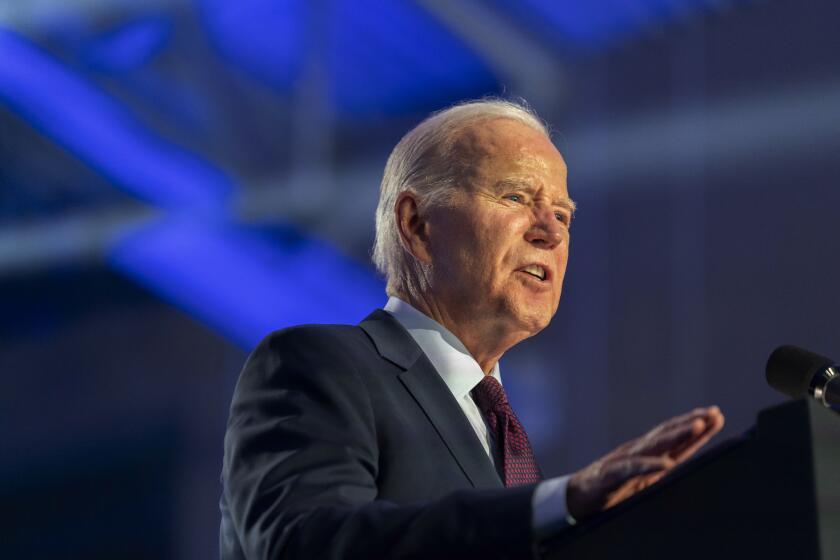
Opinion: Age matters. Which is why Biden’s age is his superpower
Joe Biden was socialized in an era when governments took on big causes — think the Great Society — and its reflected in the accomplishments of his first term and the potential of a second.
Feb. 9, 2024
Unfortunately, word hesitations coupled with the mild stutter can’t help but affect his public speaking. Biden’s political opponents and the uninformed exploit it, along with stereotypes about older people, to create a false narrative about intellectual impairment.
I take care of many high-functioning seniors like President Biden in my practice. One that I know, who is not a patient of mine, has been my family’s lawyer for five decades. Melvin Spears, at 96, recently responded to an emailed legal question with succinct and well-targeted advice, as he always has. When I spoke to him, he acknowledged some concessions to his age. He speaks more slowly, and transportation is a challenge because he’s stopped driving. (He considers Uber and Lyft “a hassle.”) Like Biden, Spears focuses on his work and lets others worry about his age if they choose.
Studies show that high-functioning seniors like Mel Spears and the president compensate for slower reaction time by applying superior knowledge and judgment. The presidency is not a job that requires lightning-quick reflexes. First-hand experience with the successes and failures of U.S. foreign policy over decades, for example, combined with time-tested judgment offers far more than speed in speech or decision-making.

Calmes: Biden’s polls aren’t great. How much is the media’s fault?
The media’s ‘but his age’ meme is its way of evening the score with its criticisms of Donald Trump. Would Biden’s approval ratings look better without the bothsides-ism?
Feb. 14, 2024
Actuarial tables show that the 81-year-old president’s life expectancy extends nearly eight years, well beyond a second term. He gets excellent healthcare, has no major chronic illnesses, and at his recent physical at Walter Reed Military Medical Center, he was declared “healthy, active” and “fit for duty.” All that means that Biden is likely to beat the actuarial estimate. Given his overall health and the absence of current cognitive impairment, he would likely complete a second term with stable cognition.
All candidates for political office in the United States deserve to be evaluated on their accomplishments and capabilities rather than by their age. Seniors may be the last minority whose natural traits are singled out for ridicule and stereotyping. If the American people disagree with President Biden’s policies and prefer change, they should support his opponent. But in the absence of valid evidence of true cognitive impairment, their judgment should not be influenced by ageist social stereotypes. Biden and the American political process deserve better.
Daniel J. Stone is an internist and geriatrician in Beverly Hills.
More to Read
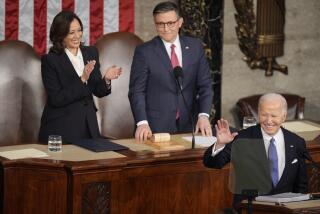
Letters to the Editor: Could you perform like 81-year-old Joe Biden in the State of the Union address?
March 11, 2024
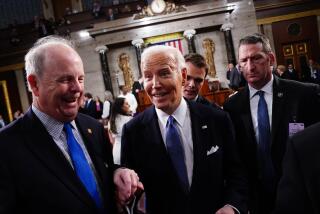
Abcarian: Chill out, my fellow Americans. Your president isn’t cognitively impaired
March 8, 2024
Takeaways from Biden’s State of the Union address: Combative attacks on a foe with no name
March 7, 2024
A cure for the common opinion
Get thought-provoking perspectives with our weekly newsletter.
You may occasionally receive promotional content from the Los Angeles Times.
More From the Los Angeles Times

Willis can stay on Georgia Trump case only if former romantic partner leaves, judge says

Opinion: What I’ve learned about living alone after losing my wife of 42 years
March 15, 2024

Column: Polls get it right most of the time. Here’s what to be wary of

Opinion: Apocalypse now, but not in Santa Monica
- Today's news
- Reviews and deals
- Climate change
- 2024 election
- Fall allergies
- Health news
- Mental health
- Sexual health
- Family health
- So mini ways
- Unapologetically
- Buying guides
Entertainment
- How to Watch
- My watchlist
- Stock market
- Biden economy
- Personal finance
- Stocks: most active
- Stocks: gainers
- Stocks: losers
- Trending tickers
- World indices
- US Treasury bonds
- Top mutual funds
- Highest open interest
- Highest implied volatility
- Currency converter
- Basic materials
- Communication services
- Consumer cyclical
- Consumer defensive
- Financial services
- Industrials
- Real estate
- Mutual funds
- Credit cards
- Credit card rates
- Balance transfer credit cards
- Business credit cards
- Cash back credit cards
- Rewards credit cards
- Travel credit cards
- Checking accounts
- Online checking accounts
- High-yield savings accounts
- Money market accounts
- Personal loans
- Student loans
- Car insurance
- Home buying
- Options pit
- Investment ideas
- Research reports
- Fantasy football
- Pro Pick 'Em
- College Pick 'Em
- Fantasy baseball
- Fantasy hockey
- Fantasy basketball
- Download the app
- Daily fantasy
- Scores and schedules
- GameChannel
- World Baseball Classic
- Premier League
- CONCACAF League
- Champions League
- Motorsports
- Horse racing
- Newsletters
New on Yahoo
- Privacy Dashboard
Bowen Yang Defends Ariana Grande, Says the “Narrative Is Wrong”
- Oops! Something went wrong. Please try again later. More content below
Bowen Yang defended his Wicked costar Ariana Grande during his Las Culturistas podcast, saying the narrative about her (specifically around interpretations of her new music) is wrong.
“The narrative is wrong,” Bowen said. “And she’s not even outwardly saying that, but the narrative has been incorrect, and people have even retracted things in these stories with no fucking apology to the people who are involved. I can tell you for a fact that what people out there seem to be clinging onto is incorrect.”
https://t.co/LQIm3tEhoO — Pop Crave (@PopCrave) March 15, 2024
Bowen’s statement comes amid a report that Ethan Slater’s estranged wife Lilly Jay is not happy about Ari’s song “The Boy Is Mine.”
A source close to Lilly told the Daily Mail , “To sing a song called ‘The Boy Is Mine’ is not only a slap in the face to his still wife Lilly but a slap in the face to all women.”
The source added that Lilly thinks “Ariana is not a girl’s girl” and that the singer “basically rubbed it in Lilly’s face that she stole Ethan from Lilly then asks her fans to not interpret her song the wrong way. This is not an interpretation. It is her literal words.”
Continuing to insist that “Ariana left nothing up to interpretation,” the insider continued that “those close to Lilly believe she did this because she is upset that Ethan’s divorce is still dragging out. She wants him all to herself and feels that—because he is still legally married—she cannot truly have him. Everyone close to Lilly and who knows Ethan is just waiting for karma to slap him and Ariana in the face. It will come.”
For what it’s worth, (1) Ariana hasn’t at all confirmed who/what “The Boy Is Mine” is about and (2) a source recently told Us Weekly , “Ariana is playing with different characters, some of the lyrics come from her personal life, but others are just her playing a fun character for her fans.”
You Might Also Like
Here’s What NOT to Wear to a Wedding
Meet the Laziest, Easiest Acne Routine You’ll Ever Try
Recommended Stories
Ariana grande returns with 'eternal sunshine': from track list to early reviews, what to know about her 'divorce album'.
Ariana Grande opens up on her seventh studio album, "Eternal Sunshine."
2024 Porsche Panamera; Rivian's surprise; Cadillac electrifies V | Autoblog Podcast #823
In this week's podcast, Greg and Byron talk Ford Maverick Tremor, Porsche Panamera, Rivian's surprise reveal and the future of performance at Cadillac.
'What's In My Wallet': Pianowski's 2024 fantasy baseball draft targets
Fantasy baseball analyst Scott Pianowski reveals the list of players he's trying to leave every draft with in 2024.
2024 Fantasy Baseball Draft Blueprint: It's time to choose your own adventure!
It's finally here — Scott Pianowski offers a complete blueprint to crushing your fantasy baseball drafts and building successful teams for the 2024 MLB season.
The 40+ best early Amazon Big Spring Sale deals this weekend: Save up to 80% on vacuums, AirPods and more
Score steep discounts on top brands like Apple, Cuisinart and Beats.
Mike Vrabel reportedly hired by Browns as coaching and personnel consultant
Vrabel was fired by the Titans in January after a 6-11 season.
NBA Fact or Fiction: Can the Thunder win it all without playoff scars?
Most NBA champions develop playoff scars before finally breaking through. What does that mean for a young OKC squad this year?
How to verify a data breach
Over the years TechCrunch has extensively covered data breaches. In fact, some of our most-read stories have come from reporting on huge data breaches, such as revealing shoddy security practices at startups holding sensitive genetic information through to disproving privacy claims by a popular messaging app. It's not just our sensitive information that can spill online.
Ditch the salon and snag this 'godsend' permanent hair-removal tool while it's over 40% off
More than 7,000 five-star fans say it has your back — and your upper lip, chin, armpits or any other place you want to banish rogue strands.
'Like a hot knife through butter': You need this $40 mini chain saw for spring pruning — it's 50% off
Put those bulky power tools away: This handy helper weighs in at under 3 pounds.

biography, form of literature, commonly considered nonfictional, the subject of which is the life of an individual.One of the oldest forms of literary expression, it seeks to re-create in words the life of a human being—as understood from the historical or personal perspective of the author—by drawing upon all available evidence, including that retained in memory as well as written, oral ...
Biography, autobiography, and memoir are the three main forms used to tell the story of a person's life. Though there are similarities between these forms, they have distinct differences in terms of the writing, style, and purpose. A biography is an informational narrative and account of the life history of an individual person, written by someone who is not the subject of the biography.
7. Get feedback and polish the text. If you're going to self-publish your biography, you'll have to polish it to professional standards. After leaving your work to rest for a while, look at it with fresh eyes and self-edit your manuscript eliminating passive voice, filler words, and redundant adverbs.
The ability to create a life narrative takes a little while to come online—the development process gives priority to things like walking, talking, and object permanence. Young children can tell ...
A biography (BYE-og-ruh-fee) is a written account of one person's life authored by another person. A biography includes all pertinent details from the subject's life, typically arranged in a chronological order. The word biography stems from the Latin biographia, which succinctly explains the word's definition: bios = "life" + graphia ...
A literary biography is the biographical exploration of individuals' lives merging historical facts with the conventions of narrative. [1] Biographies about artists and writers are sometimes some of the most complicated forms of biography. [2] Not only does the author of the biography have to write about the subject of the biography but also ...
Summary. Since 1990, "life writing" has become a frequently used covering term for the familiar genres of biography, autobiography, memoir, diaries, letters, and many other forms of life narrative. Initially adopted as a critical intervention informed by post-structuralist, postmodernist, postcolonial, and especially feminist theory of the ...
Both memoir and autobiography are encompassed in the term life writing. We understand life narrative, by contrast, as a general term for acts of self-presentation of all kinds and in diverse media that take the producer's life as their subject, whether written, performative, visual, filmic, or digital. 4 Close In other words, we employ the ...
Memoir is a story based on your life experience and what you have learned from it. It is a winnowing of all that has happened into a tight view of a slim section of experience: the coming of age years; the head-spinning start of a career; early motherhood. But always, it is a winnowing of the vast, complicated arc of events that has constituted ...
Definition of Biography. A biography is a description of a real person's life, including factual details as well as stories from the person's life. Biographies usually include information about the subject's personality and motivations, and other kinds of intimate details excluded in a general overview or profile of a person's life.
Outline your biography, ensuring a logical and engaging narrative flow. Consider the chronological order, significant milestones, and turning points in the subject's life. Organize your gathered information to capture the essence of their journey while maintaining a compelling rhythm throughout.
A biography should be written in a narrative style, capturing the essence of the person's life through vivid descriptions, anecdotes, and quotes. Avoid dry, factual writing and focus on creating a compelling narrative that engages the reader.
Using flashbacks allows the author to introduce relevant past information to the reader without bogging them down with paragraphs of background exposition. 6. Include your thoughts. A biography isn't just a transaction of facts. A biographer can share their own feelings and opinions on their subject's life.
Biography's relationship to autobiography, memoir, and narrative research in education is well developed and will continually be redefined (Denzin, 1989; Epstein, 1991; Rollyson, 2008) Yet, with the emerging interest in biographical inquiry and with some growing interest in prosopography (group biography), little consensus of terminology ...
According to Corbally and O'Neill (), investigation of a narrative allows researchers to examine an individual's lived experiences in more depth.A biographical approach provides a great deal of insight into the choices that an individual makes throughout their life and the changing nature of decisions made during various times in one's life (Corbally & O'Neill, 2014).
Source: Unsplash. Whether or not we are truly inventors of our own lives, we certainly are inventors of the story of our lives. For some, this story is clear and in the forefront of their minds ...
3. Draft a Short Timeline Before You Write. To make your biography narrative essay a success, draft a short timeline before you write. This timeline could be about the events of the life of the person you are going to be writing or your own if you plan to write an autobiography. Also, drafting your work before finalizing it would make it easier ...
Here are some steps you can follow to help you write a successful short bio: 1. Choose a voice. The first step in writing a short bio is deciding on a voice. For our purposes, choosing a voice involves deciding whether you are writing in the first or third person. Writing in the first person means using the words "I" and "me", and writing in ...
How might narrative psychology change your life? On today's episode of Potent, Steven Lawson and Dr. Julie Helmrich dive into how shifting one's internal narratives could provide a hidden opportunity to 'unstuck' oneself and live a more potent life. About Today's Guest Dr Julie Helmrich is a psychol…
The documentary's exceptional narrative is built upon a myriad of Kahlo's correspondences, curated from various institutions, including the Frida Kahlo Museum in Mexico City, the National ...
Biography - Character Sketches: The short life, however, is a genuine current in the mainstream of biographical literature and is represented in many ages and cultures. Excluding early quasi-biographical materials about religious or political figures, the short biography first appeared in China at about the end of the 2nd century bce, and two centuries later it was a fully developed literary ...
"One Life" | Warner Bros. In an era marked by global unrest — particularly in the Middle East — the film "One Life," which tells the true story of Nicholas Winton, who helped secure the rescue of 669 children, most of them Jewish, amid the horrors of World War II, emerges as a profound narrative of hope and human resilience.
March 14, 2024. Looking ahead to St. Patrick's Day celebrations, we sat down with a graduate student raised in the tradition of Irish dance to get a personal reflection on what this time of year means to them. Meet Siobhan Cooney (G'26): she is a part-time master's student in the Communication, Culture & Technology program at the Graduate ...
Feb. 9, 2024. Unfortunately, word hesitations coupled with the mild stutter can't help but affect his public speaking. Biden's political opponents and the uninformed exploit it, along with ...
Wall Street is surprised to watch this company come to life after it was left for dead. Shares of advertising technology (adtech) company Cardlytics ( CDLX 52.72%) absolutely skyrocketed on Friday ...
Bowen Yang defended his Wicked costar Ariana Grande during his Las Culturistas podcast, saying the narrative about her (specifically around interpretations of her new music) is wrong. "The ...
- business plan
- course work
- research paper
hypothesis testing using spss
University library, university of illinois at urbana-champaign.

SPSS Tutorial: General Statistics and Hypothesis Testing
- About This Tutorial
- SPSS Components
- Importing Data
- General Statistics and Hypothesis Testing
- Further Resources
Merging Files based on a shared variable.
This section and the "Graphics" section provide a quick tutorial for a few common functions in SPSS, primarily to provide the reader with a feel for the SPSS user interface. This is not a comprehensive tutorial, but SPSS itself provides comprehensive tutorials and case studies through it's help menu. SPSS's help menu is more than a quick reference. It provides detailed information on how and when to use SPSS's various menu options. See the "Further Resources" section for more information.
To perform a one sample t-test click "Analyze"→"Compare Means"→"One Sample T-Test" and the following dialog box will appear:

The dialogue allows selection of any scale variable from the box at the left and a test value that represents a hypothetical mean. Select the test variable and set the test value, then press "Ok." Three tables will appear in the Output Viewer:

The first table gives descriptive statistics about the variable. The second shows the results of the t_test, including the "t" statistic, the degrees of freedom ("df") the p-value ("Sig."), the difference of the test value from the variable mean, and the upper and lower bounds for a ninety-five percent confidence interval. The final table shows one-sample effect sizes.
- One-Way ANOVA
In the Data Editor, select "Analyze"→"Compare Means"→"One-Way ANOVA..." to open the dialog box shown below.

To generate the ANOVA statistic the variables chosen cannot have a "Nominal" level of measurement; they must be "ordinal."
Once the nominal variables have been changed to ordinal, select "the dependent variable and the factor, then click "OK." The following output will appear in the Output Viewer:

Linear Regression
To obtain a linear regression select "Analyze"->"Regression"->"Linear" from the menu, calling up the dialog box shown below:

The output of this most basic case produces a summary chart showing R, R-square, and the Standard error of the prediction; an ANOVA chart; and a chart providing statistics on model coefficients:

For Multiple regression, simply add more independent variables in the "Linear Regression" dialogue box. To plot a regression line see the "Legacy Dialogues" section of the "Graphics" tab.
Scholarly Commons
- << Previous: Importing Data
- Next: Graphics >>
- Last Updated: Mar 1, 2024 4:56 PM
- URL: https://guides.library.illinois.edu/spss
Have a language expert improve your writing
Run a free plagiarism check in 10 minutes, generate accurate citations for free.
- Knowledge Base
Hypothesis Testing | A Step-by-Step Guide with Easy Examples
Published on November 8, 2019 by Rebecca Bevans . Revised on June 22, 2023.
Hypothesis testing is a formal procedure for investigating our ideas about the world using statistics . It is most often used by scientists to test specific predictions, called hypotheses, that arise from theories.
There are 5 main steps in hypothesis testing:
- State your research hypothesis as a null hypothesis and alternate hypothesis (H o ) and (H a or H 1 ).
- Collect data in a way designed to test the hypothesis.
- Perform an appropriate statistical test .
- Decide whether to reject or fail to reject your null hypothesis.
- Present the findings in your results and discussion section.
Though the specific details might vary, the procedure you will use when testing a hypothesis will always follow some version of these steps.
Table of contents
Step 1: state your null and alternate hypothesis, step 2: collect data, step 3: perform a statistical test, step 4: decide whether to reject or fail to reject your null hypothesis, step 5: present your findings, other interesting articles, frequently asked questions about hypothesis testing.
After developing your initial research hypothesis (the prediction that you want to investigate), it is important to restate it as a null (H o ) and alternate (H a ) hypothesis so that you can test it mathematically.
The alternate hypothesis is usually your initial hypothesis that predicts a relationship between variables. The null hypothesis is a prediction of no relationship between the variables you are interested in.
- H 0 : Men are, on average, not taller than women. H a : Men are, on average, taller than women.
Receive feedback on language, structure, and formatting
Professional editors proofread and edit your paper by focusing on:
- Academic style
- Vague sentences
- Style consistency
See an example

For a statistical test to be valid , it is important to perform sampling and collect data in a way that is designed to test your hypothesis. If your data are not representative, then you cannot make statistical inferences about the population you are interested in.
There are a variety of statistical tests available, but they are all based on the comparison of within-group variance (how spread out the data is within a category) versus between-group variance (how different the categories are from one another).
If the between-group variance is large enough that there is little or no overlap between groups, then your statistical test will reflect that by showing a low p -value . This means it is unlikely that the differences between these groups came about by chance.
Alternatively, if there is high within-group variance and low between-group variance, then your statistical test will reflect that with a high p -value. This means it is likely that any difference you measure between groups is due to chance.
Your choice of statistical test will be based on the type of variables and the level of measurement of your collected data .
- an estimate of the difference in average height between the two groups.
- a p -value showing how likely you are to see this difference if the null hypothesis of no difference is true.
Based on the outcome of your statistical test, you will have to decide whether to reject or fail to reject your null hypothesis.
In most cases you will use the p -value generated by your statistical test to guide your decision. And in most cases, your predetermined level of significance for rejecting the null hypothesis will be 0.05 – that is, when there is a less than 5% chance that you would see these results if the null hypothesis were true.
In some cases, researchers choose a more conservative level of significance, such as 0.01 (1%). This minimizes the risk of incorrectly rejecting the null hypothesis ( Type I error ).
Prevent plagiarism. Run a free check.
The results of hypothesis testing will be presented in the results and discussion sections of your research paper , dissertation or thesis .
In the results section you should give a brief summary of the data and a summary of the results of your statistical test (for example, the estimated difference between group means and associated p -value). In the discussion , you can discuss whether your initial hypothesis was supported by your results or not.
In the formal language of hypothesis testing, we talk about rejecting or failing to reject the null hypothesis. You will probably be asked to do this in your statistics assignments.
However, when presenting research results in academic papers we rarely talk this way. Instead, we go back to our alternate hypothesis (in this case, the hypothesis that men are on average taller than women) and state whether the result of our test did or did not support the alternate hypothesis.
If your null hypothesis was rejected, this result is interpreted as “supported the alternate hypothesis.”
These are superficial differences; you can see that they mean the same thing.
You might notice that we don’t say that we reject or fail to reject the alternate hypothesis . This is because hypothesis testing is not designed to prove or disprove anything. It is only designed to test whether a pattern we measure could have arisen spuriously, or by chance.
If we reject the null hypothesis based on our research (i.e., we find that it is unlikely that the pattern arose by chance), then we can say our test lends support to our hypothesis . But if the pattern does not pass our decision rule, meaning that it could have arisen by chance, then we say the test is inconsistent with our hypothesis .
If you want to know more about statistics , methodology , or research bias , make sure to check out some of our other articles with explanations and examples.
- Normal distribution
Descriptive statistics
- Measures of central tendency
- Correlation coefficient
Methodology
- Cluster sampling
- Stratified sampling
- Types of interviews
- Cohort study
- Thematic analysis
Research bias
- Implicit bias
- Cognitive bias
- Survivorship bias
- Availability heuristic
- Nonresponse bias
- Regression to the mean
Hypothesis testing is a formal procedure for investigating our ideas about the world using statistics. It is used by scientists to test specific predictions, called hypotheses , by calculating how likely it is that a pattern or relationship between variables could have arisen by chance.
A hypothesis states your predictions about what your research will find. It is a tentative answer to your research question that has not yet been tested. For some research projects, you might have to write several hypotheses that address different aspects of your research question.
A hypothesis is not just a guess — it should be based on existing theories and knowledge. It also has to be testable, which means you can support or refute it through scientific research methods (such as experiments, observations and statistical analysis of data).
Null and alternative hypotheses are used in statistical hypothesis testing . The null hypothesis of a test always predicts no effect or no relationship between variables, while the alternative hypothesis states your research prediction of an effect or relationship.
Cite this Scribbr article
If you want to cite this source, you can copy and paste the citation or click the “Cite this Scribbr article” button to automatically add the citation to our free Citation Generator.
Bevans, R. (2023, June 22). Hypothesis Testing | A Step-by-Step Guide with Easy Examples. Scribbr. Retrieved April 3, 2024, from https://www.scribbr.com/statistics/hypothesis-testing/
Is this article helpful?
Rebecca Bevans
Other students also liked, choosing the right statistical test | types & examples, understanding p values | definition and examples, what is your plagiarism score.

- school Campus Bookshelves
- menu_book Bookshelves
- perm_media Learning Objects
- login Login
- how_to_reg Request Instructor Account
- hub Instructor Commons
- Download Page (PDF)
- Download Full Book (PDF)
- Periodic Table
- Physics Constants
- Scientific Calculator
- Reference & Cite
- Tools expand_more
- Readability
selected template will load here
This action is not available.

12.5: Hypothesis Tests for Regression Models
- Last updated
- Save as PDF
- Page ID 29536

- Danielle Navarro
- University of New South Wales
So far we’ve talked about what a regression model is, how the coefficients of a regression model are estimated, and how we quantify the performance of the model (the last of these, incidentally, is basically our measure of effect size). The next thing we need to talk about is hypothesis tests. There are two different (but related) kinds of hypothesis tests that we need to talk about: those in which we test whether the regression model as a whole is performing significantly better than a null model; and those in which we test whether a particular regression coefficient is significantly different from zero.
At this point, you’re probably groaning internally, thinking that I’m going to introduce a whole new collection of tests. You’re probably sick of hypothesis tests by now, and don’t want to learn any new ones. Me too. I’m so sick of hypothesis tests that I’m going to shamelessly reuse the F-test from Chapter 14 and the t-test from Chapter 13. In fact, all I’m going to do in this section is show you how those tests are imported wholesale into the regression framework.
Testing the model as a whole
Okay, suppose you’ve estimated your regression model. The first hypothesis test you might want to try is one in which the null hypothesis that there is no relationship between the predictors and the outcome, and the alternative hypothesis is that the data are distributed in exactly the way that the regression model predicts . Formally, our “null model” corresponds to the fairly trivial “regression” model in which we include 0 predictors, and only include the intercept term b 0
H 0 :Y i =b 0 +ϵ i
If our regression model has K predictors, the “alternative model” is described using the usual formula for a multiple regression model:
\(H_{1}: Y_{i}=\left(\sum_{k=1}^{K} b_{k} X_{i k}\right)+b_{0}+\epsilon_{i}\)
How can we test these two hypotheses against each other? The trick is to understand that just like we did with ANOVA, it’s possible to divide up the total variance SS tot into the sum of the residual variance SS res and the regression model variance SS mod . I’ll skip over the technicalities, since we covered most of them in the ANOVA chapter, and just note that:
SS mod =SS tot −SS res
And, just like we did with the ANOVA, we can convert the sums of squares in to mean squares by dividing by the degrees of freedom.
\(\mathrm{MS}_{m o d}=\frac{\mathrm{SS}_{m o d}}{d f_{m o d}}\) \(\mathrm{MS}_{r e s}=\frac{\mathrm{SS}_{r e s}}{d f_{r e s}}\)
So, how many degrees of freedom do we have? As you might expect, the df associated with the model is closely tied to the number of predictors that we’ve included. In fact, it turns out that df mod =K. For the residuals, the total degrees of freedom is df res =N−K−1.
\(\ F={MS_{mod} \over MS_{res}}\)
and the degrees of freedom associated with this are K and N−K−1. This F statistic has exactly the same interpretation as the one we introduced in Chapter 14. Large F values indicate that the null hypothesis is performing poorly in comparison to the alternative hypothesis. And since we already did some tedious “do it the long way” calculations back then, I won’t waste your time repeating them. In a moment I’ll show you how to do the test in R the easy way, but first, let’s have a look at the tests for the individual regression coefficients.
Tests for individual coefficients
The F-test that we’ve just introduced is useful for checking that the model as a whole is performing better than chance. This is important: if your regression model doesn’t produce a significant result for the F-test then you probably don’t have a very good regression model (or, quite possibly, you don’t have very good data). However, while failing this test is a pretty strong indicator that the model has problems, passing the test (i.e., rejecting the null) doesn’t imply that the model is good! Why is that, you might be wondering? The answer to that can be found by looking at the coefficients for the regression.2 model:
I can’t help but notice that the estimated regression coefficient for the baby.sleep variable is tiny (0.01), relative to the value that we get for dan.sleep (-8.95). Given that these two variables are absolutely on the same scale (they’re both measured in “hours slept”), I find this suspicious. In fact, I’m beginning to suspect that it’s really only the amount of sleep that I get that matters in order to predict my grumpiness.
Once again, we can reuse a hypothesis test that we discussed earlier, this time the t-test. The test that we’re interested has a null hypothesis that the true regression coefficient is zero (b=0), which is to be tested against the alternative hypothesis that it isn’t (b≠0). That is:
H 1 : b≠0
How can we test this? Well, if the central limit theorem is kind to us, we might be able to guess that the sampling distribution of \(\ \hat{b}\), the estimated regression coefficient, is a normal distribution with mean centred on b. What that would mean is that if the null hypothesis were true, then the sampling distribution of \(\ \hat{b}\) has mean zero and unknown standard deviation. Assuming that we can come up with a good estimate for the standard error of the regression coefficient, SE (\(\ \hat{b}\)), then we’re in luck. That’s exactly the situation for which we introduced the one-sample t way back in Chapter 13. So let’s define a t-statistic like this,
\(\ t = { \hat{b} \over SE(\hat{b})}\)
I’ll skip over the reasons why, but our degrees of freedom in this case are df=N−K−1. Irritatingly, the estimate of the standard error of the regression coefficient, SE(\(\ \hat{b}\)), is not as easy to calculate as the standard error of the mean that we used for the simpler t-tests in Chapter 13. In fact, the formula is somewhat ugly, and not terribly helpful to look at. For our purposes it’s sufficient to point out that the standard error of the estimated regression coefficient depends on both the predictor and outcome variables, and is somewhat sensitive to violations of the homogeneity of variance assumption (discussed shortly).
In any case, this t-statistic can be interpreted in the same way as the t-statistics that we discussed in Chapter 13. Assuming that you have a two-sided alternative (i.e., you don’t really care if b>0 or b<0), then it’s the extreme values of t (i.e., a lot less than zero or a lot greater than zero) that suggest that you should reject the null hypothesis.
Running the hypothesis tests in R
To compute all of the quantities that we have talked about so far, all you need to do is ask for a summary() of your regression model. Since I’ve been using regression.2 as my example, let’s do that:
The output that this command produces is pretty dense, but we’ve already discussed everything of interest in it, so what I’ll do is go through it line by line. The first line reminds us of what the actual regression model is:
You can see why this is handy, since it was a little while back when we actually created the regression.2 model, and so it’s nice to be reminded of what it was we were doing. The next part provides a quick summary of the residuals (i.e., the ϵi values),
which can be convenient as a quick and dirty check that the model is okay. Remember, we did assume that these residuals were normally distributed, with mean 0. In particular it’s worth quickly checking to see if the median is close to zero, and to see if the first quartile is about the same size as the third quartile. If they look badly off, there’s a good chance that the assumptions of regression are violated. These ones look pretty nice to me, so let’s move on to the interesting stuff. The next part of the R output looks at the coefficients of the regression model:
Each row in this table refers to one of the coefficients in the regression model. The first row is the intercept term, and the later ones look at each of the predictors. The columns give you all of the relevant information. The first column is the actual estimate of b (e.g., 125.96 for the intercept, and -8.9 for the dan.sleep predictor). The second column is the standard error estimate \(\ \hat{\sigma_b}\). The third column gives you the t-statistic, and it’s worth noticing that in this table t= \(\ \hat{b}\) /SE(\(\ \hat{b}\)) every time. Finally, the fourth column gives you the actual p value for each of these tests. 217 The only thing that the table itself doesn’t list is the degrees of freedom used in the t-test, which is always N−K−1 and is listed immediately below, in this line:
The value of df=97 is equal to N−K−1, so that’s what we use for our t-tests. In the final part of the output we have the F-test and the R 2 values which assess the performance of the model as a whole
So in this case, the model performs significantly better than you’d expect by chance (F(2,97)=215.2, p<.001), which isn’t all that surprising: the R 2 =.812 value indicate that the regression model accounts for 81.2% of the variability in the outcome measure. However, when we look back up at the t-tests for each of the individual coefficients, we have pretty strong evidence that the baby.sleep variable has no significant effect; all the work is being done by the dan.sleep variable. Taken together, these results suggest that regression.2 is actually the wrong model for the data: you’d probably be better off dropping the baby.sleep predictor entirely. In other words, the regression.1 model that we started with is the better model.
One-Sample T-Test using SPSS Statistics
Introduction.
The one-sample t-test is used to determine whether a sample comes from a population with a specific mean. This population mean is not always known, but is sometimes hypothesized. For example, you want to show that a new teaching method for pupils struggling to learn English grammar can improve their grammar skills to the national average. Your sample would be pupils who received the new teaching method and your population mean would be the national average score. Alternately, you believe that doctors that work in Accident and Emergency (A & E) departments work 100 hour per week despite the dangers (e.g., tiredness) of working such long hours. You sample 1000 doctors in A & E departments and see if their hours differ from 100 hours.
This "quick start" guide shows you how to carry out a one-sample t-test using SPSS Statistics, as well as interpret and report the results from this test. However, before we introduce you to this procedure, you need to understand the different assumptions that your data must meet in order for a one-sample t-test to give you a valid result. We discuss these assumptions next.
SPSS Statistics
Assumptions.
When you choose to analyse your data using a one-sample t-test, part of the process involves checking to make sure that the data you want to analyse can actually be analysed using a one-sample t-test. You need to do this because it is only appropriate to use a one-sample t-test if your data "passes" four assumptions that are required for a one-sample t-test to give you a valid result. In practice, checking for these four assumptions just adds a little bit more time to your analysis, requiring you to click a few more buttons in SPSS Statistics when performing your analysis, as well as think a little bit more about your data, but it is not a difficult task.
Before we introduce you to these four assumptions, do not be surprised if, when analysing your own data using SPSS Statistics, one or more of these assumptions is violated (i.e., is not met). This is not uncommon when working with real-world data rather than textbook examples, which often only show you how to carry out a one-sample t-test when everything goes well! However, don’t worry. Even when your data fails certain assumptions, there is often a solution to overcome this. First, let’s take a look at these four assumptions:
- Assumption #1: Your dependent variable should be measured at the interval or ratio level (i.e., continuous ). Examples of variables that meet this criterion include revision time (measured in hours), intelligence (measured using IQ score), exam performance (measured from 0 to 100), weight (measured in kg), and so forth. You can learn more about interval and ratio variables in our article: Types of Variable .
- Assumption #2: The data are independent (i.e., not correlated/related ), which means that there is no relationship between the observations. This is more of a study design issue than something you can test for, but it is an important assumption of the one-sample t-test.
- Assumption #3: There should be no significant outliers . Outliers are data points within your data that do not follow the usual pattern (e.g., in a study of 100 students' IQ scores, where the mean score was 108 with only a small variation between students, one student had a score of 156, which is very unusual, and may even put her in the top 1% of IQ scores globally). The problem with outliers is that they can have a negative effect on the one-sample t-test, reducing the accuracy of your results. Fortunately, when using SPSS Statistics to run a one-sample t-test on your data, you can easily detect possible outliers. In our enhanced one-sample t-test guide, we: (a) show you how to detect outliers using SPSS Statistics; and (b) discuss some of the options you have in order to deal with outliers.
- Assumption #4: Your dependent variable should be approximately normally distributed . We talk about the one-sample t-test only requiring approximately normal data because it is quite "robust" to violations of normality, meaning that the assumption can be a little violated and still provide valid results. You can test for normality using the Shapiro-Wilk test of normality, which is easily tested for using SPSS Statistics. In addition to showing you how to do this in our enhanced one-sample t-test guide, we also explain what you can do if your data fails this assumption (i.e., if it fails it more than a little bit).
You can check assumptions #3 and #4 using SPSS Statistics. Before doing this, you should make sure that your data meets assumptions #1 and #2, although you don't need SPSS Statistics to do this. When moving on to assumptions #3 and #4, we suggest testing them in this order because it represents an order where, if a violation to the assumption is not correctable, you will no longer be able to use a one-sample t-test. Just remember that if you do not run the statistical tests on these assumptions correctly, the results you get when running a one-sample t-test might not be valid. This is why we dedicate a number of sections of our enhanced one-sample t-test guide to help you get this right. You can find out about our enhanced content on our Features: Overview page.
In the section, Procedure , we illustrate the SPSS Statistics procedure required to perform a one-sample t-test assuming that no assumptions have been violated. First, we set out the example we use to explain the one-sample t-test procedure in SPSS Statistics.

Example and Setup in SPSS Statistics
A researcher is planning a psychological intervention study, but before he proceeds he wants to characterise his participants' depression levels. He tests each participant on a particular depression index, where anyone who achieves a score of 4.0 is deemed to have 'normal' levels of depression. Lower scores indicate less depression and higher scores indicate greater depression. He has recruited 40 participants to take part in the study. Depression scores are recorded in the variable dep_score . He wants to know whether his sample is representative of the normal population (i.e., do they score statistically significantly differently from 4.0).
For a one-sample t-test, there will only be one variable's data to be entered into SPSS Statistics: the dependent variable, dep_score , which is the depression score.
Test Procedure in SPSS Statistics
The 5-step Compare Means > One-Sample T Test... procedure below shows you how to analyse your data using a one-sample t-test in SPSS Statistics when the four assumptions in the previous section, Assumptions , have not been violated. At the end of these five steps, we show you how to interpret the results from this test. If you are looking for help to make sure your data meets assumptions #3 and #4, which are required when using a one-sample t-test, and can be tested using SPSS Statistics, you can learn more in our enhanced guides on our Features: Overview page.
Since some of the options in the Compare Means > One-Sample T Test... procedure changed in SPSS Statistics version 27 , we show how to carry out a one-sample t-test depending on whether you have SPSS Statistics versions 27 or 28 (or the subscription version of SPSS Statistics) or version 26 or an earlier version of SPSS Statistics . The latest versions of SPSS Statistics are version 28 and the subscription version . If you are unsure which version of SPSS Statistics you are using, see our guide: Identifying your version of SPSS Statistics .
SPSS Statistics versions 27 and 28 and the subscription version of SPSS Statistics

Published with written permission from SPSS Statistics, IBM Corporation.

Note 1: By default, SPSS Statistics uses 95% confidence intervals (labelled as the C onfidence Interval Percentage in SPSS Statistics). This equates to declaring statistical significance at the p < .05 level. If you wish to change this you can enter any value from 1 to 99. For example, entering "99" into this box would result in a 99% confidence interval and equate to declaring statistical significance at the p < .01 level. For this example, keep the default 95% confidence intervals.
Note 2: If you are testing more than one dependent variable and you have any missing values in your data, you need to think carefully about whether to select Exclude c a ses analysis by analysis or Exc l ude cases listwise ) in the –Missing Values– area. Selecting the incorrect option could mean that SPSS Statistics removes data from your analysis that you wanted to include. We discuss this further and what options to select in our enhanced one-sample t-test guide.
Now that you have run the Compare Means > One-Sample T Test... procedure to carry out a one-sample t-test, go to the Interpreting Results section. You can ignore the section below, which shows you how to carry out a one-sample t-test if you have SPSS Statistics version 26 or an earlier version of SPSS Statistics.
SPSS Statistics version 26 and earlier versions of SPSS Statistics

Interpreting the SPSS Statistics output of the one-sample t-test
SPSS Statistics generates two main tables of output for the one-sample t-test that contains all the information you require to interpret the results of a one-sample t-test.
If your data passed assumption #3 (i.e., there were no significant outliers) and assumption #4 (i.e., your dependent variable was approximately normally distributed for each category of the independent variable), which we explained earlier in the Assumptions section, you will only need to interpret these two main tables. However, since you should have tested your data for these assumptions, you will also need to interpret the SPSS Statistics output that was produced when you tested for them (i.e., you will have to interpret: (a) the boxplots you used to check if there were any significant outliers; and (b) the output SPSS Statistics produces for your Shapiro-Wilk test of normality to determine normality). If you do not know how to do this, we show you in our enhanced one-sample t-test guide. Remember that if your data failed any of these assumptions, the output that you get from the one-sample t-test procedure (i.e., the tables we discuss below), will no longer be relevant, and you will need to interpret these tables differently.
However, in this "quick start" guide, we take you through each of the two main tables in turn, assuming that your data met all the relevant assumptions:
You can make an initial interpretation of the data using the One-Sample Statistics table, which presents relevant descriptive statistics:

It is more common than not to present your descriptive statistics using the mean and standard deviation (" Std. Deviation " column) rather than the standard error of the mean (" Std. Error Mean " column), although both are acceptable. You could report the results, using the standard deviation, as follows:
Mean depression score (3.72 ± 0.74) was lower than the population 'normal' depression score of 4.0.
Mean depression score ( M = 3.72, SD = 0.74) was lower than the population 'normal' depression score of 4.0.
However, by running a one-sample t-test, you are really interested in knowing whether the sample you have ( dep_score ) comes from a 'normal' population (which has a mean of 4.0). This is discussed in the next section.
One-sample t-test
The One-Sample Test table reports the result of the one-sample t-test. The top row provides the value of the known or hypothesized population mean you are comparing your sample data to, as highlighted below:

In this example, you can see the 'normal' depression score value of "4" that you entered in earlier. You now need to consult the first three columns of the One-Sample Test table, which provides information on whether the sample is from a population with a mean of 4 (i.e., are the means statistically significantly different), as highlighted below:

Moving from left-to-right, you are presented with the observed t -value (" t " column), the degrees of freedom (" df "), and the statistical significance ( p -value) (" Sig. (2-tailed) ") of the one-sample t-test. In this example, p < .05 (it is p = .022). Therefore, it can be concluded that the population means are statistically significantly different. If p > .05, the difference between the sample-estimated population mean and the comparison population mean would not be statistically significantly different.
Note: If you see SPSS Statistics state that the " Sig. (2-tailed) " value is ".000", this actually means that p < .0005. It does not mean that the significance level is actually zero.
SPSS Statistics also reports that t = -2.381 (" t " column) and that there are 39 degrees of freedom (" df " column). You need to know these values in order to report your results, which you could do as follows:
Depression score was statistically significantly lower than the population normal depression score, t (39) = -2.381, p = .022.
The breakdown of the last part (i.e., t (39) = -2.381, p = .022) is as follows:

You can also include measures of the difference between the two population means in your written report. This information is included in the columns on the far-right of the One-Sample Test table, as highlighted below:

This section of the table shows that the mean difference in the population means is -0.28 (" Mean Difference " column) and the 95% confidence intervals (95% CI) of the difference are -0.51 to -0.04 (" Lower " to " Upper " columns). For the measures used, it will be sufficient to report the values to 2 decimal places. You could write these results as:
Depression score was statistically significantly lower by 0.28 (95% CI, 0.04 to 0.51) than a normal depression score of 4.0, t (39) = -2.381, p = .022.
Depression score was statistically significantly lower by a mean of 0.28, 95% CI [0.04 to 0.51], than a normal depression score of 4.0, t (39) = -2.381, p = .022.
Standardised effect sizes
After reporting the unstandardised effect size, we might also report a standardised effect size such as Cohen's d (Cohen, 1988) or Hedges' g (Hedges, 1981). In our example, this may be useful for future studies where researchers want to compare the "size" of the effect in their studies to the size of the effect in this study.
There are many different types of standardised effect size, with different types often trying to "capture" the importance of your results in different ways. In SPSS Statistics versions 18 to 26 , SPSS Statistics did not automatically produce a standardised effect size as part of a one-sample t-test analysis. However, it is easy to calculate a standardised effect size such as Cohen's d (Cohen, 1988) using the results from the one-sample t-test analysis. In SPSS Statistics versions 27 and 28 (and the subscription version of SPSS Statistics), two standardised effect sizes are automatically produced: Cohen's d and Hedges' g , as shown in the One-Sample Effect Sizes table below:

Reporting the SPSS Statistics output of the one-sample t-test
You can report the findings, without the tests of assumptions, as follows:
Mean depression score (3.73 ± 0.74) was lower than the normal depression score of 4.0, a statistically significant difference of 0.28 (95% CI, 0.04 to 0.51), t (39) = -2.381, p = .022.
Mean depression score ( M = 3.73, SD = 0.74) was lower than the normal depression score of 4.0, a statistically significant mean difference of 0.28, 95% CI [0.04 to 0.51], t (39) = -2.381, p = .022.
Adding in the information about the statistical test you ran, including the assumptions, you have:
A one-sample t-test was run to determine whether depression score in recruited subjects was different to normal, defined as a depression score of 4.0. Depression scores were normally distributed, as assessed by Shapiro-Wilk's test ( p > .05) and there were no outliers in the data, as assessed by inspection of a boxplot. Mean depression score (3.73 ± 0.74) was lower than the normal depression score of 4.0, a statistically significant difference of 0.28 (95% CI, 0.04 to 0.51), t (39) = -2.381, p = .022.
A one-sample t-test was run to determine whether depression score in recruited subjects was different to normal, defined as a depression score of 4.0. Depression scores were normally distributed, as assessed by Shapiro-Wilk's test ( p > .05) and there were no outliers in the data, as assessed by inspection of a boxplot. Mean depression score ( M = 3.73, SD = 0.74) was lower than the normal depression score of 4.0, a statistically significant mean difference of 0.28, 95% CI [0.04 to 0.51], t (39) = -2.381, p = .022.
Null hypothesis significance testing
You can write the result in respect of your null and alternative hypothesis as:
There was a statistically significant difference between means ( p < .05). Therefore, we can reject the null hypothesis and accept the alternative hypothesis.
Practical vs. statistical significance
Although a statistically significant difference was found between the depression scores in the recruited subjects vs. the normal depression score, it does not necessarily mean that the difference encountered, 0.28 (95% CI, 0.04 to 0.51), is enough to be practically significant. Indeed, the researcher might accept that although the difference is statistically significant (and would report this), the difference is not large enough to be practically significant (i.e., the subjects can be treated as normal).
In our enhanced one-sample t-test guide, we show you how to write up the results from your assumptions tests and one-sample t-test procedure if you need to report this in a dissertation/thesis, assignment or research report. We do this using the Harvard and APA styles. We also explain how to interpret the results from the One-Sample Effect Sizes table, which include the two standardised effect sizes: Cohen's d and Hedges' g . You can learn more about our enhanced content in our Features: Overview section.
Hypothesis test in SPSS
April 16, 2019
For the purpose of this tutorial, I’m gonna be using the sample data set demo.sav , available under installdir/IBM/SPSS/Statistics/[version]/Samples/[lang] , in my case, on Windows that would be C:\Program Files\IBM\SPSS\Statistics\25\Samples\English .
- If you haven’t already make sure to open the sample data set demo.sav (this data set is incidentally available in many different formats, such as txt and xlsx ).
- Click on Analyze>>Nonparametric Tests>>One Sample…
- In the resulting window, choose Automatically compare observed data to hypothesized .
- Click on the tab Fields .
- Depending on the version of SPSS, either all variables or just the categorical ones are available in the right column, Test Fields . However, for the purpose of this tutorial we’ll perform a one-sample binomial test so keep Gender which is a nominal variable and remove the rest (if the column Test Fields isn’t populated just add Gender and you’re good to go). The following hypothesis test will consequently answer the question What proportion of this sample is male or female?
- Under the next tab, Settings , there is the possibility to customize Significance level and Confidence interval. However the defaults are already at 0.05 and 95% respectively which will do just fine.
- Click Run .
- The result is a single nonparametric test. In the resulting table the null hypothesis is stated as The categories defined by Gender = Female and Male occur with probabilities 0.5 and 0.5 . The significance for this test SPSS calculated as 0.608 which is quite high and consequently the recommendation is to retain the null hypothesis (as the significance level is 0.05), which in this case means that the proportions male and female are about equal.
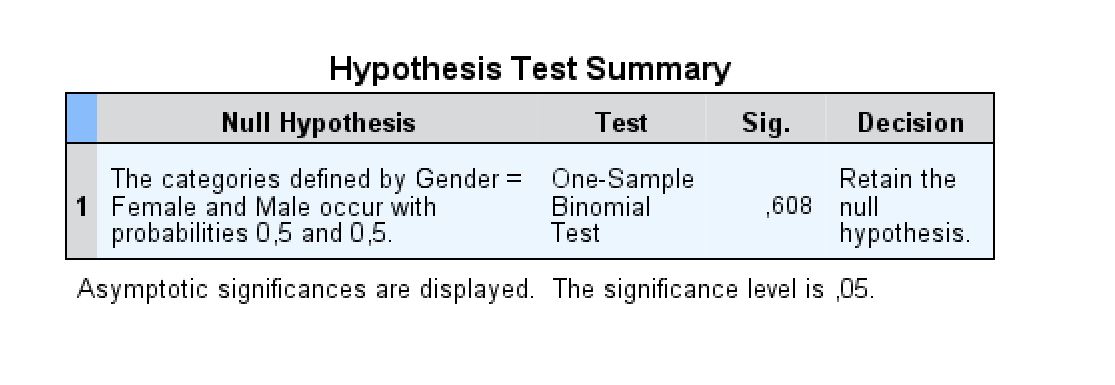
Want to create or adapt books like this? Learn more about how Pressbooks supports open publishing practices.
Quantitative Data Analysis With SPSS
10 Quantitative Analysis with SPSS: Getting Started
Mikaila Mariel Lemonik Arthur
This chapter focuses on getting started with SPSS. Note that before you can start to work with SPSS, you need to get your data into an appropriate format, as discussed in the chapter on Preparing Quantitative Data and Data Management . It is possible to enter data directly into SPSS, but the interface is not conducive to data entry and so researchers are better off entering their data using a spreadsheet program and then importing it.
Importing Data Into SPSS
In some cases, existing data will be able to be downloaded in SPSS format (*.sav is the file extension for an SPSS datafile), in which case it can be opened in SPSS by going to File → Open → Data and then locating the location of the file. However, in most cases, researchers will need to import data stored in another file format into SPSS. To import data, go to the file menu, then select import data. Next, choose the type of data you wish to import from the menu that appears. In most cases, researchers will be importing Excel or CSV data (when they have entered it themselves or are downloading it from a general-purpose site like the Census Bureau) or SAS or Stata data (when they are downloading it from a site that makes prepared statistical data files available).
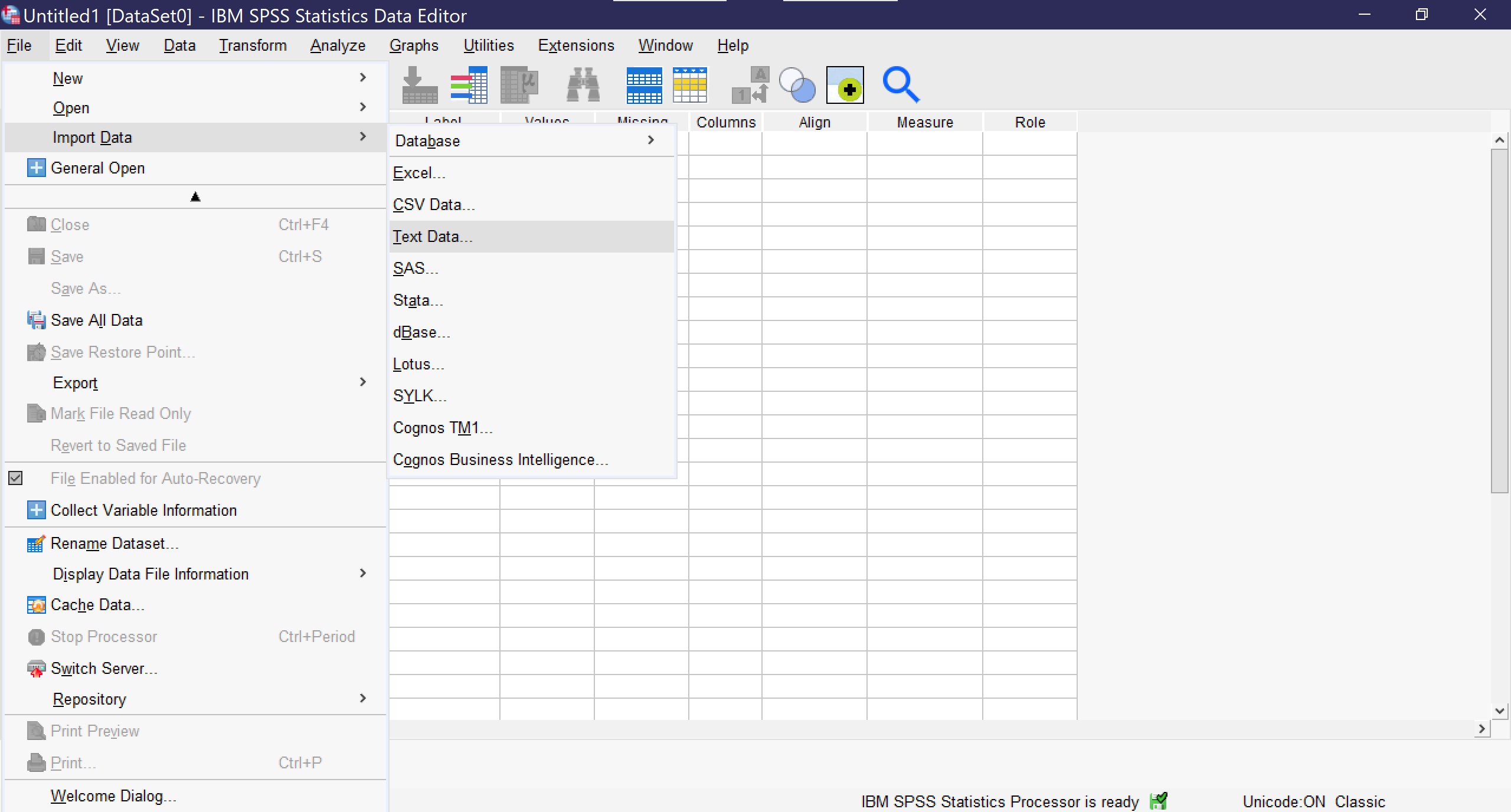
Once you click on a data type, a window will pop up for you to select the file you wish to import. Be sure it is of the file type you have chosen. If you import a file in a format that is already designed to work with statistical software, such as Stata, the importation process will be as seamless as opening a file. Researchers should be sure that immediately after importing, they save their file (File → Save As) so that it is stored in SPSS format and can be opened in SPSS, rather than imported, in the future. It is essential to remember that SPSS is not cloud-resident software and does not have an autosave function, so any time a file is changed, it must be manually saved.
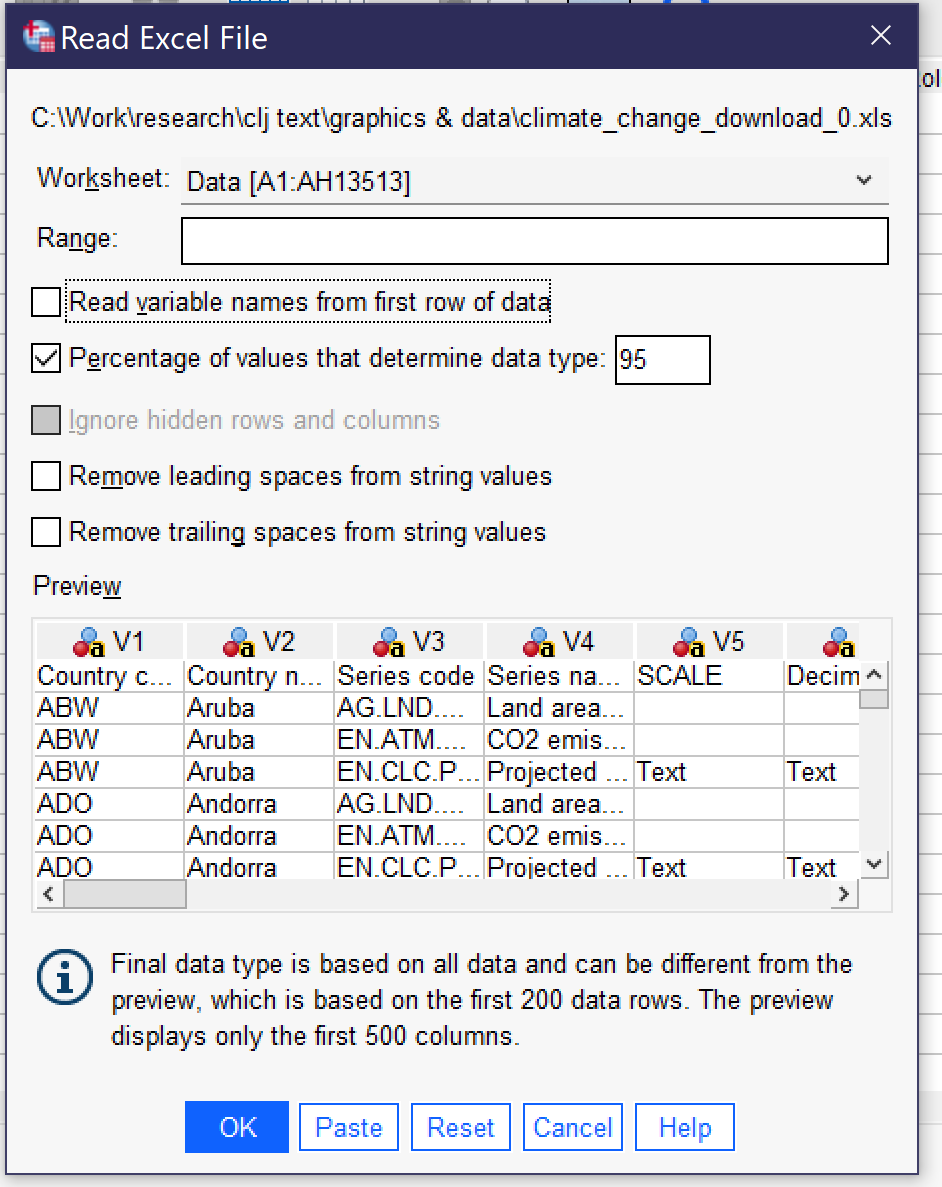
If you import a file in Excel, CSV (comma-separated values) or text format, SPSS will open an import wizard with a number of steps. The steps vary slightly depending on which file type you are importing. For instance, to import an Excel file, as shown in Figure 2, you first need to specify the worksheet (if the file has multiple worksheets—SPSS can only import one worksheet at a time). You can choose to specify a limited range of cells. Checking the checkbox next to “Read variable names from first row of data” will replace the V1, V2, V3, and so on column headers with whatever appears in the top row of data in the Excel file. You can also choose to change the percentage of values that are used to determine data type, remove leading and trailing spaces from string values, and—if your Excel file has hidden rows or columns—you can choose to ignore them. Below the options, a preview of your Excel file will be shown; you can scroll through the preview to see that data is being displayed correctly. Clicking OK will finalize the import.
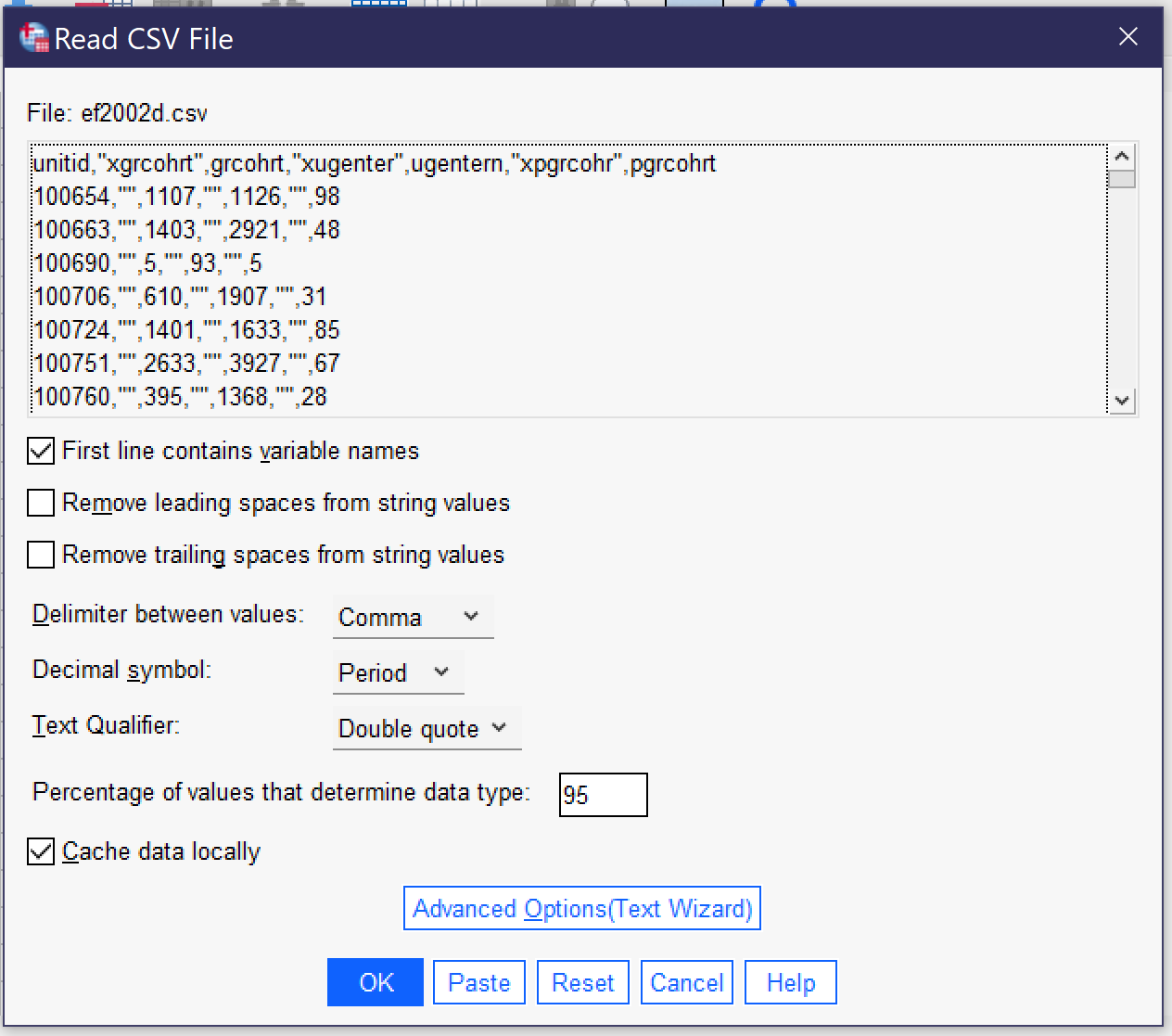
A different set of options appears when you import a CSV file, as shown in Figure 3. The top of the popup window shows a preview of the data in CSV format. While toggles related to whether the first line contains variable names, removing leading and trailing spaces, and indicating the percentage of values that determine the data type are the same as for importing data from Excel, there are additional options that are important for the proper importing of CSV data. First of all, the user must specify whether values are delimited by a comma, a semicolon, or a tab. While commas are the most common delimiters in CSV files, the other delimiters are possible, and looking at the preview should make clear which of the delimiters is being used in a given file, as shown in the example below.
Second, the user must specify whether the period or the comma is the decimal symbol. Data produced in the United States typically uses the period (as in 1238.67), as does data produced in many other English-speaking countries, while most of Europe and Latin America use the comma. Third, the user must specify the text qualifier (single quotes, double quotes, or none). This is the character used to note that the contents of a particular entry in the CSV file are textual (string variables) in nature, not numerical. If your data includes text, it should be clear from the preview which qualifier is being used. Users can also toggle whether data is cached locally or not; caching locally speeds the importation process.
Finally, there is a button for Advanced Options (Text Wizard). The text wizard offers the same window and options that users see if they are importing a text file directly, and this wizard offers more direct control over the importation process over a series of six steps. First, users can specify a predefined format if they have a *.tpf file on their computers (this is rare) and see a preview of what the data in the file looks like. In step two, they can indicate if the file is delimited (as above) or fixed-width (where values are stored in columns of constant size specified within the file); which—if any—row contains the variable names; and the decimal symbol. Note that some forms of fixed-width files may not be supported. Third, they indicate which line of the file contains the first line of data, whether each line represents a case or a specific given number of variables represents a case, and how many cases to import. This last choice includes the option to import a random sample of cases. Fourth, users specify the delimiter and the text qualifier and determine how to handle leading and trailing spaces in string values. Fifth, users can double-check variable names and formats. Finally, before clicking the “Finish” button, users can choose to save their selections as a *.tpf file to be reused or to paste the syntax (to be discussed later in this chapter).
In all cases, once the importation options have been selected and OK or Finish has been clicked, the data is imported. An output window (see Figure 4) may open with various warnings and details about the importation process, and the Data View window (see Figure 5) will show the data, with variable names at the top of each column. At this point, be sure to save the dataset in a location and with a name you will be able to locate later.
Before users are done setting up their dataset, they must be sure that appropriate variable information is included. When datasets are imported from other statistical programs, they will typically come with variable information. But when they are imported from Excel or CSV files, the variable information must be manually entered, typically from a codebook or related document. Variable information is entered using Variable View. Users can switch between Data View and Variable View by clicking the tabs at the bottom of the screen or using the Ctrl+T key combination. As you can see in Figure 6, a screenshot of a completed dataset, Variable View shows each variable in a row, with a variety of information about that variable. When a dataset is imported, each of these pieces of information need to be entered by hand for each variable. To move between columns by key commands, use the tab key; to open variable information that requires a menu for entry, click the space bar twice.

- Name requires that each variable be given a short name, without any spaces. There are additional rules about names, but in short, names should be primarily alphanumeric in nature and cannot be words or use symbols that have meaning for the underlying computer processing. Names can be entered directly.
- Type specifies the variable type. To open up the menu allowing the selection of variable types, click on the cell, then click on the three dots [.…] that appear on the right side of the cell. Users can then choose from among numeric, dollar, date, numeric with leading zeros, string, and other variable types.
- Width specifies the number of characters of width for the variable itself in data storage, while decimals specifies how many decimal places the variable will have. These can both be entered or edited directly or in the dialog box for Type.
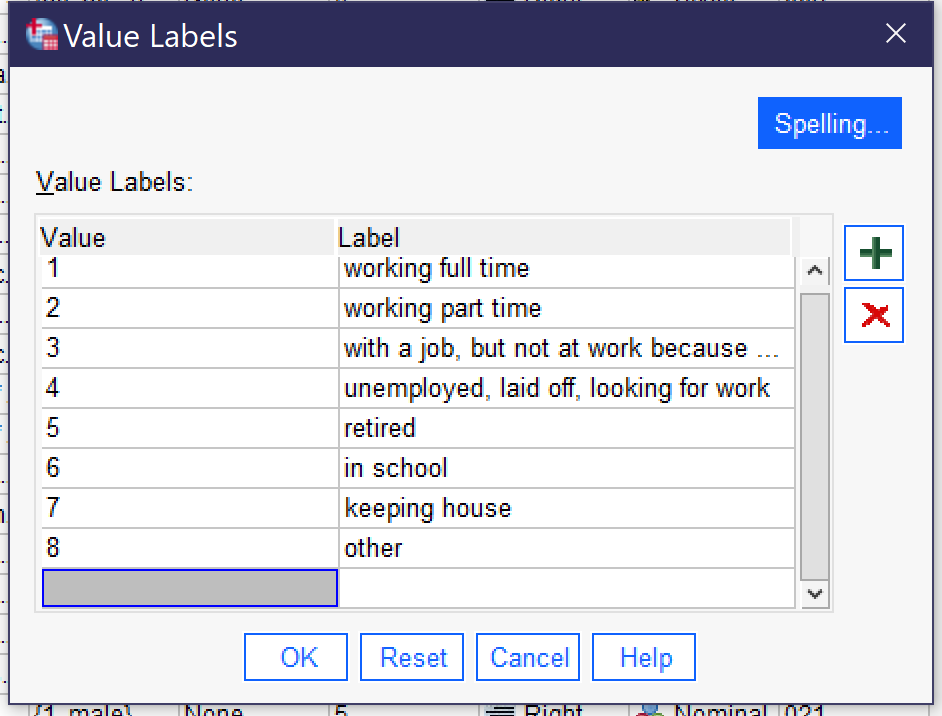
more completely what the variable is measuring. It can be entered directly.
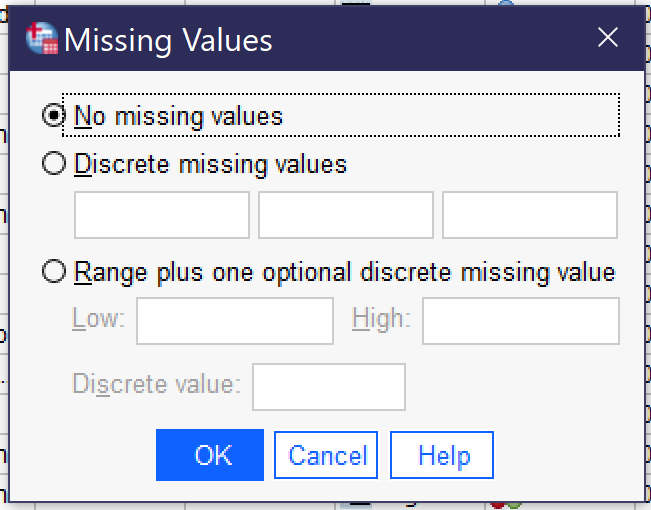
- Missing provides for the indication that particular values—like “refused to answer”—should be treated by the SPSS software as missing data rather than as analytically useful categories. Clicking the three dots [.…] opens a dialog box for specifying missing values. When there are no missing values, “no missing values” should be selected. Otherwise, users can select “discrete missing values” and then enter three specific missing values—the numerical values, not the value labels—or they can elect “range plus one optional discrete missing value” to specific a range from low to high of missing values, optionally adding an additional single discrete value.
- Columns specifies the width of the display column for the variable. It can be entered directly.
- Align specifies whether the variable data will be aligned right, center, or left. Users can click in the cell to make a menu appear or can press spacebar twice and then use arrows to select the desired alignment.
- Measure permits the indication of level of measurement from among nominal, ordinal, and scale variables. Users can click in the cell to make a menu appear or can press spacebar twice and then use arrows to select the desired level of measurement. Note that measure is often wrong in datasets and analysts should not rely on it in determining the level of measurement for selection of statistical tests; SPSS does not use this characteristic when running tests.
- Some datasets will have additional criteria. For example, the dataset shown in Figure 6 has a column called origsort which displays the original sort order of the dataset, so that if an analyst sorts the variables they can be returned to their original order.
When entering variable information, it is especially important to include Name, Label, and Values and be sure Type is correct and any Missing values are specified. Other variable information is less crucial, though clearly it is better to fully specify all variable information. Once all variable information is entered and double-checked and the dataset has been saved, it is ready for use.
When a user first opens SPSS, they are greeted with the “Welcome Dialog” (see figure 9). This dialog provides tips, links to help resources, and options for creating a new file (by selecting “new dataset”) or opening recently used files. There is a checkbox for turning off the Welcome Dialog so that it will not be shown in the future.
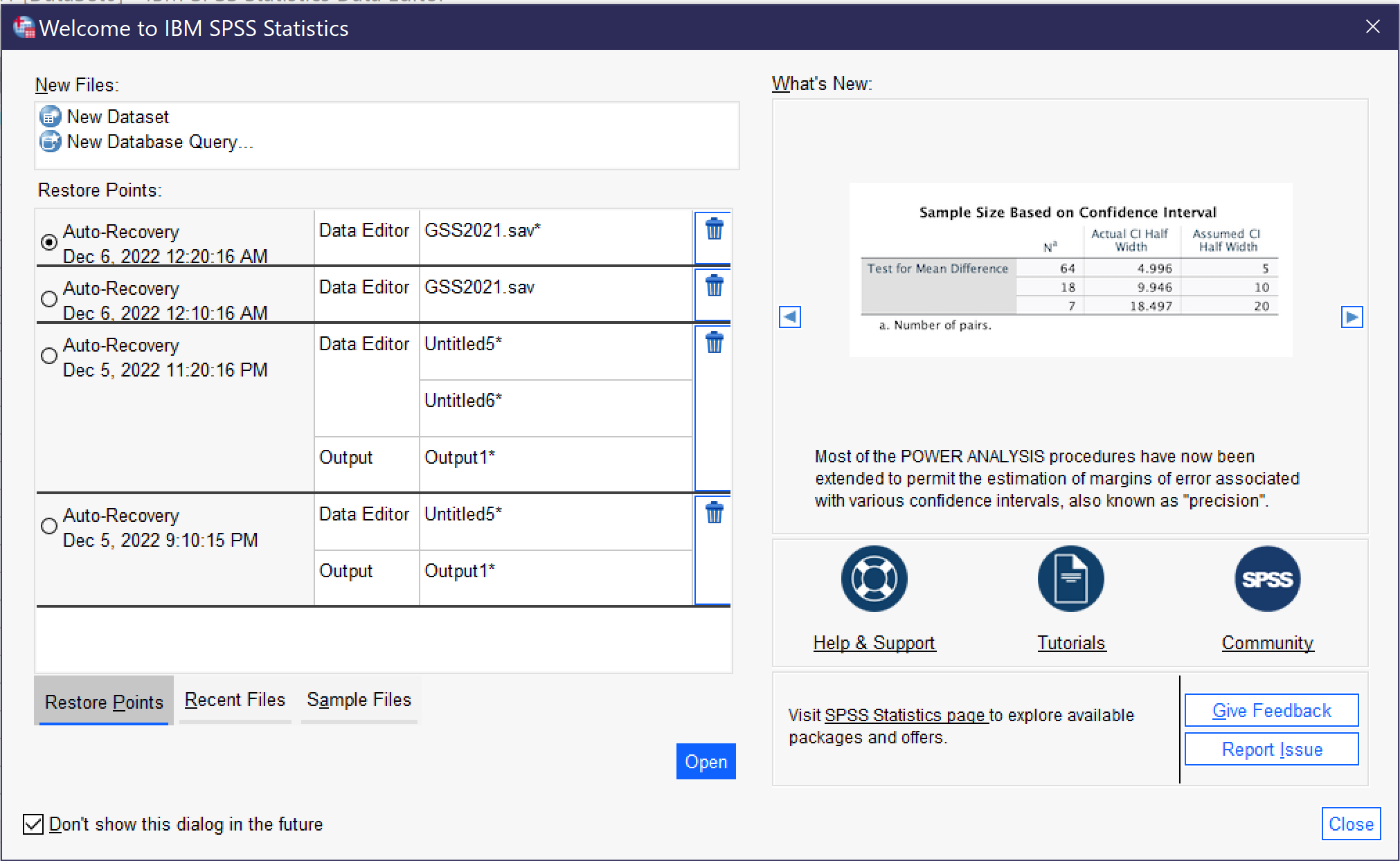
When the Welcome Dialog is turned off, SPSS opens with a blank file. Going to File → Open → Data (Alt+F, O, D) brings up the dialog for opening a data file; the Open menu also provides for opening other types of files, which will be discussed below. Earlier in this chapter, the differences between Data View and Variable view were discussed; when you open a data file, be sure to observe which view you are using.
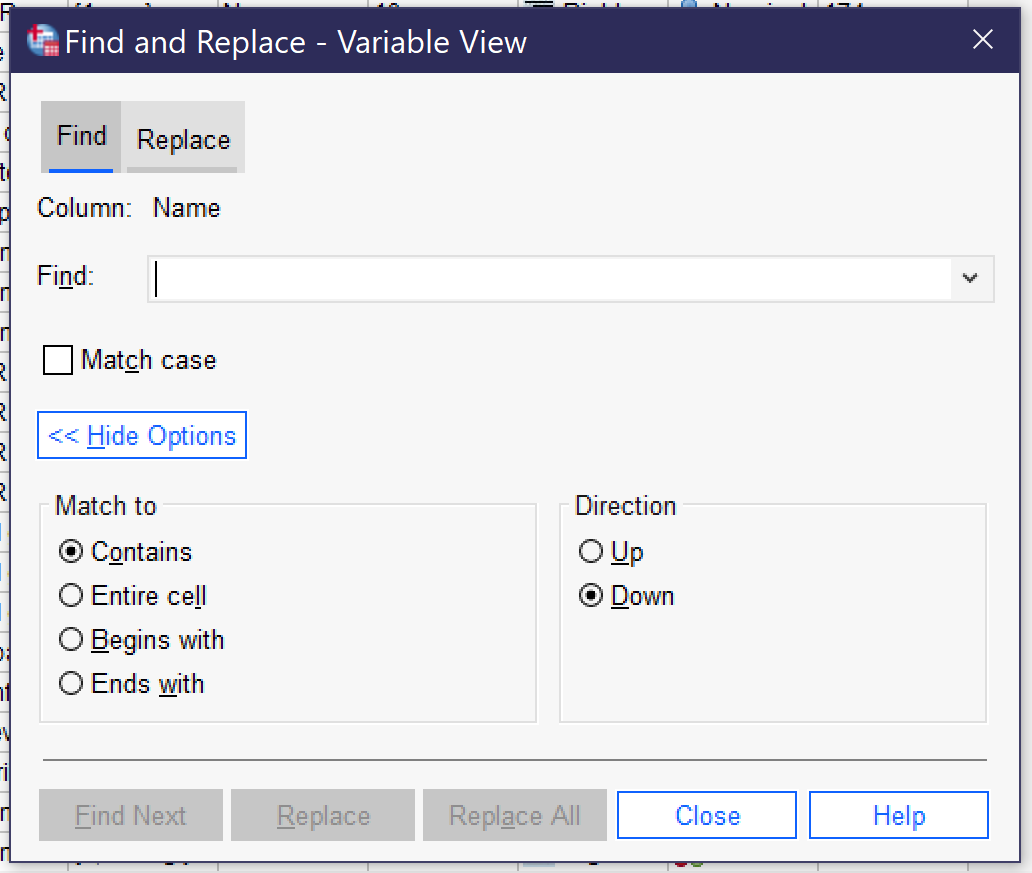
It can be useful to be able to search for a variable or case in the datafile. There are two main ways to do this, both under the Edit menu (Alt+E). [1] The Edit menu offers Find and Go To. Find, which can also be accessed by pressing Ctrl+F, allows users to search for all or part of a variable name. Figure 10 displays the Search dialog, with options shown after clicking on the “show options” button. (Users can also use the Replace function, but this carries the risk of writing over data and so should be avoided in almost all cases.) Be sure to select the column you wish to search—the Find function can only examine one column in Variable View at a time. Most typically, users will want to search variable names or labels. The checkbox for Match Case toggles whether or not case (in other words, capitalization) matters to the search. Expanding the options permits users to specify how much and which part of a cell must be matched as well as search order.
Users can also navigate to specific variables by using the Edit → Go to Case (to navigate to a specific case—or row in data view) and Edit → Go to Variable (to navigate to a specific variable—a row in variable view or a column in data view). Users can also access detailed variable information via the tool Utilities → Variables.
Another useful feature is the ability to sort variables and cases. Both types of sorting can be found in the data menu. Variables can be sorted by any of the characteristics in variable view; when sorting, the original sort order can be saved as a new characteristic. Cases can be sorted on any variable.
SPSS Options
The Options dialog can be reached by going to Edit → Options (or Alt+E, Alt+N). There are a wide variety of options available to help users customize their SPSS experience, a few of which are particularly important. First of all, using various dialogs and menus in the program is much easier if the options Variable List—Display Names (Alt+N) and Alphabetical (Alt+H) are selected under General. You can also change the display language for both the user interface and for output under Language, change fonts and colors for output under Viewer, set number options under Data; change currency options under Currency; set default output for graphs and charts under Charts; and set default file locations for saving files under File locations. While most of these options can be left on their default settings, it is really important for most users to set variables to display names and alphabetical before use. Options will be preserved if you use the same computer and user account, but if you are working on a public computer you should get in the habit of checking every time you start the program.
Getting More Out of SPSS
So far, we have been working only with Data View and Variable View in the main dataset window. But when researchers produce the results of an analysis, these results appear in a new window called Output—IBM SPSS Statistics Viewer. New Output windows can be opened from the File menu by going to Open → Output or from the Window menu by selecting “Go to Designated Viewer Window” (the later command also brings the output window to the foreground if one is already open). Output will be discussed in more detail when the results of different tests are discussed. For now, note that output can be saved in *.spv format, but this format can only be viewed in SPSS. To save output in a format viewable in other applications, go to File → Export, where you can choose a file location and a file format (like Word, PowerPoint, HTML, or PDF). Individual output items can also be copied and pasted.
SPSS also offers a Syntax viewer and editor, which can also be accessed from both the File and Window menus. While syntax is beyond the scope of this text, it provides the option for writing code (kind of like a computer program) to control SPSS rather than using menus and buttons in a graphical user interface. Experienced users, or those doing many similar repetitive tasks, often find working via syntax to be faster and more efficient, but the learning curve is quite steep. If you are interested in learning more about how to write syntax in SPSS, Help → Command Syntax Reference brings up a very long document detailing the commands available.
Finally, the Help menu in SPSS offers a variety of options for getting help in using the program, including links to web resource guides, PDF documentation, and help forums. These tools can also be reached directly via the SPSS website. In addition, many dialog boxes contain a “Help” button that takes users to webpages with more detail on the tool in question.
Go to https://www.baseball-reference.com/ and select 10 baseball players of your choice. In an Excel or other spreadsheet, enter the name, position, batting arm, throwing arm, weight in pounds, and height in inches, as well as, from the Summary: Career section, HR (home runs) and WAR (wins above replacement). Each player should get one row of the Excel spreadsheet. Once you have entered the data, import it into SPSS. Then use Variable View to enter the relevant information about each variable—including value labels for position, batting arm, and throwing arm. Sort your cases by home runs. Finally, save your file.
Media Attributions
- import menu
- import excel © IBM SPSS is licensed under a All Rights Reserved license
- import csv © IBM SPSS is licensed under a All Rights Reserved license
- output window © IBM SPSS is licensed under a All Rights Reserved license
- spss data view © IBM SPSS is licensed under a All Rights Reserved license
- variable-view © IBM SPSS is licensed under a All Rights Reserved license
- value labels © IBM SPSS is licensed under a All Rights Reserved license
- missing values © IBM SPSS is licensed under a All Rights Reserved license
- welcome dialog © IBSM SPSS is licensed under a All Rights Reserved license
- find and replace © IBM SPSS is licensed under a All Rights Reserved license
- Note that "Search," another option under the Edit menu, does not search variables or cases but instead launches a search of SPSS web resources and help files. ↵
A data type that represents non-numerical data; string values can include any sequence of letters, numbers, and spaces.
The possible levels or response choices of a given variable.
Social Data Analysis Copyright © 2021 by Mikaila Mariel Lemonik Arthur is licensed under a Creative Commons Attribution-NonCommercial-ShareAlike 4.0 International License , except where otherwise noted.

SPSS Correlation Analysis Tutorial
Also see Pearson Correlations - Quick Introduction .
Correlation Test - What Is It?
Null hypothesis.
- Assumptions
- Correlation Test in SPSS
A (Pearson) correlation is a number between -1 and +1 that indicates to what extent 2 quantitative variables are linearly related. It's best understood by looking at some scatterplots .
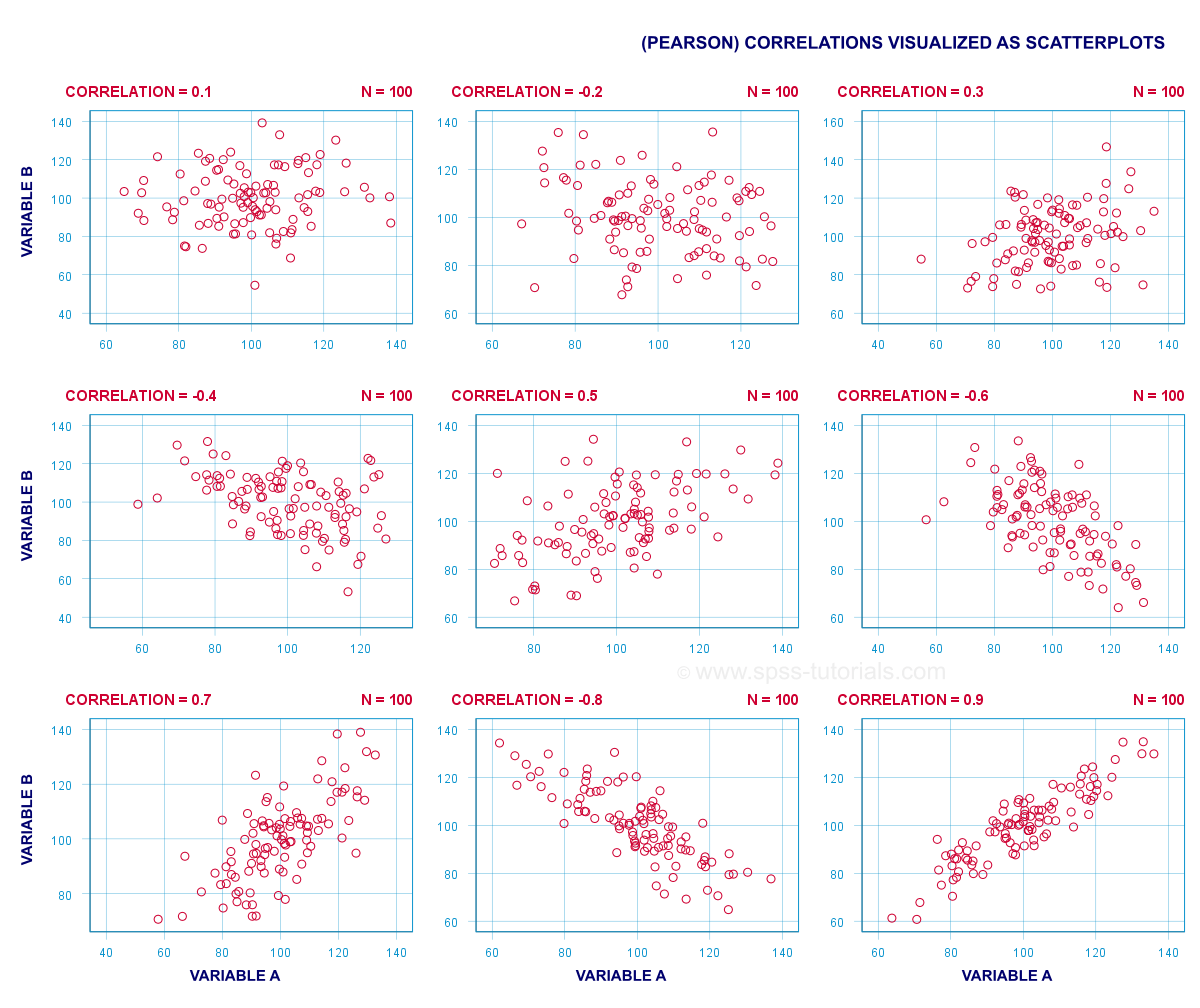
- a correlation of -1 indicates a perfect linear descending relation: higher scores on one variable imply lower scores on the other variable.
- a correlation of 0 means there's no linear relation between 2 variables whatsoever. However, there may be a (strong) non-linear relation nevertheless.
- a correlation of 1 indicates a perfect ascending linear relation: higher scores on one variable are associated with higher scores on the other variable.
A correlation test (usually) tests the null hypothesis that the population correlation is zero. Data often contain just a sample from a (much) larger population: I surveyed 100 customers (sample) but I'm really interested in all my 100,000 customers (population). Sample outcomes typically differ somewhat from population outcomes. So finding a non zero correlation in my sample does not prove that 2 variables are correlated in my entire population; if the population correlation is really zero, I may easily find a small correlation in my sample. However, finding a strong correlation in this case is very unlikely and suggests that my population correlation wasn't zero after all.
Correlation Test - Assumptions
Computing and interpreting correlation coefficients themselves does not require any assumptions. However, the statistical significance -test for correlations assumes
- independent observations;
- normality: our 2 variables must follow a bivariate normal distribution in our population. This assumption is not needed for sample sizes of N = 25 or more. For reasonable sample sizes, the central limit theorem ensures that the sampling distribution will be normal.
SPSS - Quick Data Check
Let's run some correlation tests in SPSS now. We'll use adolescents.sav , a data file which holds psychological test data on 128 children between 12 and 14 years old. Part of its variable view is shown below.
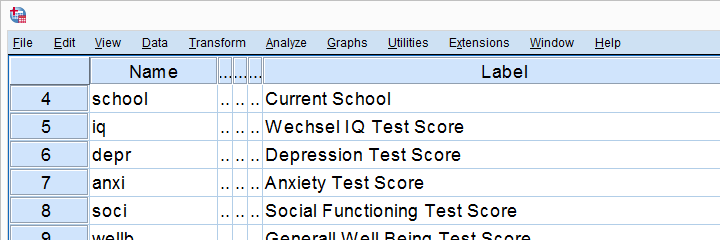
Now, before running any correlations, let's first make sure our data are plausible in the first place. Since all 5 variables are metric, we'll quickly inspect their histograms by running the syntax below.
Histogram Output
Our histograms tell us a lot: our variables have between 5 and 10 missing values . Their means are close to 100 with standard deviations around 15 -which is good because that's how these tests have been calibrated. One thing bothers me , though, and it's shown below.
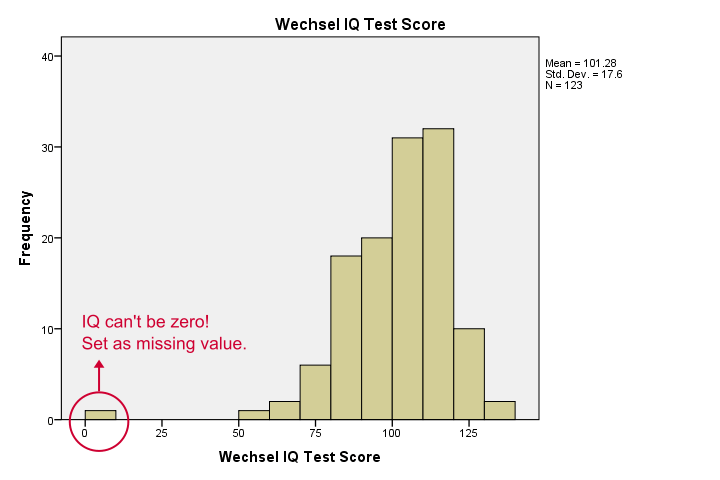
It seems like somebody scored zero on some tests -which is not plausible at all. If we ignore this, our correlations will be severely biased . Let's sort our cases, see what's going on and set some missing values before proceeding.
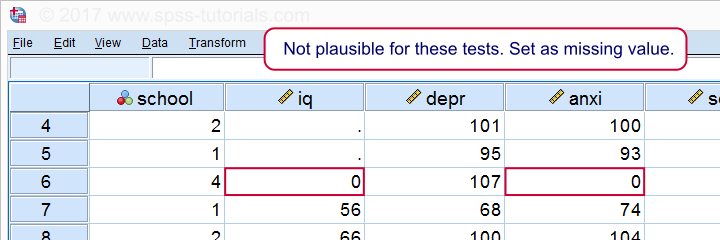
If we now rerun our histograms, we'll see that all distributions look plausible. Only now should we proceed to running the actual correlations.
Running a Correlation Test in SPSS

Move all relevant variables into the variables box. You probably don't want to change anything else here.
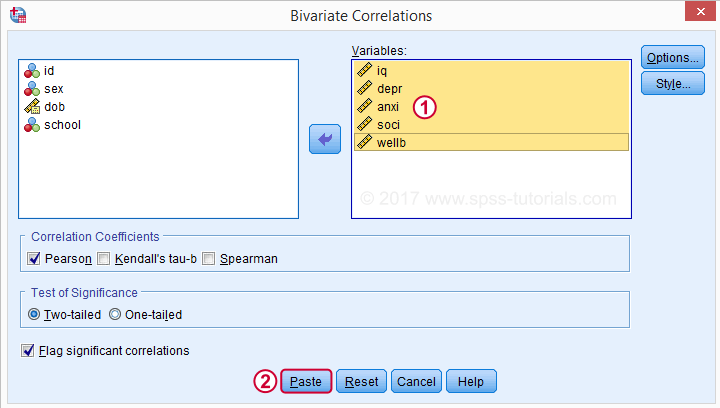
Clicking P aste results in the syntax below. Let's run it.
SPSS CORRELATIONS Syntax
Correlation output.
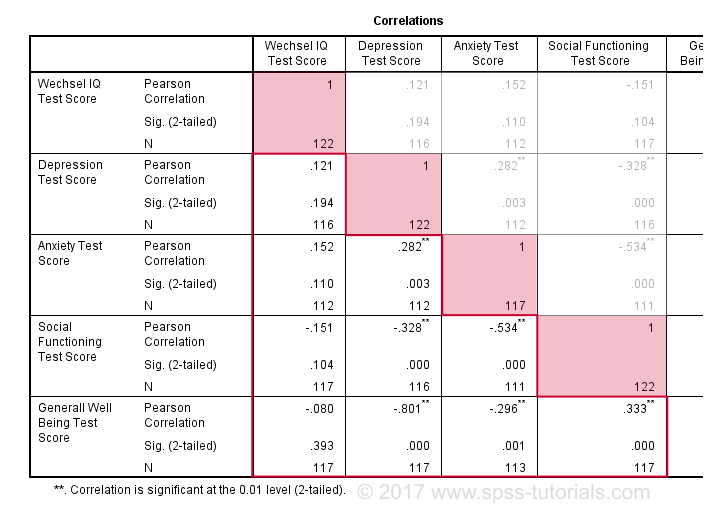
By default, SPSS always creates a full correlation matrix. Each correlation appears twice: above and below the main diagonal. The correlations on the main diagonal are the correlations between each variable and itself -which is why they are all 1 and not interesting at all. The 10 correlations below the diagonal are what we need. As a rule of thumb, a correlation is statistically significant if its “Sig. (2-tailed)” < 0.05. Now let's take a close look at our results: the strongest correlation is between depression and overall well-being : r = -0.801. It's based on N = 117 children and its 2-tailed significance , p = 0.000. This means there's a 0.000 probability of finding this sample correlation -or a larger one- if the actual population correlation is zero. Note that IQ does not correlate with anything . Its strongest correlation is 0.152 with anxiety but p = 0.11 so it's not statistically significantly different from zero. That is, there's an 0.11 chance of finding it if the population correlation is zero. This correlation is too small to reject the null hypothesis. Like so, our 10 correlations indicate to which extent each pair of variables are linearly related. Finally, note that each correlation is computed on a slightly different N -ranging from 111 to 117. This is because SPSS uses pairwise deletion of missing values by default for correlations.
Scatterplots
Strictly, we should inspect all scatterplots among our variables as well. After all, variables that don't correlate could still be related in some non-linear fashion. But for more than 5 or 6 variables, the number of possible scatterplots explodes so we often skip inspecting them. However, see SPSS - Create All Scatterplots Tool . The syntax below creates just one scatterplot, just to get an idea of what our relation looks like. The result doesn't show anything unexpected, though.
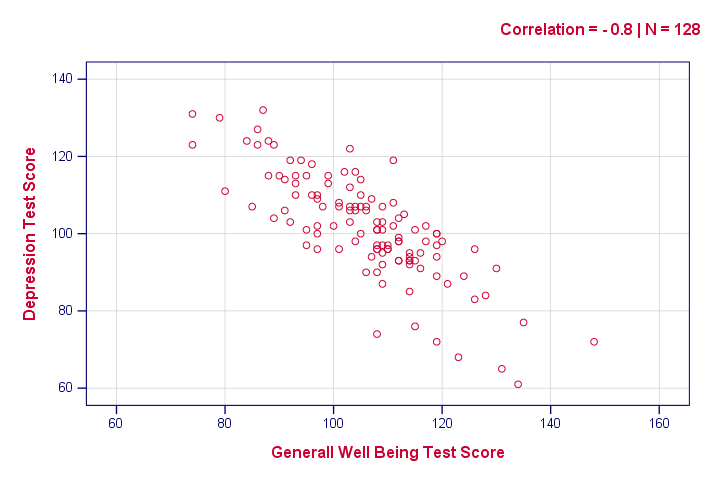
Reporting a Correlation Test
The figure below shows the most basic format recommended by the APA for reporting correlations. Importantly, make sure the table indicates which correlations are statistically significant at p < 0.05 and perhaps p < 0.01. Also see SPSS Correlations in APA Format .
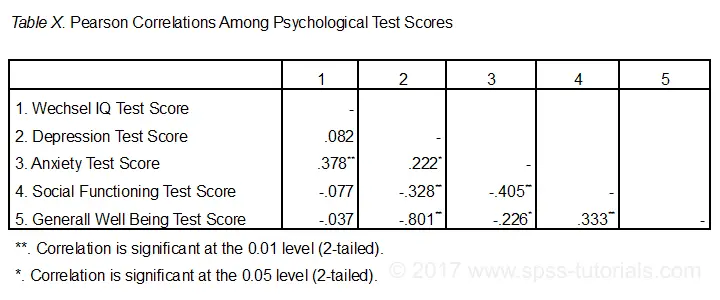
If possible, report the confidence intervals for your correlations as well. Oddly, SPSS doesn't include those. However, see SPSS Confidence Intervals for Correlations Tool .
Thanks for reading!
Tell us what you think!
This tutorial has 56 comments:.
By thavorn on December 20th, 2022
I love to learn again to refresh my statistic knowledge, thank you.
Privacy Overview

STAT7S: Exercise Using SPSS to Explore Hypothesis Testing – Paired-Samples t Test
Author: Ed Nelson Department of Sociology M/S SS97 California State University, Fresno Fresno, CA 93740 Email: [email protected]
Note to the Instructor: The data set used in this exercise is gss14_subset_for_classes_STATISTICS.sav which is a subset of the 2014 General Social Survey. Some of the variables in the GSS have been recoded to make them easier to use and some new variables have been created. The data have been weighted according to the instructions from the National Opinion Research Center. This exercise uses COMPARE MEANS (paired-samples t test) to explore hypothesis testing. A good reference on using SPSS is SPSS for Windows Version 23.0 A Basic Tutorial by Linda Fiddler, John Korey, Edward Nelson (Editor), and Elizabeth Nelson. The online version of the book is on the Social Science Research and Instructional Council's Website . You have permission to use this exercise and to revise it to fit your needs. Please send a copy of any revision to the author. Included with this exercise (as separate files) are more detailed notes to the instructors, the SPSS syntax necessary to carry out the exercise (SPSS syntax file), and the SPSS output for the exercise (SPSS output file). Please contact the author for additional information.
I’m attaching the following files.
- Data subset (.sav format)
- Extended notes for instructors (MS Word; docx format).
- Syntax file (.sps format)
- Output file (.spv format)
- This page (MS Word; docx format).
Goals of Exercise
The goal of this exercise is to explore hypothesis testing and the paired-samples t test. The exercise also gives you practice in using COMPARE MEANS.
Part I – Populations and Samples
Populations are the complete set of objects that we want to study. For example, a population might be all the individuals that live in the United States at a particular point in time. The U.S. does a complete enumeration of all individuals living in the United States every ten years (i.e., each year ending in a zero). We call this a census. Another example of a population is all the students in a particular school or all college students in your state. Populations are often large and it’s too costly and time consuming to carry out a complete enumeration. So what we do is to select a sample from the population where a sample is a subset of the population and then use the sample data to make an inference about the population.
A statistic describes a characteristic of a sample while a parameter describes a characteristic of a population. The mean age of a sample is a statistic while the mean age of the population is a parameter. We use statistics to make inferences about parameters. In other words, we use the mean age of the sample to make an inference about the mean age of the population. Notice that the mean age of the sample (our statistic) is known while the mean age of the population (our parameter) is usually unknown.
There are many different ways to select samples. Probability samples are samples in which every object in the population has a known, non-zero, chance of being in the sample (i.e., the probability of selection). This isn’t the case for non-probability samples. An example of a non-probability sample is an instant poll which you hear about on radio and television shows. A show might invite you to go to a website and answer a question such as whether you favor or oppose same-sex marriage. This is a purely volunteer sample and we have no idea of the probability of selection.
We’re going to use the General Social Survey (GSS) for this exercise. The GSS is a national probability sample of adults in the United States conducted by the National Opinion Research Center (NORC). The GSS started in 1972 and has been an annual or biannual survey ever since. For this exercise we’re going to use a subset of the 2014 GSS. Your instructor will tell you how to access this data set which is called gss14_subset_for_classes_STATISTICS.sav.
In STAT6S we compared means from two independent samples. Independent samples are samples in which the composition of one sample does not influence the composition of the other sample. In this exercise we’re using the 2014 GSS which is a sample of adults in the United States. If we divide this sample into men and women we would have a sample of men and a sample of women and they would be independent samples. The individuals in one of the samples would not influence who is in the other sample.
In this exercise we’re going to compare means from two dependent samples. Dependent samples are samples in which the composition of one sample influences the composition of the other sample. The 2014 GSS includes questions about the years of school completed by the respondent’s parents – d22_maeduc and d24_paeduc. Let’s assume that we think that respondent’s fathers have more education than respondent’s mothers. We would compare the mean years of school completed by mothers with the mean years of school completed by fathers. If the respondent’s mother is in one sample, then the respondent’s father must be in the other sample. The composition of the samples is therefore dependent on each other. SPSS calls these paired-samples so we’ll use that term from now on.
Let’s start by asking whether fathers or mothers have more years of school? Click on “Analyze” in the menu bar and then on “Compare Means” and finally on “Means.” (See Chapter 6, introduction in the online SPSS book mentioned on page 1.) Select the variables d22_maeduc and d24_paeduc and move them to the “Dependent List” box. These are the variables for which you are going to compute means. The output from SPSS will show you the mean, number of cases, and standard deviation for fathers and mothers.
Fathers have about two-tenths of a year more education than mothers. Why can’t we just conclude that fathers have more education than mothers? If we were just describing the sample , we could. But what we want to do is to make inferences about differences between fathers and mothers in the population . We have a sample of fathers and a sample of mothers and some amount of sampling error will always be present in both samples. The larger the sample, the less the sampling error and the smaller the sample, the more the sampling error. Because of this sampling error we need to make use of hypothesis testing as we did in the two previous exercises (STAT5S and STAT6S).
Part II – Now it’s Your Turn
In this part of the exercise you want to compare the years of school completed by respondents and their spouses to determine whether men have more education than their spouses or whether women have more education than their spouses.
Use SPSS to get the sample means as we did in Part I and then compare them to begin answering this question. But we need to be careful here. Respondents could be either male or female. We need to separate respondents into two groups – men and women – and then separately compare male respondents with their spouses and female respondents with their spouses. We can do this by putting the variables d4_educ and d29_speduc into the “Dependent List” box and d5_sex into the “Independent List” box.
Part III – Hypothesis Testing – Paired-Samples t Test
In Part I we compared the mean years of school completed by fathers and mothers. Now we want to determine if this difference is statistically significant by carrying out the paired-samples t test.
Click on “Analyze” and then on “Compare Means” and finally on “Paired-Samples T Test.” (See Chapter 6, paired-samples t test in the online SPSS book.) Move the two variables listed above into the “Paired Variables” box. Do this by selecting d22_maeduc and click on the arrow to move it into the “Variable 1” box. Then select the other variable, d24_paeduc, and click on the arrow to move it into the “Variable 2” box. Now click on “OK” and SPSS will carry out the paired-samples t test. It doesn’t matter which variable you put in the “Variable 1” and “Variable 2” boxes.
You should see three boxes in the output screen. The first box gives you four pieces of information.
- Means for mothers and fathers.
- N which is the number of mothers and fathers on which the t test is based. This includes only those cases with valid information. In other words, cases with missing information (e.g., don’t know, no answer) are excluded.
- Standard deviations for mothers and fathers.
- Standard error of the mean for mothers and fathers which is an estimate of the amount of sampling error for the two samples.
The second box gives you the paired sample correlation which is the correlation between mother’s and father’s years of school completed for the paired samples. If you haven’t discussed correlation yet don’t worry about what this means.
The third box has more information in it. With paired samples what we do is subtract the years of school completed for one parent in each pair from the years of school completed for the other parent in the same pair. Since we put mother’s years of school completed in variable 1 and father’s education in variable 2 SPSS will subtract father’s education from mother’s education. So if the father completed 12 years and the mother completed 10 years we would subtract 12 from 10 which would give you -2. For this pair the father completed two more years than the mother.
The third box gives you the following information.
- The mean difference score for all the pairs in the sample which is -0.176. This means that fathers had an average of almost two-tenths of a year more education than the mothers. By the way, in Part I when we compared the means for d22_maeduc and d24_paeduc the difference was 0.22. Here the mean difference score is .176. Why aren’t they the same? See if you can figure this out. (Hint: it has something to do with comparing differences for pairs.)
- The standard deviation of the difference scores for all these pairs which is 3.206.
- The standard error of the mean which is an estimate of the amount of sampling error.
- The 95% confidence interval for the mean difference score. If you haven’t talked about confidence intervals yet, just ignore this. We’ll talk about confidence intervals in a later exercise.
- The value of t for the paired-sample t test which is -2.324. There is a formula for computing t which your instructor may or may not want to cover in your course.
- The degrees of freedom for the t test which is 1,795 which is the number of pairs minus one or 1,796 – 1 or 1,795. In other words, 1,795 of the difference scores are free to vary. Once these difference scores are fixed, then the final difference score is fixed or determined.
- The two-tailed significance value which is .020 which we’ll cover next.
Notice how we are going about this. We have a sample of adults in the United States (i.e., the 2014 GSS). We calculate the mean years of school completed by respondent’s fathers and mothers in the sample who answered the question. But we want to test the hypothesis that the mean years of school completed by fathers is greater than the mean for mothers in the population . We’re going to use our sample data to test a hypothesis about the population.
The hypothesis we want to test is that the mean years of school completed by fathers is greater than the mean years of school completed by mothers in the population. We’ll call this our research hypothesis. It’s what we expect to be true. But there is no way to prove the research hypothesis directly. So we’re going to use a method of indirect proof. We’re going to set up another hypothesis that says that the research hypothesis is not true and call this the null hypothesis. If we can’t reject the null hypothesis then we don’t have any evidence in support of the research hypothesis. You can see why this is called a method of indirect proof. We can’t prove the research hypothesis directly but if we can reject the null hypothesis then we have indirect evidence that supports the research hypothesis. We haven’t proven the research hypothesis, but we have support for this hypothesis.
Here are our two hypotheses.
· research hypothesis – the mean difference score in the population is negative. In other words, the mean years of school completed by fathers is greater than the mean years for mothers for all pairs in the population.
· null hypothesis – the mean difference score for all pairs in the population is equal to 0.
It’s the null hypothesis that we are going to test.
Now all we have to do is figure out how to use the t test to decide whether to reject or not reject the null hypothesis. Look again at the significance value which is 0.020. That tells you that the probability of being wrong if you rejected the null hypothesis is. 02 or 2 times out of one hundred. With odds like that, of course, we’re going to reject the null hypothesis. A common rule is to reject the null hypothesis if the significance value is less than .05 or less than five out of one hundred.
But wait a minute. The SPSS output said this was a two-tailed significance value. What does that mean? Look back at the research hypothesis which was that the mean difference score for all pairs in the population was less than 0. We’re predicting that the mean difference score for all pairs in the population will be negative. That’s called a one-tailed test and we have to use a one-tailed significance value. It’s easy to get the one-tailed significance value if we know the two-tailed significance value. If the two-tailed significance value is .020 then the one-tailed significance value is half that or .020 divided by two or .010. We still reject the null hypothesis which means that we have evidence to support our research hypothesis. We haven’t proven the research hypothesis to be true but we have evidence to support it.
Part IV – Now it’s Your Turn Again
In this part of the exercise you want to compare the years of school completed by respondents and their spouses to determine if women have more education than their spouses but this time you want to test the appropriate null hypotheses.
Remember from Part II that we have to test this hypothesis first for men and then for women. We’re going to do this by selecting out all the men and then computing the paired-samples t test. Do this by clicking on “Data” in the menu bar and then clicking on “Select Cases.” Select “If condition is satisfied” and then click on “If” in the box below. Select d5_sex and move it to the box on the right by clicking on the arrow pointing to the right. Now click on the equals sign and then on 1 so the expression in the box reads “d5_sex = 1”. Click on “Continue” and then on “OK”. To make sure you have selected out the males run a frequency distribution for d5_sex. You should only see the males (i.e., value 1). Now carry out the paired-samples t test. Repeat this for the females (i.e., value 2) by selecting out the females and then running the paired-samples t test again.
For each paired-sample t test, state the research and the null hypotheses. Do you reject or not reject the null hypotheses? Explain why.
Document Viewers
- Free PDF Viewer
- Free Word Viewer
- Free Excel Viewer
- Free PowerPoint Viewer

- Flashes Safe Seven
- FlashLine Login
- Faculty & Staff Phone Directory
- Emeriti or Retiree
- All Departments
- Maps & Directions

- Building Guide
- Departments
- Directions & Parking
- Faculty & Staff
- Give to University Libraries
- Library Instructional Spaces
- Mission & Vision
- Newsletters
- Circulation
- Course Reserves / Core Textbooks
- Equipment for Checkout
- Interlibrary Loan
- Library Instruction
- Library Tutorials
- My Library Account
- Open Access Kent State
- Research Support Services
- Statistical Consulting
- Student Multimedia Studio
- Citation Tools
- Databases A-to-Z
- Databases By Subject
- Digital Collections
- Discovery@Kent State
- Government Information
- Journal Finder
- Library Guides
- Connect from Off-Campus
- Library Workshops
- Subject Librarians Directory
- Suggestions/Feedback
- Writing Commons
- Academic Integrity
- Jobs for Students
- International Students
- Meet with a Librarian
- Study Spaces
- University Libraries Student Scholarship
- Affordable Course Materials
- Copyright Services
- Selection Manager
- Suggest a Purchase
Library Locations at the Kent Campus
- Architecture Library
- Fashion Library
- Map Library
- Performing Arts Library
- Special Collections and Archives
Regional Campus Libraries
- East Liverpool
- College of Podiatric Medicine
- Kent State University
- SPSS Tutorials
Pearson Correlation
Spss tutorials: pearson correlation.
- The SPSS Environment
- The Data View Window
- Using SPSS Syntax
- Data Creation in SPSS
- Importing Data into SPSS
- Variable Types
- Date-Time Variables in SPSS
- Defining Variables
- Creating a Codebook
- Computing Variables
- Recoding Variables
- Recoding String Variables (Automatic Recode)
- Weighting Cases
- rank transform converts a set of data values by ordering them from smallest to largest, and then assigning a rank to each value. In SPSS, the Rank Cases procedure can be used to compute the rank transform of a variable." href="https://libguides.library.kent.edu/SPSS/RankCases" style="" >Rank Cases
- Sorting Data
- Grouping Data
- Descriptive Stats for One Numeric Variable (Explore)
- Descriptive Stats for One Numeric Variable (Frequencies)
- Descriptive Stats for Many Numeric Variables (Descriptives)
- Descriptive Stats by Group (Compare Means)
- Frequency Tables
- Working with "Check All That Apply" Survey Data (Multiple Response Sets)
- Chi-Square Test of Independence
- One Sample t Test
- Paired Samples t Test
- Independent Samples t Test
- How to Cite the Tutorials
Sample Data Files
Our tutorials reference a dataset called "sample" in many examples. If you'd like to download the sample dataset to work through the examples, choose one of the files below:
- Data definitions (*.pdf)
- Data - Comma delimited (*.csv)
- Data - Tab delimited (*.txt)
- Data - Excel format (*.xlsx)
- Data - SAS format (*.sas7bdat)
- Data - SPSS format (*.sav)
- SPSS Syntax (*.sps) Syntax to add variable labels, value labels, set variable types, and compute several recoded variables used in later tutorials.
- SAS Syntax (*.sas) Syntax to read the CSV-format sample data and set variable labels and formats/value labels.
The bivariate Pearson Correlation produces a sample correlation coefficient, r , which measures the strength and direction of linear relationships between pairs of continuous variables. By extension, the Pearson Correlation evaluates whether there is statistical evidence for a linear relationship among the same pairs of variables in the population, represented by a population correlation coefficient, ρ (“rho”). The Pearson Correlation is a parametric measure.
This measure is also known as:
- Pearson’s correlation
- Pearson product-moment correlation (PPMC)
Common Uses
The bivariate Pearson Correlation is commonly used to measure the following:
- Correlations among pairs of variables
- Correlations within and between sets of variables
The bivariate Pearson correlation indicates the following:
- Whether a statistically significant linear relationship exists between two continuous variables
- The strength of a linear relationship (i.e., how close the relationship is to being a perfectly straight line)
- The direction of a linear relationship (increasing or decreasing)
Note: The bivariate Pearson Correlation cannot address non-linear relationships or relationships among categorical variables. If you wish to understand relationships that involve categorical variables and/or non-linear relationships, you will need to choose another measure of association.
Note: The bivariate Pearson Correlation only reveals associations among continuous variables. The bivariate Pearson Correlation does not provide any inferences about causation, no matter how large the correlation coefficient is.
Data Requirements
To use Pearson correlation, your data must meet the following requirements:
- Two or more continuous variables (i.e., interval or ratio level)
- Cases must have non-missing values on both variables
- Linear relationship between the variables
- the values for all variables across cases are unrelated
- for any case, the value for any variable cannot influence the value of any variable for other cases
- no case can influence another case on any variable
- The biviariate Pearson correlation coefficient and corresponding significance test are not robust when independence is violated.
- Each pair of variables is bivariately normally distributed
- Each pair of variables is bivariately normally distributed at all levels of the other variable(s)
- This assumption ensures that the variables are linearly related; violations of this assumption may indicate that non-linear relationships among variables exist. Linearity can be assessed visually using a scatterplot of the data.
- Random sample of data from the population
- No outliers
The null hypothesis ( H 0 ) and alternative hypothesis ( H 1 ) of the significance test for correlation can be expressed in the following ways, depending on whether a one-tailed or two-tailed test is requested:
Two-tailed significance test:
H 0 : ρ = 0 ("the population correlation coefficient is 0; there is no association") H 1 : ρ ≠ 0 ("the population correlation coefficient is not 0; a nonzero correlation could exist")
One-tailed significance test:
H 0 : ρ = 0 ("the population correlation coefficient is 0; there is no association") H 1 : ρ > 0 ("the population correlation coefficient is greater than 0; a positive correlation could exist") OR H 1 : ρ < 0 ("the population correlation coefficient is less than 0; a negative correlation could exist")
where ρ is the population correlation coefficient.
Test Statistic
The sample correlation coefficient between two variables x and y is denoted r or r xy , and can be computed as: $$ r_{xy} = \frac{\mathrm{cov}(x,y)}{\sqrt{\mathrm{var}(x)} \dot{} \sqrt{\mathrm{var}(y)}} $$
where cov( x , y ) is the sample covariance of x and y ; var( x ) is the sample variance of x ; and var( y ) is the sample variance of y .
Correlation can take on any value in the range [-1, 1]. The sign of the correlation coefficient indicates the direction of the relationship, while the magnitude of the correlation (how close it is to -1 or +1) indicates the strength of the relationship.
- -1 : perfectly negative linear relationship
- 0 : no relationship
- +1 : perfectly positive linear relationship
The strength can be assessed by these general guidelines [1] (which may vary by discipline):
- .1 < | r | < .3 … small / weak correlation
- .3 < | r | < .5 … medium / moderate correlation
- .5 < | r | ……… large / strong correlation
Note: The direction and strength of a correlation are two distinct properties. The scatterplots below [2] show correlations that are r = +0.90, r = 0.00, and r = -0.90, respectively. The strength of the nonzero correlations are the same: 0.90. But the direction of the correlations is different: a negative correlation corresponds to a decreasing relationship, while and a positive correlation corresponds to an increasing relationship.
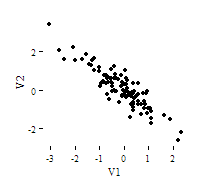
Note that the r = 0.00 correlation has no discernable increasing or decreasing linear pattern in this particular graph. However, keep in mind that Pearson correlation is only capable of detecting linear associations, so it is possible to have a pair of variables with a strong nonlinear relationship and a small Pearson correlation coefficient. It is good practice to create scatterplots of your variables to corroborate your correlation coefficients.
[1] Cohen, J. (1988). Statistical power analysis for the behavioral sciences (2nd ed.). Hillsdale, NJ: Lawrence Erlbaum Associates.
[2] Scatterplots created in R using ggplot2 , ggthemes::theme_tufte() , and MASS::mvrnorm() .
Data Set-Up
Your dataset should include two or more continuous numeric variables, each defined as scale, which will be used in the analysis.
Each row in the dataset should represent one unique subject, person, or unit. All of the measurements taken on that person or unit should appear in that row. If measurements for one subject appear on multiple rows -- for example, if you have measurements from different time points on separate rows -- you should reshape your data to "wide" format before you compute the correlations.
Run a Bivariate Pearson Correlation
To run a bivariate Pearson Correlation in SPSS, click Analyze > Correlate > Bivariate .
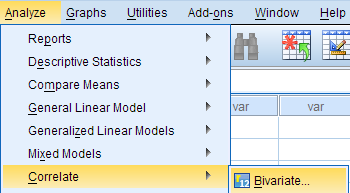
The Bivariate Correlations window opens, where you will specify the variables to be used in the analysis. All of the variables in your dataset appear in the list on the left side. To select variables for the analysis, select the variables in the list on the left and click the blue arrow button to move them to the right, in the Variables field.

A Variables : The variables to be used in the bivariate Pearson Correlation. You must select at least two continuous variables, but may select more than two. The test will produce correlation coefficients for each pair of variables in this list.
B Correlation Coefficients: There are multiple types of correlation coefficients. By default, Pearson is selected. Selecting Pearson will produce the test statistics for a bivariate Pearson Correlation.
C Test of Significance: Click Two-tailed or One-tailed , depending on your desired significance test. SPSS uses a two-tailed test by default.
D Flag significant correlations: Checking this option will include asterisks (**) next to statistically significant correlations in the output. By default, SPSS marks statistical significance at the alpha = 0.05 and alpha = 0.01 levels, but not at the alpha = 0.001 level (which is treated as alpha = 0.01)
E Options : Clicking Options will open a window where you can specify which Statistics to include (i.e., Means and standard deviations , Cross-product deviations and covariances ) and how to address Missing Values (i.e., Exclude cases pairwise or Exclude cases listwise ). Note that the pairwise/listwise setting does not affect your computations if you are only entering two variable, but can make a very large difference if you are entering three or more variables into the correlation procedure.

Example: Understanding the linear association between weight and height
Problem statement.
Perhaps you would like to test whether there is a statistically significant linear relationship between two continuous variables, weight and height (and by extension, infer whether the association is significant in the population). You can use a bivariate Pearson Correlation to test whether there is a statistically significant linear relationship between height and weight, and to determine the strength and direction of the association.
Before the Test
In the sample data, we will use two variables: “Height” and “Weight.” The variable “Height” is a continuous measure of height in inches and exhibits a range of values from 55.00 to 84.41 ( Analyze > Descriptive Statistics > Descriptives ). The variable “Weight” is a continuous measure of weight in pounds and exhibits a range of values from 101.71 to 350.07.
Before we look at the Pearson correlations, we should look at the scatterplots of our variables to get an idea of what to expect. In particular, we need to determine if it's reasonable to assume that our variables have linear relationships. Click Graphs > Legacy Dialogs > Scatter/Dot . In the Scatter/Dot window, click Simple Scatter , then click Define . Move variable Height to the X Axis box, and move variable Weight to the Y Axis box. When finished, click OK .

To add a linear fit like the one depicted, double-click on the plot in the Output Viewer to open the Chart Editor. Click Elements > Fit Line at Total . In the Properties window, make sure the Fit Method is set to Linear , then click Apply . (Notice that adding the linear regression trend line will also add the R-squared value in the margin of the plot. If we take the square root of this number, it should match the value of the Pearson correlation we obtain.)
From the scatterplot, we can see that as height increases, weight also tends to increase. There does appear to be some linear relationship.
Running the Test
To run the bivariate Pearson Correlation, click Analyze > Correlate > Bivariate . Select the variables Height and Weight and move them to the Variables box. In the Correlation Coefficients area, select Pearson . In the Test of Significance area, select your desired significance test, two-tailed or one-tailed. We will select a two-tailed significance test in this example. Check the box next to Flag significant correlations .
Click OK to run the bivariate Pearson Correlation. Output for the analysis will display in the Output Viewer.
The results will display the correlations in a table, labeled Correlations .
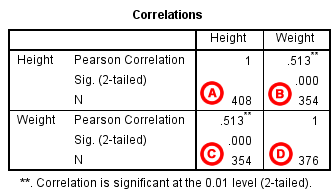
A Correlation of Height with itself (r=1), and the number of nonmissing observations for height (n=408).
B Correlation of height and weight (r=0.513), based on n=354 observations with pairwise nonmissing values.
C Correlation of height and weight (r=0.513), based on n=354 observations with pairwise nonmissing values.
D Correlation of weight with itself (r=1), and the number of nonmissing observations for weight (n=376).
The important cells we want to look at are either B or C. (Cells B and C are identical, because they include information about the same pair of variables.) Cells B and C contain the correlation coefficient for the correlation between height and weight, its p-value, and the number of complete pairwise observations that the calculation was based on.
The correlations in the main diagonal (cells A and D) are all equal to 1. This is because a variable is always perfectly correlated with itself. Notice, however, that the sample sizes are different in cell A ( n =408) versus cell D ( n =376). This is because of missing data -- there are more missing observations for variable Weight than there are for variable Height.
If you have opted to flag significant correlations, SPSS will mark a 0.05 significance level with one asterisk (*) and a 0.01 significance level with two asterisks (0.01). In cell B (repeated in cell C), we can see that the Pearson correlation coefficient for height and weight is .513, which is significant ( p < .001 for a two-tailed test), based on 354 complete observations (i.e., cases with nonmissing values for both height and weight).
Decision and Conclusions
Based on the results, we can state the following:
- Weight and height have a statistically significant linear relationship ( r =.513, p < .001).
- The direction of the relationship is positive (i.e., height and weight are positively correlated), meaning that these variables tend to increase together (i.e., greater height is associated with greater weight).
- The magnitude, or strength, of the association is approximately moderate (.3 < | r | < .5).
- << Previous: Chi-Square Test of Independence
- Next: One Sample t Test >>
- Last Updated: Dec 18, 2023 12:59 PM
- URL: https://libguides.library.kent.edu/SPSS
Street Address
Mailing address, quick links.
- How Are We Doing?
- Student Jobs
Information
- Accessibility
- Emergency Information
- For Our Alumni
- For the Media
- Jobs & Employment
- Life at KSU
- Privacy Statement
- Technology Support
- Website Feedback

To perform a one sample t-test click "Analyze"→"Compare Means"→"One Sample T-Test" and the following dialog box will appear: The dialogue allows selection of any scale variable from the box at the left and a test value that represents a hypothetical mean. Select the test variable and set the test value, then press "Ok."
In SPSS we can load that file and then run the following procedure: Once in the appropriate dialog, you would select Success as your variable (it's the only one) and then select Exact Binomial as the test type: Click on OK and you'll get something like this: Right now, this output looks pretty unfamiliar to you, but you can see that it's ...
This video shows how to use SPSS to construct a confidence interval and hypothesis test for one quantitative variable (one sample t-test).
About Press Copyright Contact us Creators Advertise Developers Terms Privacy Policy & Safety How YouTube works Test new features NFL Sunday Ticket Press Copyright ...
NOTE: The output below was produced using SPSS version 15. The commands should work with earlier versions of SPSS (back to version 7.5). ... The p-value is the two-tailed p-value for the hypothesis test that the correlation is 0. By looking at the sample sizes, we can see how the correlations command handles the missing values.
SPSS & Hypothesis Testing. Hypothesis testing is a decision making process for evaluating claims about a population. Q1: Give at least three examples of a population. Q2: For the population listed in 1), give an example of a sample from the population. Q3: Can you make up some hypothesis about the population in 1).
Table of contents. Step 1: State your null and alternate hypothesis. Step 2: Collect data. Step 3: Perform a statistical test. Step 4: Decide whether to reject or fail to reject your null hypothesis. Step 5: Present your findings. Other interesting articles. Frequently asked questions about hypothesis testing.
Two independent samples t-test. An independent samples t-test is used when you want to compare the means of a normally distributed interval dependent variable for two independent groups. For example, using the hsb2 data file, say we wish to test whether the mean for write is the same for males and females. t-test groups = female(0 1) .
SPSS is good at one thing: computing a statistical index. The chapter describes following six steps when students apply inferential statistics through hypothesis testing. These include: set alpha, state students' hypotheses, collect data, find students' critical value, obtain students' observed value, and make students' statistical ...
This video trains you on how use Pearson's Hypothesis Test in SPSSFor complete training on SPSS, check the playlist here:https://www.youtube.com/playlist?lis...
When reporting your results, you indicate which (if any) of these significance levels allow you to reject the null hypothesis. This is summarized in Table 8.1. This allows us to soften the decision rule a little bit, since p <.01 implies that the data meet a stronger evidentiary standard than p <.05 would. Nevertheless, since these levels are ...
Starting in SPSS: Looking at data. Seeing what data looks like is the first step to data analysis. Open up Studentss in SPSS. choose the File menu and select Open-> Data (will need to search for wherever you downloaded the sample files) Take a look at the data and answer the following questions.
Formally, our "null model" corresponds to the fairly trivial "regression" model in which we include 0 predictors, and only include the intercept term b 0. H 0 :Y i =b 0 +ϵ i. If our regression model has K predictors, the "alternative model" is described using the usual formula for a multiple regression model: H1: Yi = ( ∑K k ...
Independent t-test using SPSS Statistics Introduction. The independent-samples t-test (or independent t-test, for short) compares the means between two unrelated groups on the same continuous, dependent variable. For example, you could use an independent t-test to understand whether first year graduate salaries differed based on gender (i.e ...
One-Sample T-Test using SPSS Statistics Introduction. The one-sample t-test is used to determine whether a sample comes from a population with a specific mean. This population mean is not always known, but is sometimes hypothesized. ... Indicates the probability of obtaining the observed t-value if the null hypothesis is correct. Table 4.1: ...
One-tailed hypothesis tests are also known as directional and one-sided tests because you can test for effects in only one direction. When you perform a one-tailed test, the entire significance level percentage goes into the extreme end of one tail of the distribution. In the examples below, I use an alpha of 5%.
Lecturer: Dr. Erin M. BuchananMissouri State University Spring 2015This video covers simple and multiple linear regression and how to work a 6 step hypothesi...
The significance for this test SPSS calculated as 0.608 which is quite high and consequently the recommendation is to retain the null hypothesis (as the significance level is 0.05), which in this case means that the proportions male and female are about equal. Written by Johan Osterberg who lives and works in Gothenburg, Sweden as a developer ...
Figure 2. The Import Data Window for an Excel File. If you import a file in Excel, CSV (comma-separated values) or text format, SPSS will open an import wizard with a number of steps. The steps vary slightly depending on which file type you are importing. For instance, to import an Excel file, as shown in Figure 2, you first need to specify the ...
Null Hypothesis. A correlation test (usually) tests the null hypothesis that the population correlation is zero. Data often contain just a sample from a (much) larger population: I surveyed 100 customers (sample) but I'm really interested in all my 100,000 customers (population). Sample outcomes typically differ somewhat from population outcomes.
This exercise uses COMPARE MEANS (paired-samples t test) to explore hypothesis testing. A good reference on using SPSS is SPSS for Windows Version 23.0 A Basic Tutorial by Linda Fiddler, John Korey, Edward Nelson (Editor), and Elizabeth Nelson.
Showing how to perform two-sample independent hypothesis testing with examples using SPSS.Please watch the updated version. https://youtu.be/D0JZcCymoW0
The null hypothesis (H 0) and alternative hypothesis (H 1) ... C Test of Significance: Click Two-tailed or One-tailed, depending on your desired significance test. SPSS uses a two-tailed test by default. D Flag significant correlations: Checking this option will include asterisks (**) next to statistically significant correlations in the output ...
- business plan
- course work
- research paper

Turn Your Curiosity Into Discovery
Latest facts.
10 Facts About International Romani Day April 8th
9 Facts About National Cherish An Antique Day April 9th
40 facts about elektrostal.
Written by Lanette Mayes
Modified & Updated: 02 Mar 2024
Reviewed by Jessica Corbett

Elektrostal is a vibrant city located in the Moscow Oblast region of Russia. With a rich history, stunning architecture, and a thriving community, Elektrostal is a city that has much to offer. Whether you are a history buff, nature enthusiast, or simply curious about different cultures, Elektrostal is sure to captivate you.
This article will provide you with 40 fascinating facts about Elektrostal, giving you a better understanding of why this city is worth exploring. From its origins as an industrial hub to its modern-day charm, we will delve into the various aspects that make Elektrostal a unique and must-visit destination.
So, join us as we uncover the hidden treasures of Elektrostal and discover what makes this city a true gem in the heart of Russia.
Key Takeaways:
- Elektrostal, known as the “Motor City of Russia,” is a vibrant and growing city with a rich industrial history, offering diverse cultural experiences and a strong commitment to environmental sustainability.
- With its convenient location near Moscow, Elektrostal provides a picturesque landscape, vibrant nightlife, and a range of recreational activities, making it an ideal destination for residents and visitors alike.
Known as the “Motor City of Russia.”
Elektrostal, a city located in the Moscow Oblast region of Russia, earned the nickname “Motor City” due to its significant involvement in the automotive industry.
Home to the Elektrostal Metallurgical Plant.
Elektrostal is renowned for its metallurgical plant, which has been producing high-quality steel and alloys since its establishment in 1916.
Boasts a rich industrial heritage.
Elektrostal has a long history of industrial development, contributing to the growth and progress of the region.
Founded in 1916.
The city of Elektrostal was founded in 1916 as a result of the construction of the Elektrostal Metallurgical Plant.
Located approximately 50 kilometers east of Moscow.
Elektrostal is situated in close proximity to the Russian capital, making it easily accessible for both residents and visitors.
Known for its vibrant cultural scene.
Elektrostal is home to several cultural institutions, including museums, theaters, and art galleries that showcase the city’s rich artistic heritage.
A popular destination for nature lovers.
Surrounded by picturesque landscapes and forests, Elektrostal offers ample opportunities for outdoor activities such as hiking, camping, and birdwatching.
Hosts the annual Elektrostal City Day celebrations.
Every year, Elektrostal organizes festive events and activities to celebrate its founding, bringing together residents and visitors in a spirit of unity and joy.
Has a population of approximately 160,000 people.
Elektrostal is home to a diverse and vibrant community of around 160,000 residents, contributing to its dynamic atmosphere.
Boasts excellent education facilities.
The city is known for its well-established educational institutions, providing quality education to students of all ages.
A center for scientific research and innovation.
Elektrostal serves as an important hub for scientific research, particularly in the fields of metallurgy, materials science, and engineering.
Surrounded by picturesque lakes.
The city is blessed with numerous beautiful lakes, offering scenic views and recreational opportunities for locals and visitors alike.
Well-connected transportation system.
Elektrostal benefits from an efficient transportation network, including highways, railways, and public transportation options, ensuring convenient travel within and beyond the city.
Famous for its traditional Russian cuisine.
Food enthusiasts can indulge in authentic Russian dishes at numerous restaurants and cafes scattered throughout Elektrostal.
Home to notable architectural landmarks.
Elektrostal boasts impressive architecture, including the Church of the Transfiguration of the Lord and the Elektrostal Palace of Culture.
Offers a wide range of recreational facilities.
Residents and visitors can enjoy various recreational activities, such as sports complexes, swimming pools, and fitness centers, enhancing the overall quality of life.
Provides a high standard of healthcare.
Elektrostal is equipped with modern medical facilities, ensuring residents have access to quality healthcare services.
Home to the Elektrostal History Museum.
The Elektrostal History Museum showcases the city’s fascinating past through exhibitions and displays.
A hub for sports enthusiasts.
Elektrostal is passionate about sports, with numerous stadiums, arenas, and sports clubs offering opportunities for athletes and spectators.
Celebrates diverse cultural festivals.
Throughout the year, Elektrostal hosts a variety of cultural festivals, celebrating different ethnicities, traditions, and art forms.
Electric power played a significant role in its early development.
Elektrostal owes its name and initial growth to the establishment of electric power stations and the utilization of electricity in the industrial sector.
Boasts a thriving economy.
The city’s strong industrial base, coupled with its strategic location near Moscow, has contributed to Elektrostal’s prosperous economic status.
Houses the Elektrostal Drama Theater.
The Elektrostal Drama Theater is a cultural centerpiece, attracting theater enthusiasts from far and wide.
Popular destination for winter sports.
Elektrostal’s proximity to ski resorts and winter sport facilities makes it a favorite destination for skiing, snowboarding, and other winter activities.
Promotes environmental sustainability.
Elektrostal prioritizes environmental protection and sustainability, implementing initiatives to reduce pollution and preserve natural resources.
Home to renowned educational institutions.
Elektrostal is known for its prestigious schools and universities, offering a wide range of academic programs to students.
Committed to cultural preservation.
The city values its cultural heritage and takes active steps to preserve and promote traditional customs, crafts, and arts.
Hosts an annual International Film Festival.
The Elektrostal International Film Festival attracts filmmakers and cinema enthusiasts from around the world, showcasing a diverse range of films.
Encourages entrepreneurship and innovation.
Elektrostal supports aspiring entrepreneurs and fosters a culture of innovation, providing opportunities for startups and business development.
Offers a range of housing options.
Elektrostal provides diverse housing options, including apartments, houses, and residential complexes, catering to different lifestyles and budgets.
Home to notable sports teams.
Elektrostal is proud of its sports legacy, with several successful sports teams competing at regional and national levels.
Boasts a vibrant nightlife scene.
Residents and visitors can enjoy a lively nightlife in Elektrostal, with numerous bars, clubs, and entertainment venues.
Promotes cultural exchange and international relations.
Elektrostal actively engages in international partnerships, cultural exchanges, and diplomatic collaborations to foster global connections.
Surrounded by beautiful nature reserves.
Nearby nature reserves, such as the Barybino Forest and Luchinskoye Lake, offer opportunities for nature enthusiasts to explore and appreciate the region’s biodiversity.
Commemorates historical events.
The city pays tribute to significant historical events through memorials, monuments, and exhibitions, ensuring the preservation of collective memory.
Promotes sports and youth development.
Elektrostal invests in sports infrastructure and programs to encourage youth participation, health, and physical fitness.
Hosts annual cultural and artistic festivals.
Throughout the year, Elektrostal celebrates its cultural diversity through festivals dedicated to music, dance, art, and theater.
Provides a picturesque landscape for photography enthusiasts.
The city’s scenic beauty, architectural landmarks, and natural surroundings make it a paradise for photographers.
Connects to Moscow via a direct train line.
The convenient train connection between Elektrostal and Moscow makes commuting between the two cities effortless.
A city with a bright future.
Elektrostal continues to grow and develop, aiming to become a model city in terms of infrastructure, sustainability, and quality of life for its residents.
In conclusion, Elektrostal is a fascinating city with a rich history and a vibrant present. From its origins as a center of steel production to its modern-day status as a hub for education and industry, Elektrostal has plenty to offer both residents and visitors. With its beautiful parks, cultural attractions, and proximity to Moscow, there is no shortage of things to see and do in this dynamic city. Whether you’re interested in exploring its historical landmarks, enjoying outdoor activities, or immersing yourself in the local culture, Elektrostal has something for everyone. So, next time you find yourself in the Moscow region, don’t miss the opportunity to discover the hidden gems of Elektrostal.
Q: What is the population of Elektrostal?
A: As of the latest data, the population of Elektrostal is approximately XXXX.
Q: How far is Elektrostal from Moscow?
A: Elektrostal is located approximately XX kilometers away from Moscow.
Q: Are there any famous landmarks in Elektrostal?
A: Yes, Elektrostal is home to several notable landmarks, including XXXX and XXXX.
Q: What industries are prominent in Elektrostal?
A: Elektrostal is known for its steel production industry and is also a center for engineering and manufacturing.
Q: Are there any universities or educational institutions in Elektrostal?
A: Yes, Elektrostal is home to XXXX University and several other educational institutions.
Q: What are some popular outdoor activities in Elektrostal?
A: Elektrostal offers several outdoor activities, such as hiking, cycling, and picnicking in its beautiful parks.
Q: Is Elektrostal well-connected in terms of transportation?
A: Yes, Elektrostal has good transportation links, including trains and buses, making it easily accessible from nearby cities.
Q: Are there any annual events or festivals in Elektrostal?
A: Yes, Elektrostal hosts various events and festivals throughout the year, including XXXX and XXXX.
Was this page helpful?
Our commitment to delivering trustworthy and engaging content is at the heart of what we do. Each fact on our site is contributed by real users like you, bringing a wealth of diverse insights and information. To ensure the highest standards of accuracy and reliability, our dedicated editors meticulously review each submission. This process guarantees that the facts we share are not only fascinating but also credible. Trust in our commitment to quality and authenticity as you explore and learn with us.
Share this Fact:

IMAGES
COMMENTS
From renting their yachts for a fun trip to renting their jet skis, donut rides, and more, have fun with Gallivant Luxury Yacht Rental Qatar! Price: QR 1,200; 2 hour; max 10 people (QR 500 for an extra hour) QR 1,800; 2 hour; max 10 people (QR 500 for an extra hour) Phone: +974 5999 4422. Instagram: @gallivantyachts.qtr.
Whether you're setting up for a cozy family trip or a party with your close friends, the yachts come with 5 bedrooms, 1 hall and its own kitchen to meet your needs. Yacht rental in Doha has never been this easy, affordable, and convenient - book one for your adventure now! ... Building No 242, Office No. 1, C Ring Rd, Doha, Qatar; WhatsApp ...
2. Doha City Tour And Dhow Boat Cruise (Private Tour) 57. City Tours. 4 hours. Explore Doha on this 4 hour tour to experience the modern and traditional mix in this fascinating capital. First, enjoy …. Free cancellation. Recommended by 100% of travelers.
Gathering at Pearl-Qatar, Water Taxi PA-1 (25.364892, 51.540885). Booking should be 24hours in advance with payment. The boat capacity is 45 guest which is including adults & children. We can provide more than one boat at a time when it's required. Children should be accompanied by parent / adult.
When visiting Qatar, one of the best things to do is enjoy some time on the water. For a day trip or longer sailing vacation, rent a boat in Doha to really make the most of your leisure time. A private yacht charter or boat rental is a great way to spend time with your friends or family and enjoy an unforgettable boating experience in Qatar.
Your birthday, obviously. At Gallivant yachts, we offer fascinating birthday party packages for you and your loved ones. We also do the decorations for your birthday party as part of this class of yacht charter Qatar packages. Throwing a birthday party on a yacht increases your stature. Make your family feel special by celebrating their ...
Indulge in a traditional Arabic barbecue dinner aboard the yacht, an option that takes your journey to new heights (paid extra). Choose your yacht size - the smaller accommodates 7 passengers, while the larger accommodates up to 10 and the much larger ones can take up to 60 pax. Book a Yacht in Qatar and set sail on a breathtaking adventure.
ust like choosing a yacht holiday, finding the best yacht charter for it is a bit of a chore. There are literally hundreds of luxury yachts available for charter in Qatar and you may find it a little difficult to find the right one. Choosing a charter yacht is often a big task, with a fantastic selection of stunning ships on offer. This article gives invaluable advice to guests planning a ...
4. Qatar: Doha Sightseeing Cruise Onboard an Arabic Dhow Boat. A touch of heritage meets modern architecture during this Two-hours mid-day or evening cruise on an Arabic dhow, a traditional wooden sailing vessel, through the waters of the Arabian Gulf. Be amazed by the stunning views of Doha's major tourist spots while having Refreshments.
Venice Yachts. Venice Yachts offer a wide range of services, including weddings, birthdays and graduation parties. They rent speed boats and yachts to enjoy a great time at sea. +974 6666 0536. www.vyachts.qa. Gallivant yacht charter. Gallivant offers the perfect opportunity to go boating or yachting with your family and friends on the calm ...
Discover the city of Doha from the land and the water with this private guided tour. Over several hours, your personal tour guide will take you to see several of the city' main tourist attractions, including the Qatar Corniche, Pearl Island, and Katara Cultural Village. Afterwards, enjoy a 30-minute boat cruise in a traditional dhow boat around Doha Bay. There is a limit of five passengers ...
Our yacht charter Doha ensures a thrilling experience. We don't compromise on luxury and allow you to visit a number of locations within a short period of time. There is a lot more to Doha than meets the eye. When you rent a yacht in Doha, you will get to visit only the best places and take in their beauty from afar.
Yacht charter in Doha. Experience the luxury, excitement, and sheer freedom of chartering a yacht in the magnificent coastal city of Doha with Yachting.Rent. Our expertly curated yacht charter services offer you an unforgettable journey along the mesmerizing shores of the Qatari peninsula, imbuing your voyage with charm and splendor.
Flying Fox. This is a small selection of the global luxury yacht charter fleet, with 3585 motor yachts, sail yachts, explorer yachts and catamarans to choose from including superyachts and megayachts, the world is your oyster. Why search for your ideal yacht charter vacation anywhere else? Comprehensive guide for yachting vacations in Qatar ...
Yacht Rentals in Qatar. Rent your yacht in Qatar now by calling 3339 3323. Our yachts charter in Qatar offers a luxurious speedy getaway from the city. Sailing from the fabulous man made island in a poche Italian-Arabian luxury setting; our yacht is parked at Porto Arabia at the Pearl Qatar island. Seating capacity of up to 18 pax with bedrooms ...
See all photos. About. Join 365 Adventures for a dhow cruise from the Dhow Harbour in Doha City to the Al Safliya Island. The majestic wooden dhow boat you'll be sailing in, historically used for pearling, has been retrofitted with modern amenities to offer an authentic traditional experience without sacrificing comfort.
We are a specialist yacht chartering company based in Lusail, Doha. Doha Yachting is the first luxurious yacht chartering company in Qatar, and the leading +974 3000 4499 +974 3000 4466 [email protected]
#yacht #yatchparty #qataryachtthepearl #qatarplaces #2022 #placestovisitinqatar #thepearl
Yacht Rental Pearl Qatar. Our Tour Video! Gallivant yachts welcome you to Qatar, the converging point of every luxury known to mankind. Away from all the fuss, our yachts in the sea are the perfect place for you to enjoy limitless luxury and fun. Let the cool ocean wind take away all your weariness and recharge your spirit back to the vitality ...
The yacht broker Arcon Yachts offers to buy a motor yacht Pershing 115. Year of construction - 2005/2011; length - 35.4 m; price - €2,790,000.... The 35.37m/116'1" open yacht 'Pershing 115/11' was built by Pershing in Italy. ... The extra 5,600 hp this brings to the party should push the 115's top speed up to around 55 knots (63 mph), with ...
Built by the famous Dynamique Yachts shipyard and having undergone a refit in 2018, sailing Yacht Amadeus was designed to please the most demanding of yachtsmen. Built for smooth sailing, this elegant cutter rigged sloop has a sleek hull design, comfortably reaching top speeds of 12 knots and ensuring excellent sailing performance. ..... The 33.5m/109'11" 'Amadeus' sail yacht built by the ...
Impressions; At 91 meters in length, Lady Lara is an ultramodern superyacht with sweeping curves and an elegantly balanced profile. Dynamic, sculpted features carry through her ex
40 Facts About Elektrostal. Elektrostal is a vibrant city located in the Moscow Oblast region of Russia. With a rich history, stunning architecture, and a thriving community, Elektrostal is a city that has much to offer. Whether you are a history buff, nature enthusiast, or simply curious about different cultures, Elektrostal is sure to ...